


Bay Area News Group $4.95
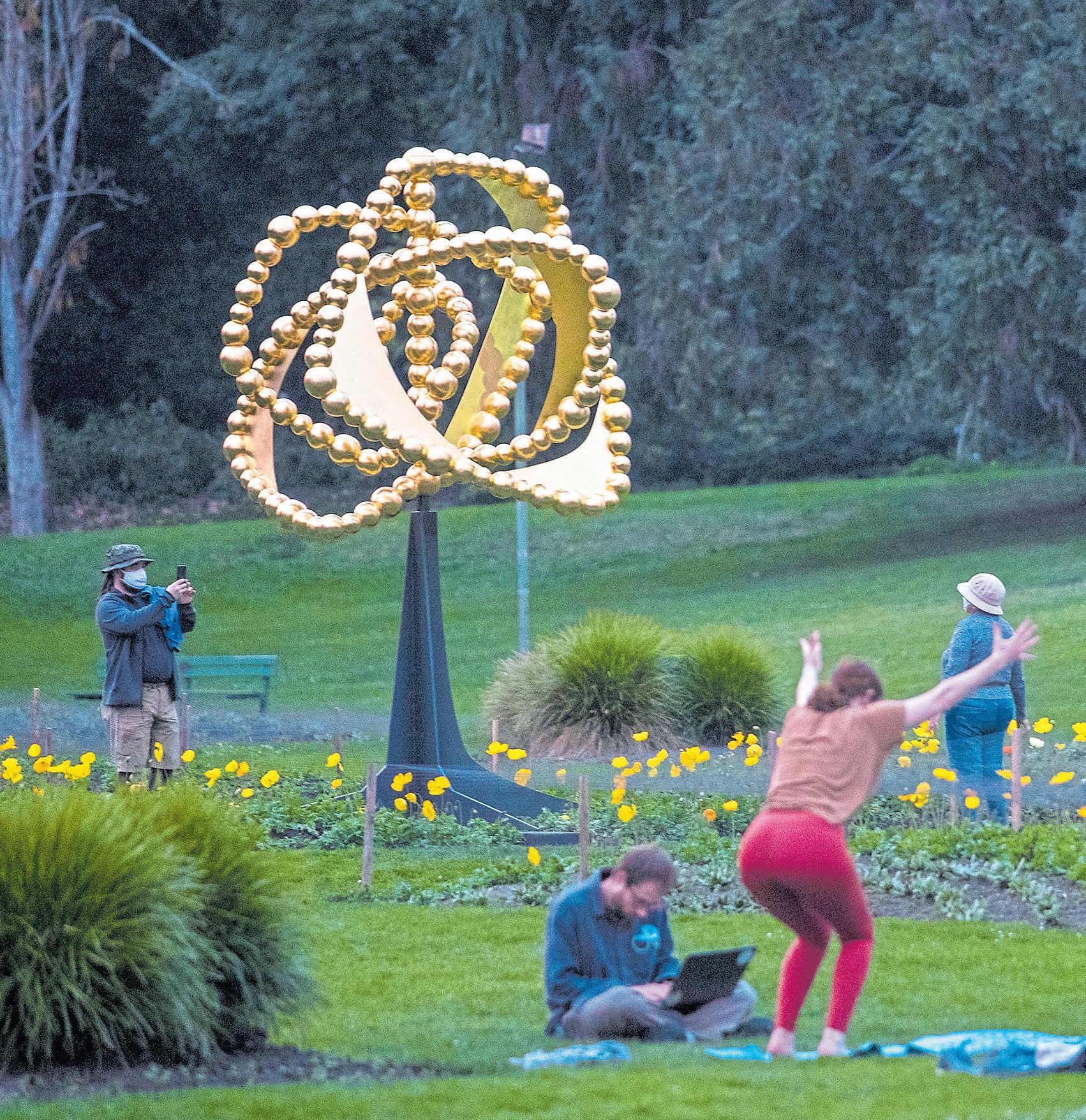
Opposite: A yoga session unfolds in San Francisco’s Golden Gate Park, where the sculpture La Rose des Vents by French artist Jean-Michel Othoniel was permanently reinstalled as part of the park’s 150th anniversary celebration. KARL
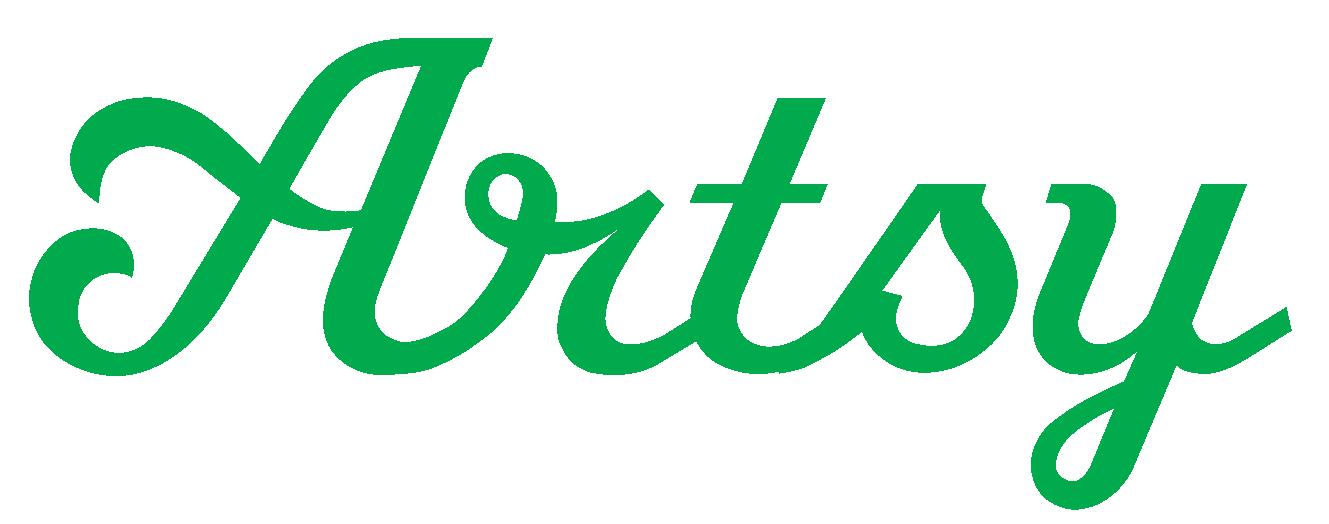
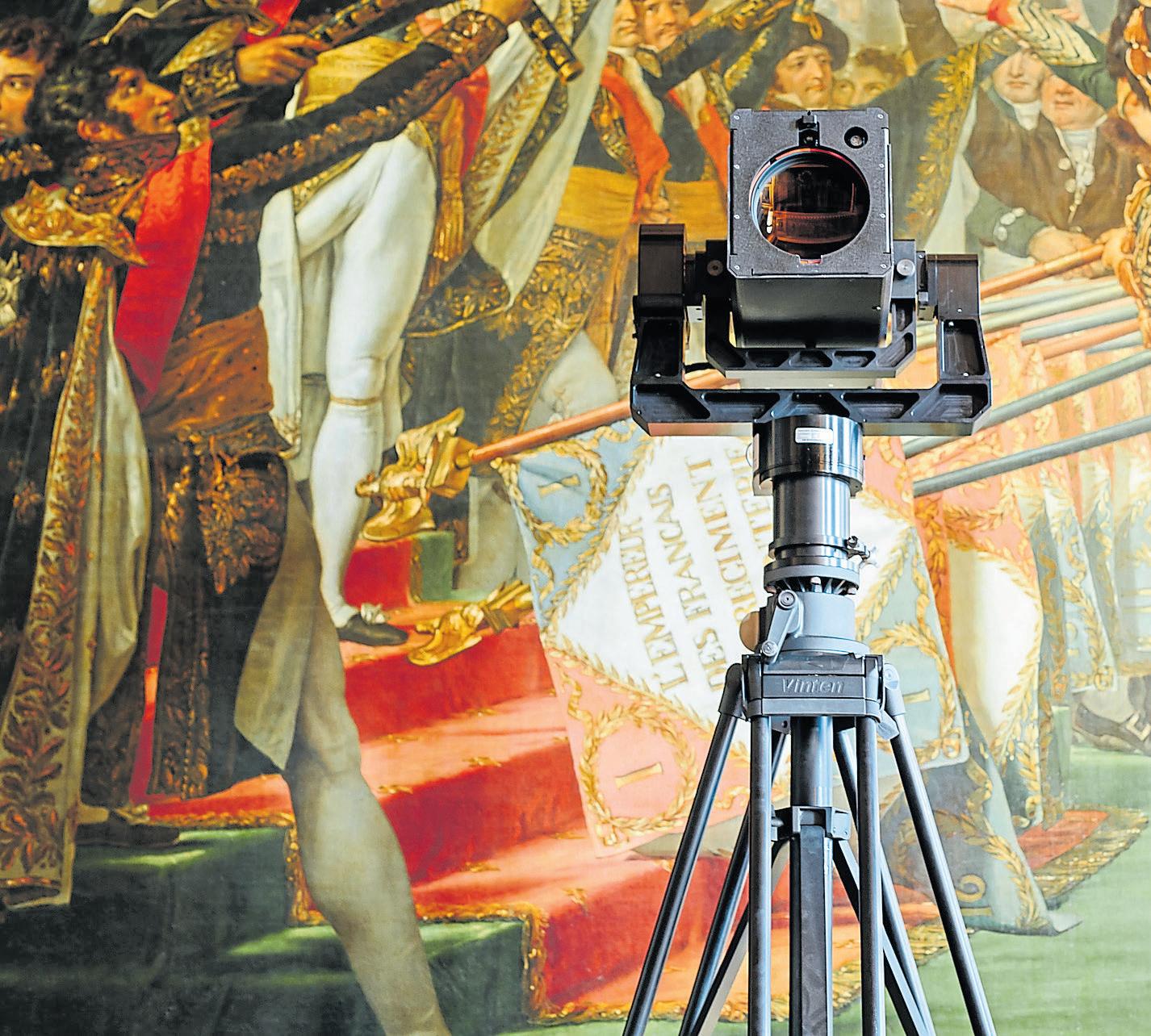

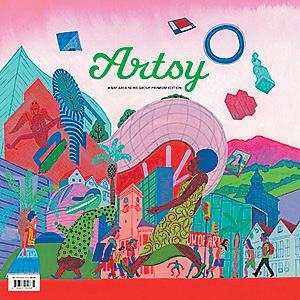


3 BAY AREA NEWS GROUP ARTSY CREDITS SECTION EDITORS Jackie Burrell Randy McMullen COVER ILLUSTRATION BY
MIGUEL PANG
MONDON/STAFF ARCHIVES DESIGN David Jack Browning Chris Gotsill PHOTO EDITING Laura Oda Doug Duran Anda Chu COPY EDITING Sue Gilmore INSIDE MOAD PAGE 12 GUERNEVILLE’S HIDDEN GEM PAGE 20 BURNING MAN ORIGAMI PAGE 36 ECLECTIC, ECCENTRIC EXHIBITS PAGE 58 Sculpture strolls Mural messages 4 Virtual museums Iconic architecture 30 38 48 EXPLORE THE BAY AREA’S VIBRANT ART SCENE
“Exomind (Deep Water),”

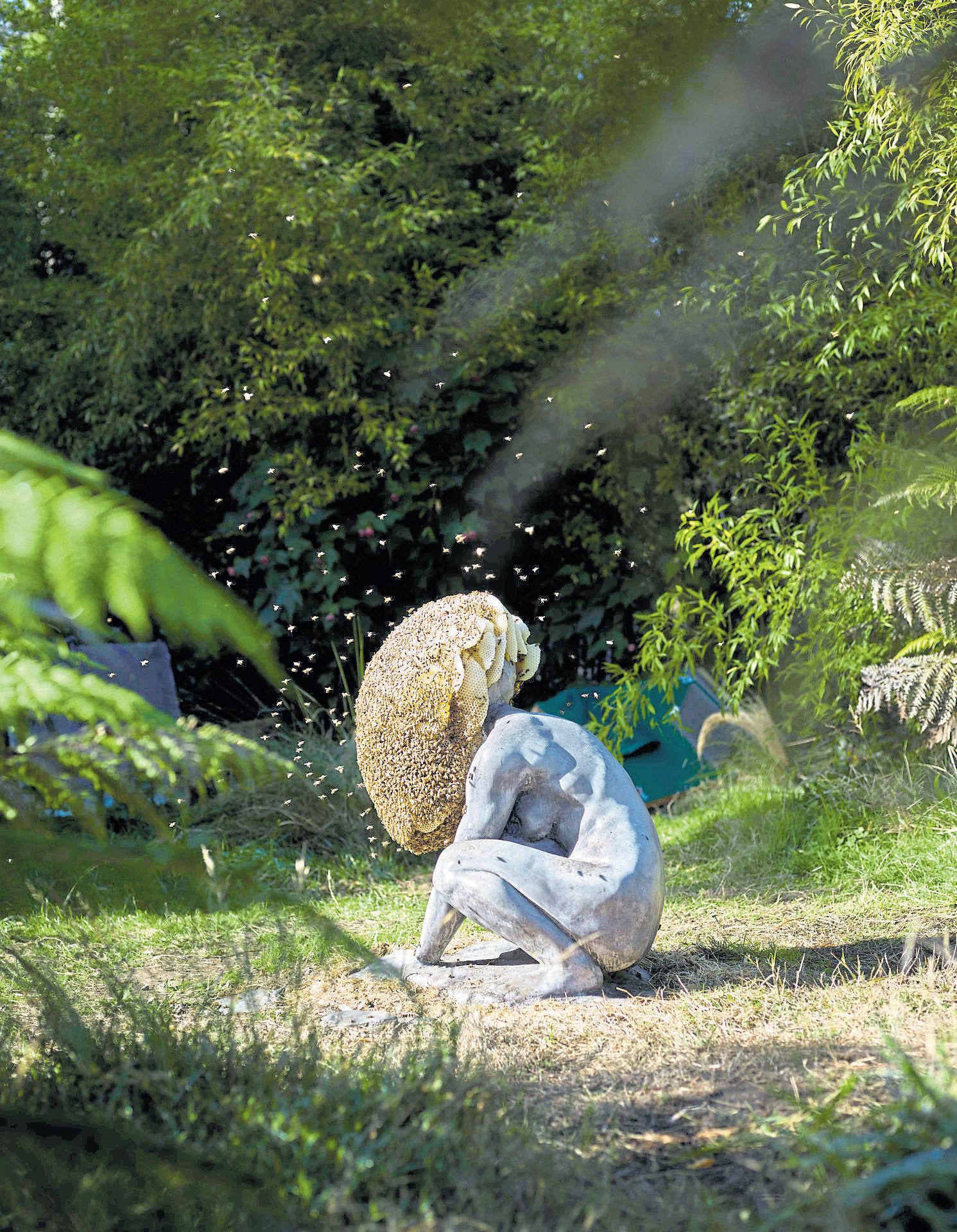
4 ARTSY BAY AREA NEWS GROUP
a Pierre Huyghe sculpture that graces the Barbro Osher Sculpture Garden at San Francisco’s de Young Museum, depicts a female figure with a head composed of a living beehive.
IMAGE COURTESY OF THE ARTIST AND FINE ARTS MUSEUMS OF SAN FRANCISCO. COURTESY RANDY DODSON
Wonder as you wander through seven amazing sculpture gardens
 BY JOHN METCALFE
BY JOHN METCALFE
Have you ever visited Golden Gate Park to see a woman with a living beehive on her head? Or toured a Sonoma winery with 200-plus acres of museum-quality artwork? These are options in the Bay Area, where gorgeous sculpture gardens abound. Here are seven great ones to explore:
Point San Pablo Harbor
Richmond
Where do Burning Man sculptures go after the party’s over? Many have a second home on a remote spit of Richmond’s coast.
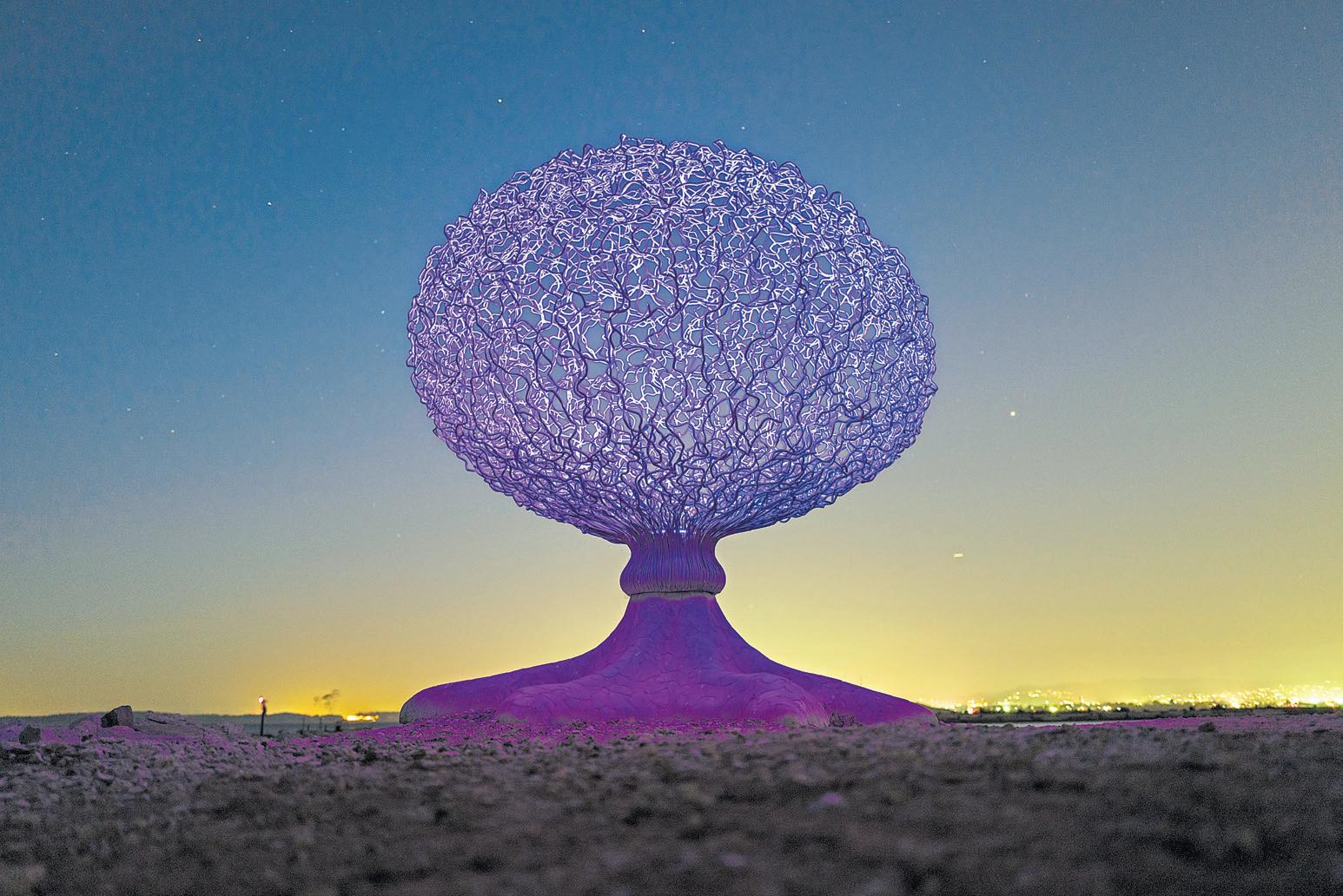
Candace Locklear in Oakland helped create We Are From Dust to get Burning Man art off the desert and into public areas. “A lot of artists we know have work stuck in old warehouses, and it’s just a shame,” she says.
At Point San Pablo Harbor, there’s an “Asterpod” womb you climb into and a tree sculpture by Kate Raudenbush transported all the way from New York. “It’s so immense, and there was nowhere to put it,” Locklear says. “So she was like, ‘I’ll give it to you!’”
Sculptures that light up at night include a glass crocodile, a huge bee and a pair of interactive cats. Everything’s meant to be physically explored.
“The cats actually purr when you touch a certain place on them,” Locklear says.”They will vibrate.”
The allure of the space is enhanced by the presence of wildly popular Black Star Pirate BBQ, plus a waterside bar with a deck and music, dancing and movies. “People come knowing they can meet like-minded people and feel comfortable,” says Locklear. “It’s become a miniature Burning Man experience.”
de Young Museum
San Francisco
For a sensorial experience, nothing much beats the Barbro Osher Sculpture Garden at San Francisco’s de Young Museum. You’re among the butterflies and vegetation of Golden Gate Park, but the art itself also seems to breathe nature.
Visitors enter James Turrell’s “Three Gems” through a tunnel that opens up into a chamber carved out of a hill. The attraction is simple but sublime: You look up at the sky through a hole in the ceiling. Sit a while, and you’ll grow to appreciate the effects weather and time have on natural light, which is subtly enhanced by hidden LEDs.
5 BAY AREA NEWS GROUP ARTSY
Berkeley-based Michael Christian’s “Asterpod,” above, is one of five large-scale artworks from Nevada’s annual Burning Man festival that have been moved to a sculpture park at Point San Pablo Harbor, north of the Richmond-San Rafael Bridge. COURTESY CANDACE LOCKLEAR
Artwork dots the grounds of the Barbro Osher Sculpture Garden at San Francisco’s de Young Museum. COURTESY HENRIK KAM
“Exomind (Deep Water)” by Pierre Huyghe is a crouching female figure whose head is turbaned with honeycomb and swarming bees. It speaks to the brain’s neural network and also climate change: If we don’t have honeybees on our minds, we could destroy the pollination apparatus sustaining our food system. The piece’s growing wax ball needs to be “trimmed” occasionally — how often can you say that about modern art?
Then there’s Zhan Wang’s “Artificial Rock.” “This sculpture alludes to the jiashanshi (artificial mountain rocks) commonly placed in Chinese gardens,” says Emma Acker, associate curator of American art at the Fine Arts Museums of San Francisco. “Wang’s shiny stainless-steel rock, which mirrors the viewer but is hollow, alludes to the emptiness of manmade simulations of nature in Beijing’s modern urban landscape.”
Other artworks include a giant safety pin by Claes Oldenburg and Coosje van Bruggen and a self-portrait/war statement by Bay Area Funk Art’s Robert Arneson. For folks who want to keep the naturalistic vibes going, there’s the Japanese Tea Garden next door, with its animal sculptures, lovingly manicured gardens and grassy matcha drinks.
The Donum Estate

Sonoma
If a world-class museum exploded, and its contents landed on the grounds of a Sonoma winery, you would have the Donum Estate. Owners Mei and Allan Warburg seeded their private collection — one of the largest in the world — with tons of terrific outdoor art, including many site-specific installations. Visitors who plop down $95 to $175 can spend a leisurely couple of hours exploring roughly 50 large-scale artworks while enjoying a tasting of wines from Carneros and the Russian River Valley. The collection showcases pieces from artists on six continents, including a convocation of Zodiac animal heads by Ai Weiwei and a lifesized lead airplane by Anselm Kiefer. There are joyfully rotund figures by Columbia’s Fernando Botero and a “Black Palm” sculpture from Douglas White made from burned car tires, a commentary on the exploitation of rubber forests. This fall, the estate is debuting an outdoor tasting pavilion designed by the firm of artist Olafur Eliasson and architect Sebastian Behmann — a dome of colored light with panoramic views of surrounding wine country.
Stanford University
Stanford
You can’t navigate Stanford’s campus without bumping into prolific public art. Perhaps most intriguing is the Papua New Guinea Sculpture Garden, with dozens of pieces reflecting traditional culture and creation myths. Anthropology grad student Jim Mason built it with artists from the Pacific country’s Sepik River region in the 1990s; the carved-wood and pumice sculptures remain a popular hangout spot for college students today.
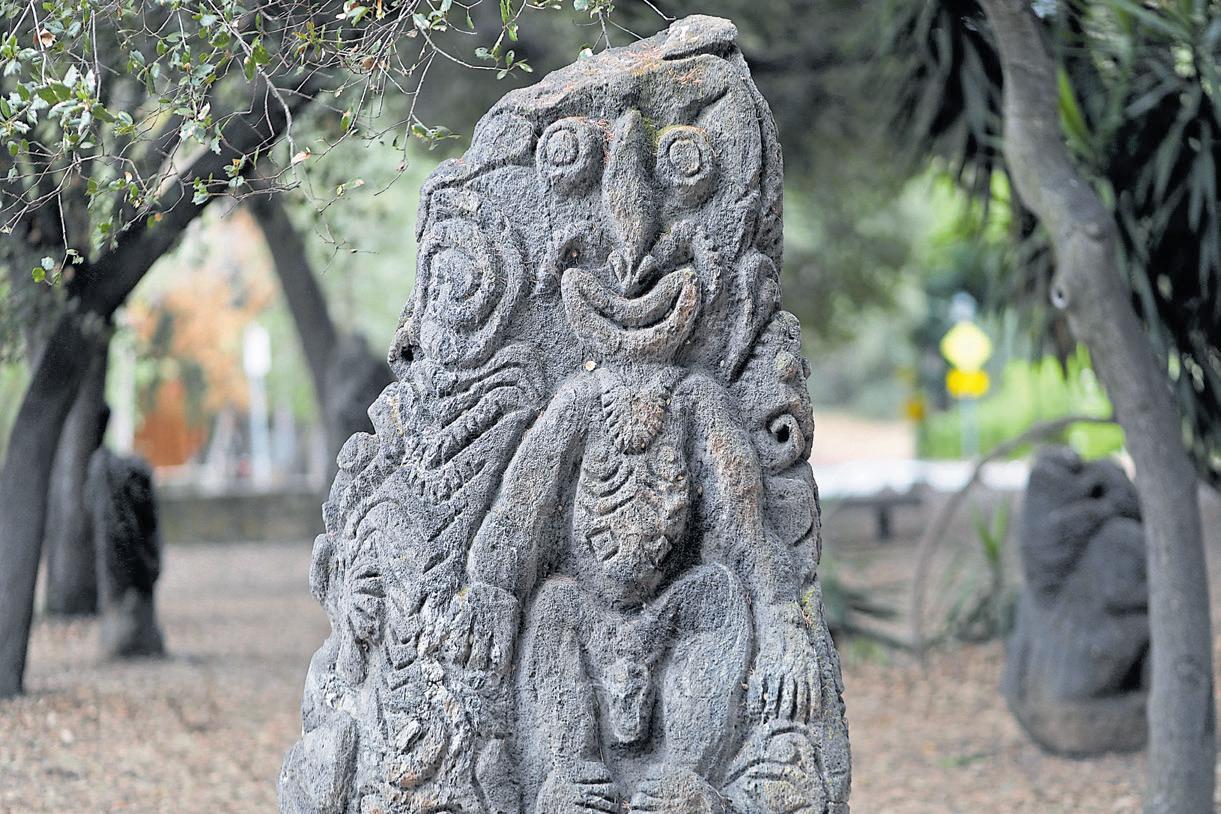
There’s a garden full of Auguste Rodin sculptures open around the clock with free tours. It celebrates, according to the university, the artist’s “relentless pursuit to convey complex emotions, diverse psychological states and pure sensuality through the nude.”
Contemporary works are always popping up, too. “Pars pro Toto” presents stone spheres, sourced from eight nations, that range from watermelon-sized to something that could flatten Indiana Jones. Artist Alicja Kwade chose their location by tossing marbles onto a model of the campus. Xu Zhen’s “Hello,” meanwhile, must have one of the most disingenuously disarming titles in the art world — the 15-foot sculpture looks like a coiled bloodworm poised to sink into the flesh of a passing student.
6 ARTSY BAY AREA NEWS GROUP
Dozens of pieces by Papua New Guinea artists are gathered in this Stanford sculpture garden. NHAT V. MEYER/STAFF ARCHIVES
Below: “Circle of Animals / Zodiac Heads” by Ai Weiwei stands in the fog at the Donum Estate in Sonoma. ANTHONY LAURINO VIA THE DONUM ESTATE
di Rosa Center for Contemporary Art
Napa
The world’s tallest filing cabinet is right here at di Rosa, rising seven stories high, thanks to artist Samuel Yates. (The drawers are full of shredded car parts — don’t ask, it’s art.)
The di Rosa center has more than a thousand similarly thought-provoking pieces scattered over 217 acres in Napa Valley. The focus is modern Northern California art with works from the 1960s onward and space devoted to up-and-coming artists, often from the Bay Area.

“Driving up to di Rosa, it is impossible to miss Mark di Suvero’s monumental sculpture ‘For Veronica,’ which was named in tribute to (art patron) Veronica di Rosa,” says Andrea Saenz, the center’s
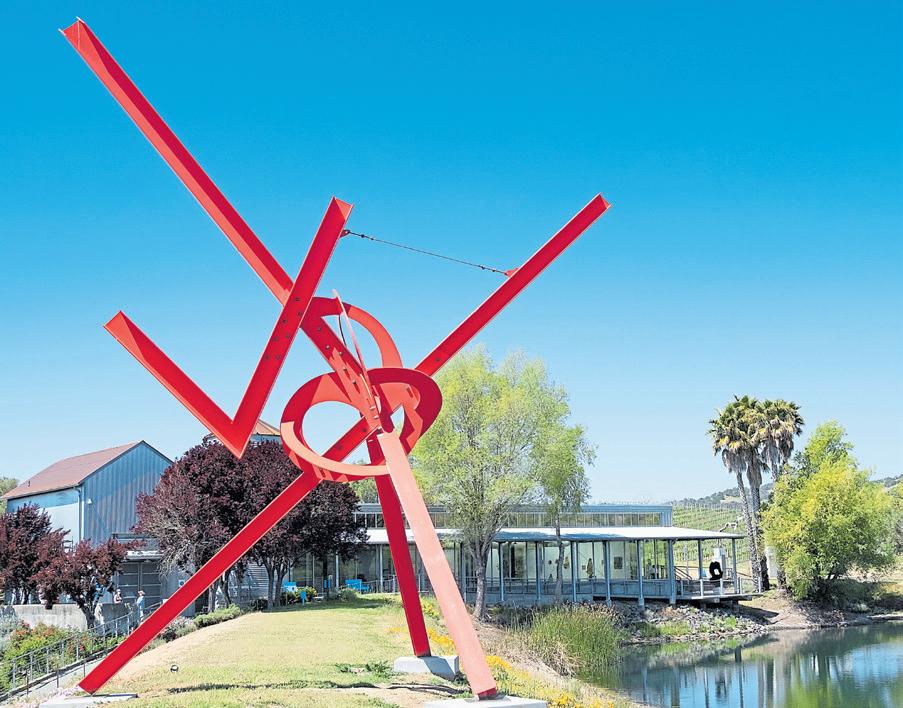
deputy director. “And I always like to point out Robert Arneson’s large ceramic bust of Viola Frey. These two sculptures speak to the friendships formed at the art park and to the collaborative spirit that remains integral to the organization today.”
There’s a herd of hands rising from the earth and a motorized angel helicoptering in the air. William Wiley’s “Gong” is a massive metal instrument that visitors pound with a wooden caber (surprisingly, the geese in the nearby lake don’t seem to mind the soul-shaking sound). There’s even more artwork on distant Milliken Peak, which can be accessed during 3-mile tours held monthly.
Appreciating the sculpture is just one thing to do at di Rosa. “There is fantastic birding, picnic areas and wonderful, rugged walking paths to enjoy,” Saenz says. “Not to mention guided hikes with sweeping vistas and a gorgeous courtyard lawn on which to lounge. The di Rosa is a terrific spot for a romantic picnic, a family get-together or a play date.”
Above: Mark di Suvero’s large-scale “For Veronica” sculpture sits on the grounds of Napa’s di Rosa Center for Contemporary Art. GRACE HENRICKS VIA DI ROSA CENTER FOR CONTEMPORARY ART
The Presidio
San Francisco
San Francisco’s Presidio isn’t just a dazzling national park with its hushed groves, slicing beams of sunlight and whale-dotted Bay views; it’s also home to one of the densest public concentrations of sculptures by famed land artist Andy Goldsworthy.
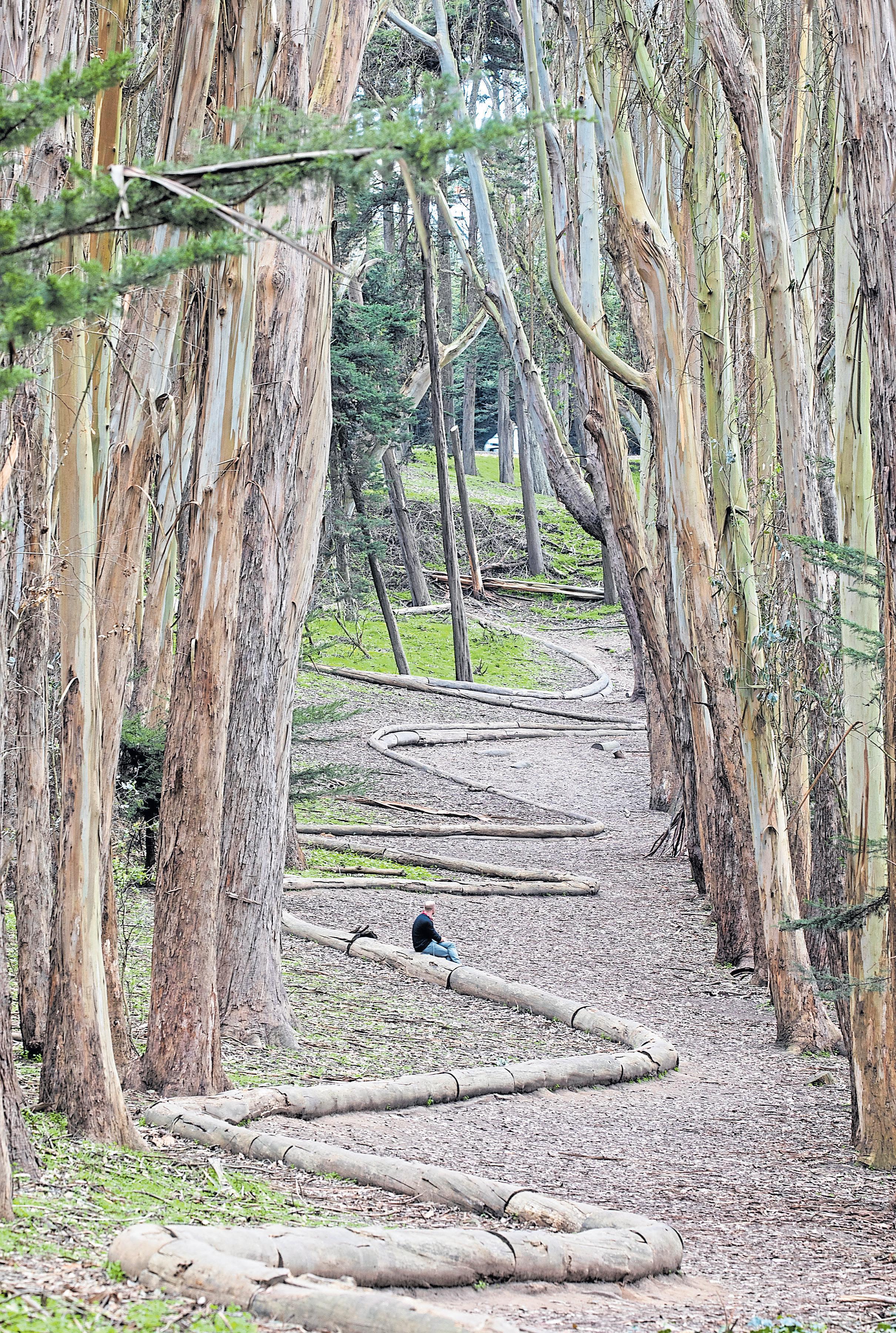
“Spire” is a 100-foot-tall monolith of cypress trunks jutting from the forest floor like a dragon’s tooth. “Wood Line” invites people to walk a path of felled trees snaking more than a thousand feet into the woods. Now that the historic Presidio Officers’ Club is open again, visitors can inspect “Earth Wall,” a sphere of twisted eucalyptus boughs buried in clay that evokes nearby archaeological research.
“Each time I go to the Presidio to check on the current condition of the works, I’m typically met with something quite surprising,” says Cheryl Haines, executive director of the FOR-SITE Foundation that worked with the park on Goldsworthy’s sculptures.
“Often, I would go to ‘Wood Line’ and see groups of small children having a picnic or witness local adolescents building their own spires in homage to Goldsworthy,” she says. “I was even asked by a friend and colleague to perform a marriage ceremony at ‘Spire,’ which we did quite quickly and privately — it was really magical.”
8 ARTSY BAY AREA NEWS GROUP
A lone hiker contemplates Andy Goldsworthy’s “Wood Line” installation at the Presidio of San Francisco.
KARL MONDON/STAFF ARCHIVES
Montalvo Arts Center Saratoga
In the foothills above Saratoga lies historic Montalvo, with gardens designed by John McLaren of Golden Gate Park fame. A lot of the classical statuary you’ll encounter comes from the collection of James Phelan, the U.S. senator and San Francisco mayor who once lived here. (Check out the three busts he commissioned from famed sculptor Gertrude Boyle Kanno that line the center’s Poet’s Walk.)
Montalvo is also home to the Sally and Don Lucas Artists Program, which commissions an annual lineup of new artwork to show off at a summer festival. This year’s fest, “Claiming Space: Refiguring the Body in Landscape,” just opened, and it explores what it means to have our bodies feel safe and represented in public. (It’s especially relevant at this location, given that Phelan campaigned in 1920 on the startling slogan, “Keep California White.”)
With 175 acres of manicured grounds and hiking trails, there’s always something new and surprising to uncover. Visitors might accidentally see themselves in Ali Naschke-Messing’s “From Within, So Without,” a bunya pine tree with crevices filled with mirrors. And sometimes, a hike becomes the art. Susan O’Malley’s “A Healing Walk” is a 20-minute jaunt that the artist has augmented with directional and affirmational signs like “You look up,” say, or “You are here awake and alive.”
IF YOU GO
Point San Pablo Harbor: Open daily at 1900 Stenmark Drive, Richmond; pspharbor.com. Black Star Pirate BBQ opens at 11 a.m. Friday-Sunday.
de Young museum: Opens at 9:30 a.m. Tuesday-Sunday at 50 Hagiwara Tea Garden Drive, San Francisco; find ticket information at deyoung.famsf.org.
Papua New Guinea Sculpture Garden: Open daily at 476 Lomita Drive on Stanford’s campus; arts.stanford.edu.
The Donum Estate: Open by reservation only with a tasting; 24500 Ramal Road, Sonoma; thedonumestate.com.
The Presidio: Open daily at 1750 Lincoln Blvd., San Francisco; presidio.gov.
di Rosa Center for Contemporary Art: Opens at 11 a.m. Friday-Sunday (or by appointment Tuesday-Thursday) at 5200 Highway 12, Napa; dirosaart.org.
Montalvo Arts Center: Open daily with free admission at 15400 Montalvo Road, Saratoga; montalvoarts.org.

9 BAY AREA NEWS GROUP ARTSY
FLYING STUDIO LOS ANGELES
Right: A 2021 piece by Hank Willis Thomas, “Strike,” sits in the historic grounds of the Montalvo Arts Center in Saratoga.
Christopher Kesel’s artistry and his creative eye help set the stage for opera’s ‘theater of the mind’
BY DAVID JOHN CHAVEZ
Christopher Kesel considers himself a rocker, a man with a deeper connection to Pink Floyd than Giuseppe Verdi. But as he crafted his career over the years, Kesel learned there’s one important difference between classic rock and opera:
Puccini pays the bills. There are many ways to be an artist. You can paint. You can sculpt. Or you can do what Kesel does. Opera San José’s scene shop supervisor and properties artisan paints, sculpts and helps craft the elaborate world — the palazzos of Tosca’s Rome and the garrets of Mimi’s bohemian Paris — that bring an opera to life. And he works alongside his wife, Lori Scheper-Kesel, who has been the company’s properties master and scenic charge artist for more than a decade.
Kesel came to California in 1999 from upstate New York, following his wife as she worked at Shakespeare Santa Cruz’s summer festivals as a props mistress. Their shared artistic talents and his knowledge of carpentry contributed to a variety of Bay Area productions over those summers and eventually landed them at the now-defunct San Jose Repertory Theatre. It was there that the duo’s work caught the eye of legendary Opera San José founder Irene Dalis, who wooed them to the world of Figaro and Falstaff in 2010 or so. They’ve been there ever since.
QWhen it comes to scenic design and props construction, what are the biggest differences between
theater and opera?
AThey’re pushing different buttons. In theater, you might create the illusion of being in a living room or a bar or something like that. In a repertory theater, you would be down to the very last detail — sockets in the walls or a kitchen with functioning appliances, that sort of thing. Opera is much more open and requires more theater of the mind. For example, in opera, you might be in a cathedral — obviously we can’t re-create that, so we imply a cathedral. In opera, you’re giving people visual cues to imply where you are. You can create illusions with drops and flats and some three-dimensional pieces, as well as lighting. I really love that part of opera.
QWhich fits your skill set better?
Opposite: The Archangel Michael, a prop for an Opera San Jose production of “Tosca,” surveys its maker, opera company artisan Chris Kesel.
Right: Color tables and prop notes adorn a workstation inside the opera company’s workshop in San Jose.
 DAI SUGANO/STAFF
DAI SUGANO/STAFF
Opera San José — she came after us. It was a difficult transition for us to move into opera, and she made it very easy. She and (former general director) Larry Hancock were big supporters of our work.
Q You and your wife have a deep connection in the work you both do. What makes the working relationship between you so strong?
to opera, I pretty much followed her there, because working alone wasn’t much fun.
QYou’re a rocker, I know. Do you actually like opera?
A
The things that I’m good at fit opera much better. My style as an artist is a bit more flamboyant — and I like doing things that are a little bigger.
Q Can you tell us about working with Irene Dalis?
A
She was the main reason my wife and I began working at
A
We met back in the 1980s at art school, so our main attraction to each other was basically artistic. We’re very connected — we’ve grown up and matured together as artists, so we work pretty good as a team. It’s not always rainbows and waterfalls, you know what I mean? (But) when she moved over
AI appreciate opera, but I don’t listen to it in my spare time. I do love the live experience of opera. The singers and what they do, the musicians and everything — I can’t do that. I can’t play an instrument. I can’t sing. To me, it’s like a magic trick, and I appreciate it like that. It’s really sublime how older material is reprocessed and revealed through a modern eye, and something else a little different comes out every time.
Opera San Jose’s 39th season opens on Sept. 10 with Mozart’s “The Marriage of Figaro.” Learn more at www.operasj.org.
10 ARTSY BAY AREA NEWS GROUP
Q&A


DAUNTLESS ‘TRAUMANAUTS’ TRIUMPH AT MoAD, DESPITE DISEASE, A DELUGE AND DELAYS
STORY BY MARISA KENDALL
ILLUSTRATION BY ALOIS MARIGNANE
They’ve played basketball in outer space, helped in New Orleans in the aftermath of Hurricane Katrina and most recently, spent an anxiety-ridden two years in storage, thanks to COVID and other unforeseen delays. Now, Oakland artist David Huffman’s “Traumanauts” — a gaggle of adventure-seeking astronauts — has landed in a gallery near you.
Huffman’s exhibition, “Terra Incognita,” runs through Sept. 18 at San Francisco’s Museum of the African Diaspora, which is located in the city’s museum quarter South of Market, near the Museum of Modern Art and Contemporary Jewish Museum. Huffman’s show, which touches on the themes of Black identity, trauma and the longing for somewhere to call home, is full of robots, spaceships and other images from Afrofuturism. But Bay Area viewers will also see more familiar scenes, such as cars doing doughnuts and other tricks
during an Oakland sideshow.
The exhibit is Huffman’s largest to date — and it almost didn’t happen.
Even at the best of times, staging a major exhibit isn’t simply a matter of hanging art on walls — and these weren’t even the middling-est of times. So how did it all come together? The MoAD staff gave us a behind-thescenes look at what it takes to pull together a museum show during a global pandemic.
One of the masterminds behind the show, curator Elena Gross, had been interested in hosting a Huffman exhibit for some time.
“He’s an artist who’s had a very long career here in the Bay Area, but most of the work that he’s known for is abstraction,” she said. “There has been less attention paid to his Traumanaut series... It’s such a very interesting, nonlinear narrative around these characters and these ideas that have had a prevalence in David’s practice for a long time.”
She started working on the project in 2019, with the goal of opening the show in March 2020 — so you can guess what some of the challenges involved. But let’s start in 2019: Gross and co-curator Emily Kuhlmann began the process with countless
After a two-year delay, Oakland artist David Huffman’s “Terra Incognita” show has opened at San Francisco’s Museum of the African Diaspora at last.
 FRANCIS BAKER
FRANCIS BAKER
13 BAY AREA NEWS GROUP ARTSY

14 ARTSY BAY AREA NEWS GROUP
conversations with Huffman about his work and how it would be displayed. They visited his studio and began picking out the pieces they wanted to use for the exhibit, so the art could be packed up by a professional shipping company and trucked over to the museum.
The curators wrote the blurbs that hang on the wall beside each work of art, as well as the larger introductory paragraphs at the entrance to the show. And they had the walls of the gallery painted a pale, mint green. It’s a color Huffman calls “Oakland green,” because as a child, he saw it frequently when he visited other people’s homes in Oakland.


To nail down the exhibit layout, Gross and Kuhlmann took iPhone photos of the art and plugged them into a computer program alongside the gallery floor plan. When deciding on placements, they had to think about the story
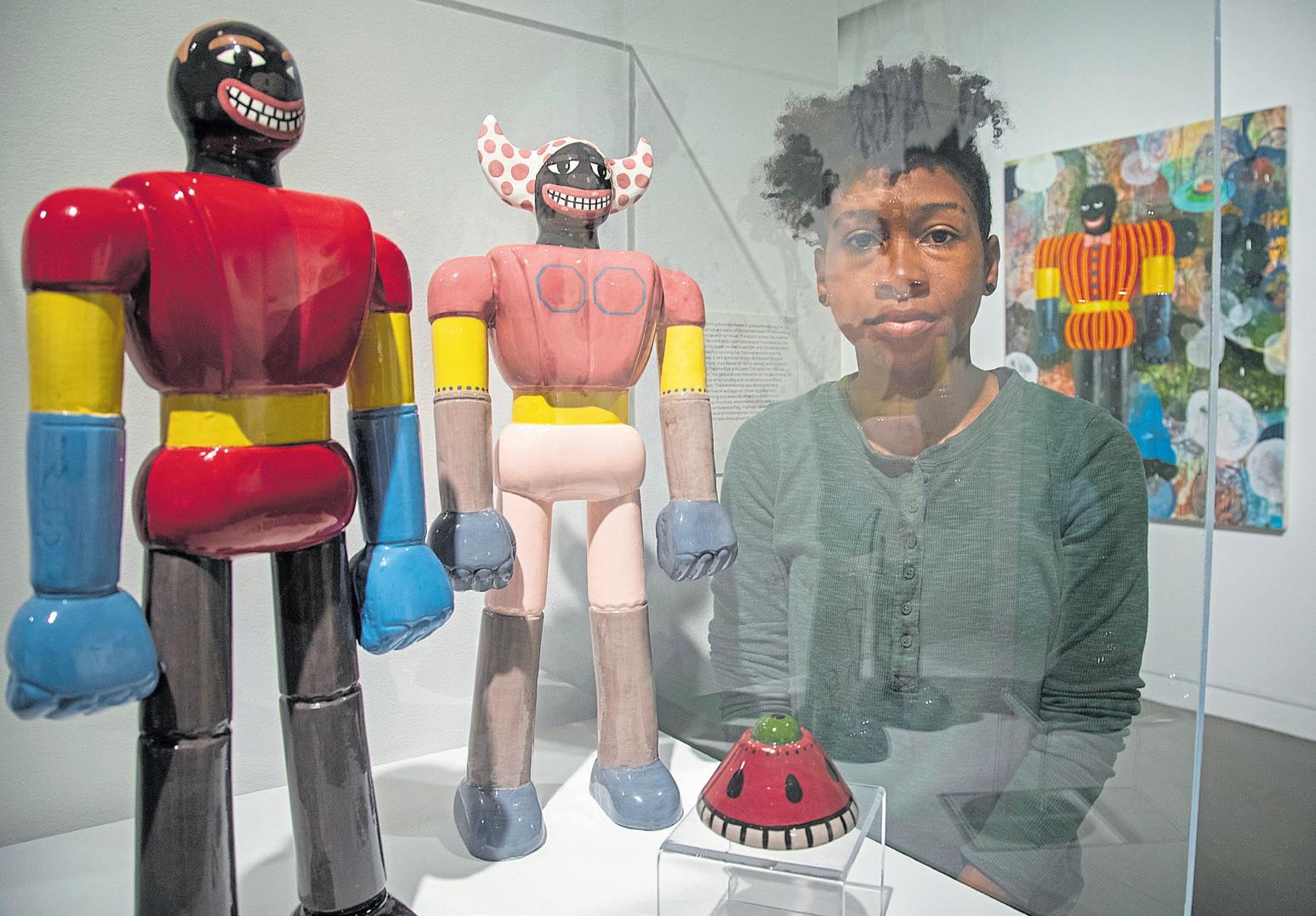
15 BAY AREA NEWS GROUP ARTSY
Left: David Huffman’s “Hoop Dreams” hangs in the “Terra Incognita” exhibit at the Museum of the African Diaspora in San Francisco.
KARL MONDON/STAFF
Elena Gross of the Museum of the African Diaspora, discusses David Huffman’s 2009 acrylic “Sideshow,” part of the “Terra Incognita” exhibit on display in San Francisco. KARL MONDON/STAFF
Elena Gross of the Museum of the African Diaspora stands by a display of David Huffman’s ceramic figures, part of the “Terra Incognita” show that she co-curated in San Francisco.
“It’s such a very interesting, nonlinear narrative around these characters and these ideas that have had a prevalence in David’s practice for a long time.”
Curator Elena Gross, about Oakland artist
David
Huffman’s Traumanaut series
they wanted to tell, and how each piece fit together. Some of Huffman’s larger, more recognized works would get a wall all to themselves at the front of the show. Deeper into the exhibit, multiple smaller paintings would fill a wall practically floor to ceiling in what’s known as a “salon-style hang.”
The curators made sure to give Huffman’s “Sideshow” a prominent place of honor. The 2009 painting shows Traumanauts joy riding and spinning doughnuts in a parking lot, leaving plumes of
smoke and spiraling skid marks in their wake.
To Huffman, the piece raises the question of why a practice that has become something of a cultural icon in Oakland is still relegated to the fringes of society.
“They have not created spaces for them to compete or safe places for them to do it,” he said. “It’s still a very dangerous thing, because people are doing it in neighborhoods and blocking freeways, just the craziest stuff.”
The curators had already installed one of the exhibit’s largest,
most important works — Huffman’s painting of Traumanauts in a flooded New Orleans — when news of a possible pandemic began spreading.
Then COVID hit. The world shut down, and Huffman’s art went back into storage.
“For a long time, just given the unknowability of everything that was happening in the world, it was really unclear as to whether or not the show would go away altogether,” said Gross, who has worked for MoAD for three years.
The museum had reinstalled
the show in late 2020, with the hope of opening it in early 2021, when another disaster struck. A leak upstairs in the St. Regis hotel sent water flooding through the museum ceiling — a development Gross called “devastating and disappointing.”
“I thought, ‘Oh, the work all got damaged,’” Huffman said. “That’s what I was thinking.”
Somehow, his work was spared. Only one piece got wet — a lifesized spacesuit Huffman had fashioned as a Traumanaut costume — but it was made of canvas, so the

16 ARTSY BAY AREA NEWS GROUP
A permanent montage display of sepia-toned portraits greets visitors to the Museum of the African Diaspora in San Francisco.
KARL MONDON/STAFF
moisture didn’t harm it. Even so, the museum had to spend months repairing the building.
On March 31, two years after its original opening date, the exhibit finally opened to the public — no more delays, no more disasters, just art showcased against walls painted a luminous Oakland green.

The show’s stars include “Luxor DX” and “TraumaEve,” small ceramic statues of robots with wide, leering grins. The smiles are inspired by racist portrayals of Black people throughout history — such as in Blackface minstrel shows — where big, happy grins masked the trauma Black people were actually experiencing. Huffman, who is inspired by sci-fi and anime, used his robots to take back that racist trope. His grinning robots are, in a word, badass — TraumaEve can fly and shoot her fists at bad guys.
“They’re both symbols of empowering Black bodies,” Huffman said.
Huffman hopes that the show, which features work that dates all the way back to the ’90s, will help people recognize him as one of the early pioneers of Afrofuturism.
What else does he want?
“Hopefully, that people enjoy it,” he said. “That they find something compelling.”
THE MUSEUM OF THE AFRICAN DIASPORA
“Terra Incognita” is one of four exhibits currently on display at MoAD. The museum is open from 11 a.m. to 6 p.m. WednesdaySaturday and noon to 5 p.m. Sunday at 685 Mission St. in San Francisco. General admission is $12, with $6 tickets available for seniors, students and teachers. Kids under 12 are free. Find more details at www.moadsf.org.
17 BAY AREA NEWS GROUP ARTSY
Pedestrians walk past the Museum of the African Diaspora on Mission Street in downtown San Francisco.
KARL MONDON/STAFF
San Jose Museum of Art curator’s mission: Tell revealing stories, connect communities
BY JIM HARRINGTON
The San Jose Museum of Art is not just for “art” people, says Lauren Schell Dickens. It’s for all kinds of people, including families with small kids and those who don’t normally visit museums at all.
“Everyone comes from a different place and engages with art differently,” the museum’s senior curator says.
We recently had the chance to learn more about this San Jose native, who grew up in Sonoma County and now calls Oakland home.
QHow did you get interested in art museums?
A I always liked making art but don’t recall being very interested in museums as a kid. It wasn’t until college, when I realized that a museum experience is more than just looking at paintings.
I studied theatrical light design in college, and that training in thinking about lights, staging and the experience of seeing a painting are all part of how the story of an art object is told. It’s how art can be used to tell stories that really hooked me.
QWhat is it about visual art that captivates your attention?
AI love all kinds of art — music, dance, theater, literature — and many of the artists presented at SJMA work in sound, movement, text, as well as visually.
Great art operates on a register that logic or reason or language cannot touch. It can pull me in with beauty and then reveal or show me something about the world, about people and experiences around me that I hadn’t thought of or paid attention to before.
QWhat are the most challenging aspects of your job? What are the most fun?
AThe most challenging aspect of my job is also the most fun — I get to work with artists!
Artists play such an important role in society — giving us new perspectives on the world and imagining possibilities for how we can inhabit this Earth together in ways that are better than what we’re doing now. And they have wild, world-changing ideas. But artists dream big — as they should — and managing logistics and expectations of the many players involved can be challenging.
It can also be challenging to get audiences to slow down. Some people want to look at a sculpture and “get it” right away, but understanding, engaging takes time.
QWhat was it like working at SJMA during the pandemic?
DICKENS’ FAVORITE BAY AREA MUSEUMS
Headlands Center for the Arts: During public open studios, people can chat with residing artists and see works in progress at this Marin Headlands (art hub) — and the food in the mess is great; www.headlands.org.
Japanese American Museum of San Jose: A fascinating museum of objects and stories that focuses on the impact of Executive Order 9066 (creating Japanese American internment camps during World War II); www.jamsj.org.
Legion of Honor: The San Francisco setting is unbeatable, and I love the ornate intimacy of the building. They have a wonderful series of installations by contemporary artists that really challenge the history of the place. https://legionofhonor. famsf.org
MACLA: This Chicano/Latino contemporary arts center is not exactly a museum, but they show great art and always have fun events. And you can walk from SJMA! https://maclaarte.org
Children’s Discovery Museum of San Jose: My kids never want to leave this place. www.cdm.org
AThe pandemic was certainly challenging. We had a fantastic exhibition on view that looked at art and prisons called “Barring Freedom,” which was only open to the public for nine days. It’s sort of heartbreaking, for us and the artists, when so much work goes into a project that the public doesn’t get to experience.
But we had time to pause during the pandemic and really look at ourselves, what we’d been doing well that we wanted to do more of and what wasn’t working.
QWhat is the museum’s mission — and what is your role in that?
ASJMA is about nurturing community through contemporary art, highlighting stories of our various communities and following artists’ lead in engaging socially relevant topics like prisons, climate crisis, immigration and identity through art.
My job is to identify artists and artworks, both locally and from around the world, that resonate with the lived realities of our South Bay audiences. The hope is that someone visiting the museum sees their own story — their history or dreams or community or concerns — reflected in the artworks.
We want visitors to not only feel connected to their geographic neighbors, but build solidarities with communities around the world.
DAI SUGANO/STAFF
18 ARTSY BAY AREA NEWS GROUP Q&A
It’s the ability of art to tell stories that entrances Lauren Schell Dickens, senior curator at the
San Jose Museum of Art.


Sonoma County’s legendary Pond Farm is both the artistic and lifestyle legacy of famed potter Marguerite Wildenhain

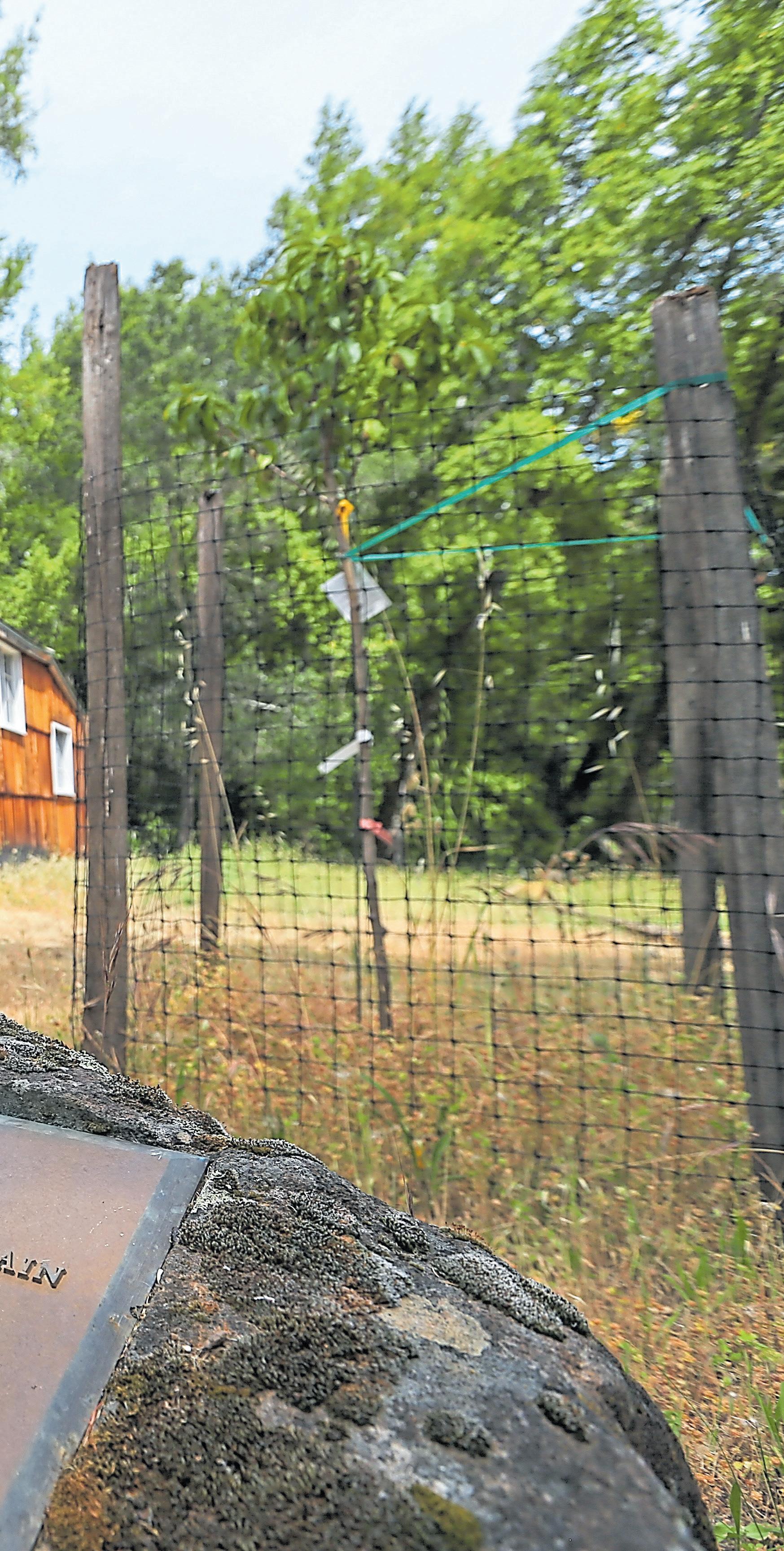 STORY BY MARTHA ROSS
PHOTOS BY RAY CHAVEZ
STORY BY MARTHA ROSS
PHOTOS BY RAY CHAVEZ
21 BAY AREA NEWS GROUP ARTSY
Above: Ceramic items displayed at Pond Farm offer a glimpse of the pottery school’s purpose.
Left: A plaque dedicated to Marguerite Wildenhain marks the entrance to the renowned ceramic artist’s Pond Farm pottery studio.
Each summer, the 20 students of world-renowned master potter Marguerite Wildenhain sat at their kick wheels in a converted barn at her Pond Farm Pottery throwing one pot after another — eight hours a day, every day for nine weeks.
From her Bauhaus training, the French-born, German-reared artist believed that rigorous practice and technical mastery were necessary to help artists “think less and feel more.” The students eagerly waited for the exacting Marguerite to inspect their work and tell them they had finally mastered one style of pot and could move on to the next. She usually didn’t tell them what they wanted to hear.
Gerald Scoggins, a high school teacher who studied at Marguerite’s artists community near Guerneville in 1975, wrote about how his teacher, then close to 80, dismissed his handiwork in her clipped accent, saying, “They aren’t very elegant, are they?”
But like many other Pond Farmers, Scoggins said his nine weeks with Marguerite “changed my life.” Others said she held such high standards because to her, making a pot wasn’t just about making a pot. The process, she said, involved “synthesis of technical knowledge and spiritual content” which could lead to truth, beauty and “a more human way of life.”
In the world of famous Bay Area artists, Marguerite Wildenhain stands out, mainly because she chose to identify her life and art so closely with the rigorous workshops she ran at the utopian artists community she co-founded in the late 1940s on a grassy slope near Sonoma County’s Armstrong Redwoods State Natural Preserve.
Bay Area ceramics lovers will soon have a chance to learn more about this pioneering female artist and tour the pottery. The Stewards of the Coast and Redwoods, the nonprofit that operates Pond Farm, is welcoming back visitors with docent-led tours, artist-in-residence fellowships and other programs. The reopening of Pond Farm, which is seeking National Historic Landmark status,

22 ARTSY BAY AREA NEWS GROUP
Top left: Marguerite Wildenhain, center, gathers with her Pond Farm ceramics students in this undated historic photograph.
COURTESY DAVID STONE AND STEWARDS OF THE COAST AND REDWOODS
Bottom left: Ceramic pieces were processed in this kiln at Pond Farm.
comes after two challenging years that included both the COVID pandemic and the devastating 2020 Walbridge wildfire.
Overcoming challenges would be familiar territory for Marguerite. Born to Jewish parents, she survived World War I, twice fled the threat of Nazi persecution and endured several tragedies in her early years at Pond Farm.
She lived and worked at Pond Farm for more than 40 years before her death in 1985. There, she wrote books, drew and made her acclaimed earth-colored vases and teapots, decorated with designs and textures inspired by nature. But she is revered by former students for the way she demonstrated living with “integrity, simplicity and beauty.” Her example, students say, helped them to become better human beings, regardless of whether they pursued careers as artists.
Marguerite once said that Pond Farm wasn’t a school, but “a way of life.” Living in nature was key. She gathered students for readings on poetry, philosophy or science under the peach tree near the barn. She organized picnics at beaches along the Sonoma coast, and on moonlit evenings, she’d invite some of them to join her for sherry and conversation on her cottage patio, surrounded by the sounds of the forest.
Marguerite first started workshops at Pond Farm in 1949 in collaboration with Gordon Herr, a San Francisco architect, and his heiress wife, Jane. Idealistic and committed to a “back-to-the-land ethos, the Herrs had purchased the 160-acre property in the 1930s. They recruited Marguerite to help them establish a “sustainable sanctuary for artists away from a world gone amok.”
Born in 1896, Marguerite came of age before the world went haywire. She felt an early calling to become an artist, a profession that was outside the norm for women of her social class. She took the plunge in 1919, signing up to study ceramics with the experimental Bauhaus school.
These days, the Bauhaus is associated with the sleek, modernist aesthetics of mid-20th century architecture. But the movement also encompassed progressive and avant-garde views about art and
Top right: Docent Charlotte Chavez demonstrates how to make ceramic figures on a pottery wheel at the pottery studio and school.
Bottom right: Today, docents such as Natalie Robb-Wilder lead guided tours of Pond Farm, the pottery studio and school of renowned ceramic artist and potter Marguerite Wildenhain.
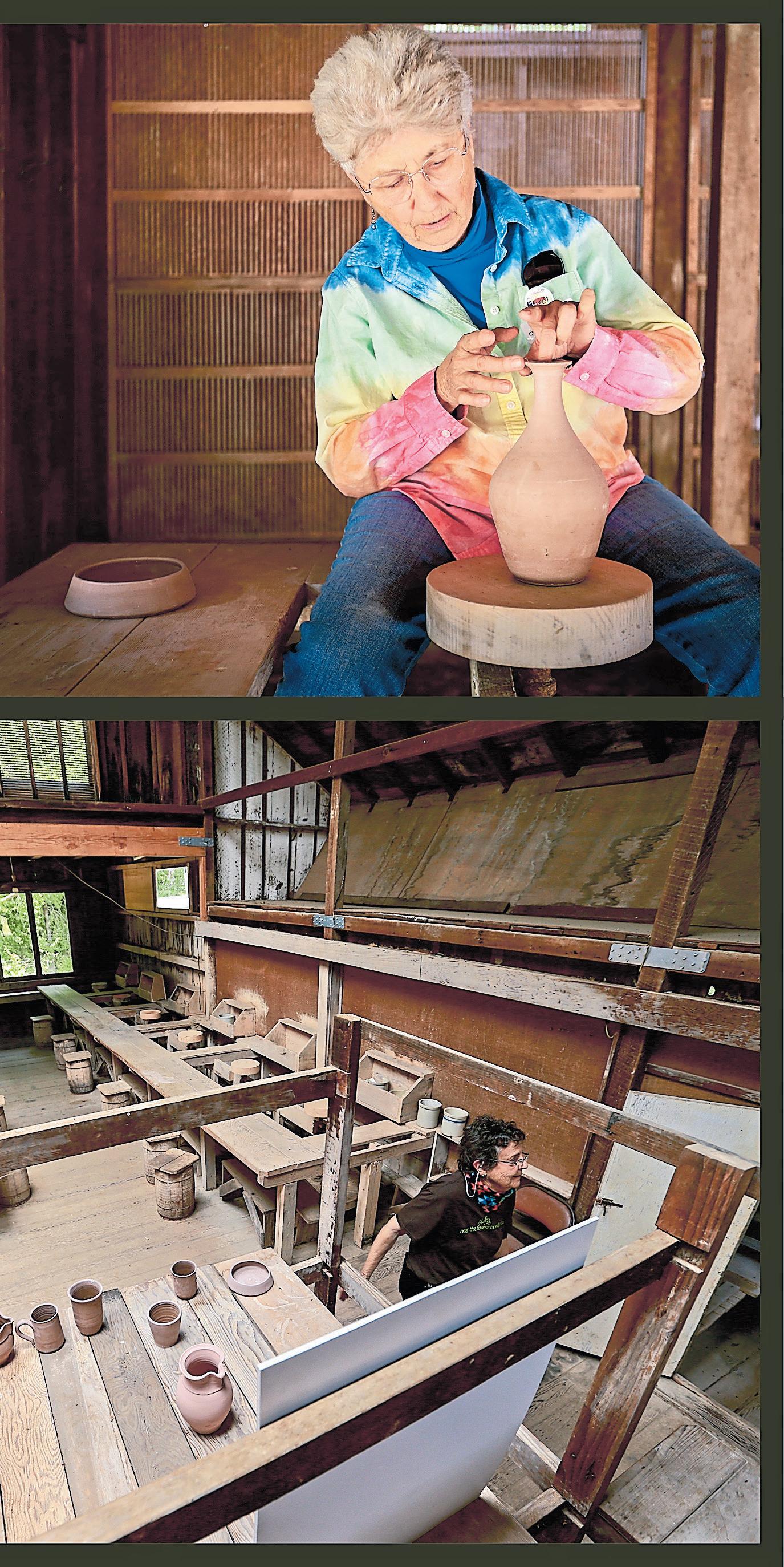
society. Marguerite flourished in that environment.
Days involved hard physical work, spartan living conditions, shared resources and intense learning with master artists. But free time was spent in the company of fellow students and master artists, like the painters Paul Klee and Wassily Kandinsky, talking, listening to music or dancing into the night.
“Work and life were a marvelous unity,” Marguerite wrote in her book, “The Invisible Core.”
“Though work was strenuous, in the evenings, we still found time and (energy) for exciting and stimulating talks about any subject that would interest us.”
By 1926, Marguerite’s technical brilliance earned her a rare distinction for a female artist: She was named a master potter. She scored a university job and enjoyed commercial success with the simple, everyday dishes she made for the Berlin State Porcelain Factory, In 1930, she married fellow Bauhaus-trained potter and sculptor Frans Wildenhain.
But Hitler’s rise to power brought a crackdown on anyone opposed to his party’s hard-right ideology. As a Jew, Marguerite was given 24 hours to leave her university job. Over the next decade, many Bauhaus members, including founder Walter Gropius, went into exile in the United States and elsewhere. A few who stayed in Europe lost their lives in concentration camps.
Marguerite and Frans found temporary refuge in the Netherlands. That’s where they met Gordon Herr. He was touring Europe, recruiting refugee Jewish artists to join him and his wife in setting up their artists colony in rural Sonoma County.
Marguerite took the Herrs up on their offer, when Germany invaded the Netherlands. Marguerite’s French passport allowed her to secure passage on the last boat leaving that country, Unfortunately, Frans, a non-Jewish German citizen, couldn’t leave. He was conscripted into the German army but later deserted, went into hiding and joined the resistance. Marguerite wouldn’t see her husband for the next seven years.
But she carried on. As Gerhard Marks, one of her Bauhaus
23 BAY AREA NEWS GROUP ARTSY
teachers, said, “She really had the mental and physical strength of three men.”
After arriving in the Bay Area, Marguerite joined the Herrs at Pond Farm in 1942. She initially camped in the woods while helping Gordon convert a 19th century livestock barn into a studio. She also became part of the Herrs’ extended family, helping to raise the couple’s three children, daughter Gail and sons Jan and Jonathan.
For basic needs, the residents at Pond Farm relied on a water pump and finicky generator. For many, including a young girl like Gail (who grew up to become the late Alameda County Supervisor Gail Steele), life at Pond Farm was hard and isolating.
Marguerite, on the other hand, found this solitude comforting after what she had experienced in Europe. “We are living so peacefully, and furthermore, nature is there, and that is a lot, because it is genuine and doesn’t betray one,” Marguerite wrote at the time. “At the moment, I have a true fear of people.”
However, Marguerite couldn’t avoid conflicts with the Herrs, given that these three strong-minded people lived and worked in such close proximity. Gordon Herr was especially known to be mercurial and controlling. The trio’s relationship was further strained by grief when the Herrs’ young son, Jan, died in 1944 after eating a dish made of poisonous mushrooms.
After the war, Marguerite learned that Frans was alive, and he and other refugee artists joined her in teaching workshops at Pond Farm, starting in 1949. But this iteration of the Pond Farm experiment didn’t last. The marriage of the long-separated Wildenhains collapsed, just as the school was beset by ego clashes, funding problems and frustration over the living conditions.
By 1952, Frans had moved to the East Coast to teach, and he and Marguerite divorced. Tragedy struck again when Jane Herr died of breast cancer, and the life “literally” went out of the workshops, according to a history of the community.
But Marguerite decided to stay on. She purchased part of the 160 acres from Gordon Herr and figured she could do better on her own. She supplemented her income and expanded her national profile with guest teaching gigs at colleges around the country, but tried to stay close to Pond Farm as much as possible. She also stuck to her bare-bones lifestyle. For years, she had no phone or refrig-
Ceramicist Marguerite Wildenhain, left, discusses not just pottery but life with her students in this undated historic photo taken at Pond Farm.

erator, and she didn’t like radios or record players.
When she resumed her workshops in the mid-1950s, students stayed in or around Guerneville, then biked up to the property each morning. Some felt their egos bruised by Marguerite’s harsh critiques, but Brian Martens, a Sonoma County-based poet, writer and motivational speaker, appreciated her high
standards when he studied at Pond Farm in the 1970s. “She didn’t want anyone to accept mediocrity,” Martens explained.
More important for Martens and other students was how she inspired them to think more deeply about life. “It’s the whole universe, the whole ball of wax in creativity that I took from her legacy,” he said.
24 ARTSY BAY AREA NEWS GROUP
DAVID STONE/STEWARDS OF THE COAST AND REDWOODS
VISIT POND FARM
Find more information about Marguerite Wildenhain and Pond Farm, as well as details about upcoming docent-led tours, at the Stewards of the Coast and Redwoods website, https://stewardscr.org/pond-farm-pottery. Pond Farm is part of the Austin Creek State Recreation Area near Guerneville.


As you head back toward the Bay Area afterward, grab a bite and a pint at Pond Farm Brewing Co. in San Rafael. The brewery, which is named for the artists colony, was founded by Trevor Martens and his wife, Stephanie. Trevor’s father, Brian, spent three summers studying with Marguerite, and Trevor grew up near Armstrong Reserve hearing stories about the legendary Pond Farm. The brewery opens at 3 p.m. Wednesday-Thursdays and noon Friday-Sunday at 1848 Fourth St. in San Rafael; www.pondfarmbrewing.com.
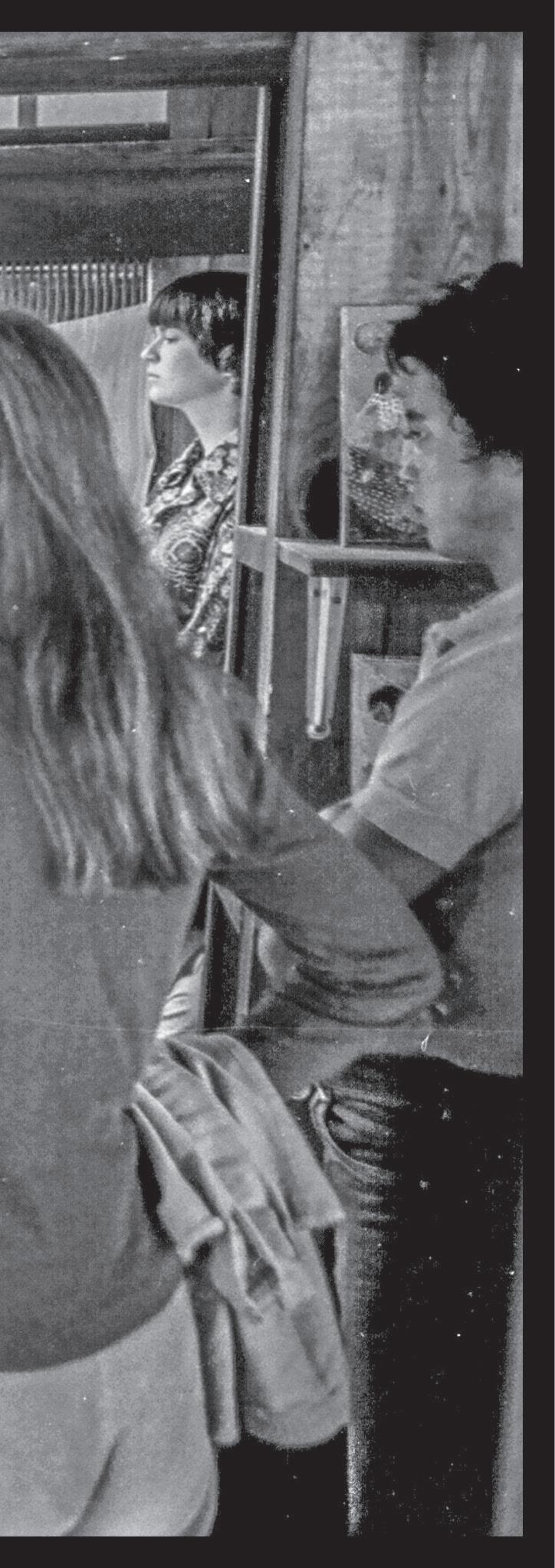
25 BAY AREA NEWS GROUP ARTSY
Top right: Justin Long, executive director of Stewards of the Coast and Redwoods, left, and docent Natalie Robb-Wilder talk outside the pottery studio and school.
Bottom right: Robb-Wilder shows a ceramic piece for beginners in the pottery studio and school.
Vegan pop-up The Mushroom dishes up bold adventures in colorful food and art
BY JESSICA YADEGARAN
You’re sipping natural wine in a dining room where the walls, tables and staff are covered in green.
A tower of grilled and roasted squash layered with electric-purple potato puree has been placed before you on a pink plate. Star-shaped radish and black sesame hummus sandwiches surround this miniature tree like fallen leaves, and sugar snap pods filled with carrot puree rest at its base, like logs in a psychedelic forest.
This is San Francisco’s The Mushroom, a vegan pop-up marrying food and art in a way the Bay Area has never seen. Chef Alex Lauritzen and co-owner Frank Valadez pair eclectic ceramics with bright vegan cuisine in what can only be described as living art. Lauritzen started the five-course dinners ($200) highlighting those handcrafted ceramics last summer and has watched as each dinner sells out, with waiting lists long as your arm.
Lauritzen, a native of Utah, comes from the fashion world. He moved to San Francisco in 2017 after living in New York and Paris. A stint at Rose Bakery in both cities sealed his future in food. Since arriving in San Francisco, he has worked at several notable restaurants, including Cotogna, Verjus and Yo También! Cantina, but The Mushroom is his first role as a chef.
Valadez attended design school in Los Angeles and moved to San Francisco in 2015, landing a job at legendary Heath Ceramics. The two came together when Lauritzen asked Valadez to sew
aprons and napkins for the first Mushroom — and that particular shade of green is called Kiwi 160235. It’s “energetic but balanced,” Valadez says. “It’s really bold, but it kind of disappears when the whole room is covered in it.” We recently spoke to Lauritzen about The Mushroom concept and its marriage of food and art.
QYou’ve commissioned several pieces by Oaxacan ceramicist Jorge Reynoso. Why does his work resonate with you?
AHis work is tactile and organic. You can see
the process in all his pieces, even down to his fingerprints interrupting the glaze. I think a similarity in both our work is that none of it is perfect. We are both very into the “gloopy” look, and it’s super fun to play with his glazes when we are plating a dish. Some diners even mistake parts of his pieces as food.
QYou also work with Bay Area ceramicists Daniel Vu and Christopher Kidtofer. Tell us about them.
AWe met Daniel, who is from the Peninsula, at a craft fair in the city. We were instantly drawn to the precision and quality of his work. Frank’s expertise and knowledge in ceramics really helped with the decisions to commission pieces from Daniel. Although they are the simplest pieces we use, they are beautiful. The color of the glazes is stunning, and they’re durable. Christopher is hands-down one of my favorite ceramists. The collaboration has been very exciting. We’ve had several meetings to discuss color, print, artwork, and Christopher has even come up with some ideas for plating. Our hope is to turn this into a series of dinners where we work with all sorts of different artists.
QHow would you describe your food?
AWe source our ingredients from the San Rafael farmers market on Thursdays, which is geared toward restaurants. The food is super simple — really close to the earth, super colorful and whimsical. Part of what brought me to San Francisco is that I’m nostalgic for 1960s psychedelia and have always had an affinity for the ‘70s. But the main mission is to highlight vegetables in vibrant and exciting ways. I’ve been vegetarian since I was 11 and vegan for the past 10 years.
The gazpacho is something I’m excited about. We always do a soup, and this one is an everykind-of-stone-fruit and tomato gazpacho with sherry vinegar and basil oil. We serve that with grilled cornflower and summer squash on top.

QWhat’s next for The Mushroom?
AFor us, the most eye-opening part of this is how excited people are about it. The majority of our guests are in the art, design or food world. And I don’t think there are enough spaces in San Francisco that bring creatives together. Our main goal is to make San Francisco an exciting and vibrant place. We can reminisce about its heyday, but ultimately, it is what you make it. We have big plans and a lot of ideas about the future.
26 ARTSY BAY AREA NEWS GROUP
Q&A
Above: A bowl of stone fruit and tomato gazpacho at The Mushroom in San Francisco.
Opposite: Coowners Alex Lauritzen, left, and Frank Valadez.
JOSE CARLOS FAJARDO/ STAFF

For Dublin artist, vodka-soaked coffee is a pigment of his imagination
BY JUNYAO YANG
What do coffee stains remind you of? For Dublin artist Jarold Cadion, the answer is easy: watercolors. He discovered the hidden world of coffee art via an illtimed coffee spill as he was running late to the office, latte in hand.
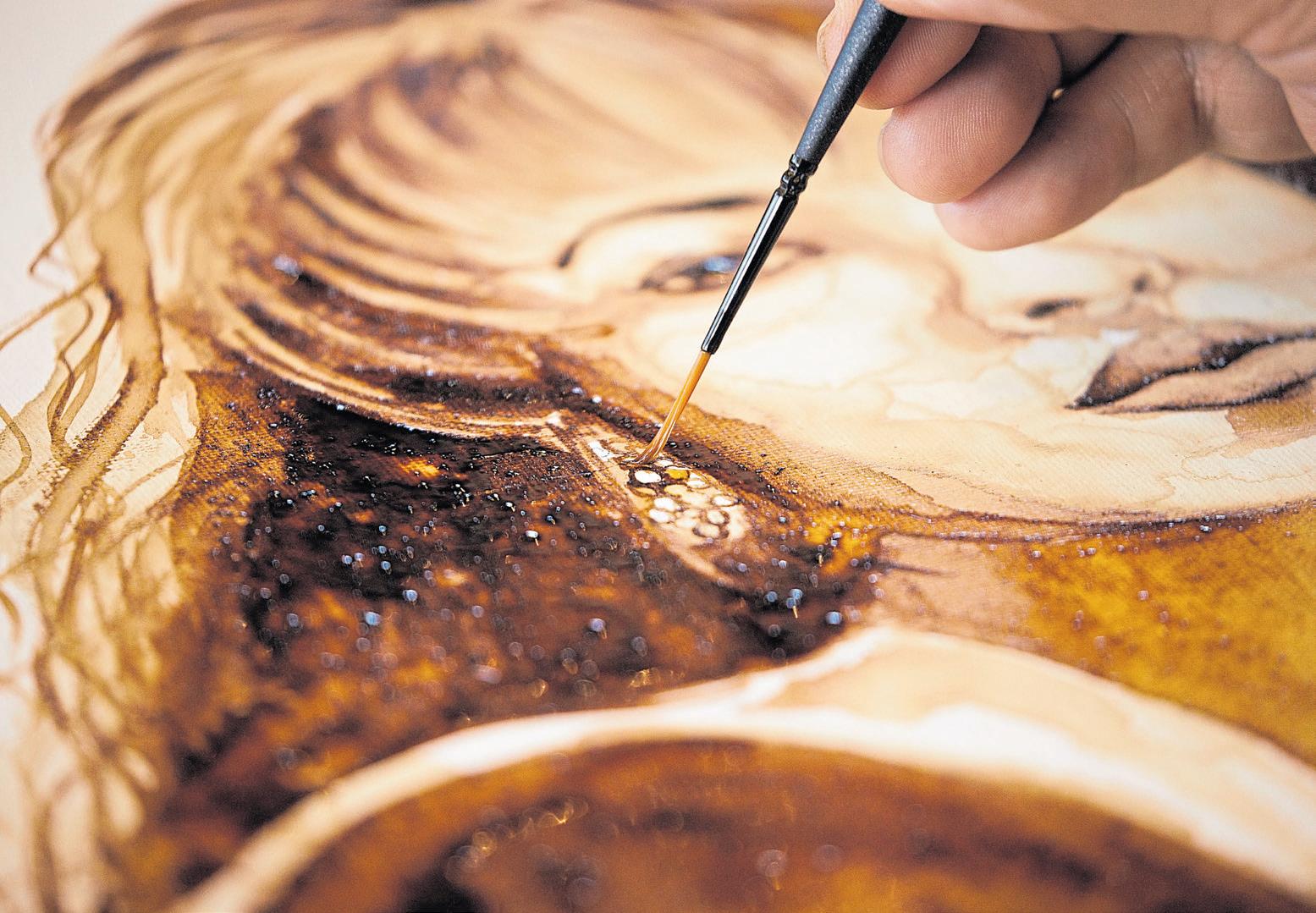
More than 10 years later, his coffee portraits — paintings of celebrities and musicians rendered in coffee extract, instead of gouache — have caught the attention of art lovers as well as espresso fans. What began with a 20- by 30-inch Bob Marley portrait for his sister’s dental office has expanded to include a wide variety of portraits, commissions and collaborations with Philz Coffee, among others.
On a recent afternoon, Cadion talked technique and artistic inspiration — from a coffee shop, of course.
QHow did you start painting with coffee in the first place?
AI had a great teacher at San Diego State who inspired me in the way I think when I paint with oils, acrylics and watercolors. Then 10 to 15 years ago, I moved to New York for a couple of years. Every day, I worked a nine-to-five, paper-pushing job. I would always get coffee in the morning — a double-shot latte or an Americano. One day, some of the coffee spilled (and) the stains reminded me of watercolors. So I put two and two together.
QYou’re not dipping the brush in your morning latte, are you? How does this actually work?
AIt sort of started that way. I experimented with regular coffee, brewed coffee and instant
coffee. Five or six years ago, I found out how to make my own coffee extract. I grind my own beans to a certain coarseness and let it sit in vodka for a month or so. From there, I extract all the coffee and burn away the vodka — you can make it as thick as you want. I’m still messing around with it. It still gives me different results from different kind of beans or grinds, so it’s always a surprise.
QHow is painting with coffee different from using traditional paint?
AI compare it to watercolors and gouache, but after the coffee dries on the canvas, if you add water to it, it will reactivate. So you don’t want to mess up an area that you’ve worked on for hours by adding a little bit of water. You’ll be able to wipe it off.
QHow did your time in New York influence your art?
AI take the street graffiti style of New York into the way I paint. The more fine-tuned parts of my paintings are from my California side. All my grittiness, all the splatter I put on there, all the different ways I experiment with the coffee, that’s where New York comes out.
QWho’s your artistic role model?
Artist Jarold Cadion, right, uses coffee to paint the late musician Selena on canvas at Inklings Coffee & Tea in Pleasanton.
DAI SUGANO/STAFF
AThe person who inspired me the most when I was a kid is David Mack, a comic book artist. He actually painted with watercolors. He told stories that way. I never knew that you could have such fine art in a comic book. Before Comic-Con got big, there were smaller conventions for artists and comic book people. So I actually met him when I was 16 or 17, and he liked my work.
QYou’ve been doing coffee art for years. Has it changed you in any way?
AIt pushes my abilities to make a portrait with just one color. Trying to convey emotions, images and tones with coffee is difficult. It takes a lot of patience. But I’m more open to try something out and let it fail, then recover from it.
SO YOU WANT TO MAKE YOUR OWN COFFEE EXTRACT?
The easy way: Combine a cup of instant coffee with a cup of vodka
Blend for 5 to 7 minutes
Adjust by adding coffee or vodka to reach the desired consistency
Cadion’s way: Grind 10 to 20 grams of coffee beans very coarsely
Transfer the grounds to a jar, add vodka and let it sit for a month
Strain the coffee mix, then place the liquid in a sauce pan and bring to a simmer, so it burns off the vodka and reduces to the desired consistency
28 ARTSY BAY AREA NEWS GROUP
Q&A

Oh, the places you will go virtually

—
courtesy of Google Arts and Culture
BY MARTHA ROSS

Museums may have closed in the early days of the COVID pandemic, but no one’s appreciation of art shut down. Lovers of great paintings, sculpture and other visual works could still find ways to visit their favorite museums around the world virtually via Google Arts and Culture.

Since its 2011 launch, the Mountain View tech company’s platform has made it possible for art lovers, dabblers and the merely curious to see images of paintings, sculpture and other works housed in more than 2,000 institutions worldwide — all from the comfort of home. And Google employed its 360-degree, “street view” technology to offer virtual walkthrough tours of galleries, monuments and historical areas as well.
It all made life more bearable during the dark days of 2020 and 2021. But even though the world has reopened since then, there’s no reason to stop exploring with Google Arts. For one thing, there’s no way even the most determined globetrotter could ever get to a fraction of these 2,000 institutions. Go online, though, and you can immediately engage with art and culture
31 BAY AREA NEWS GROUP ARTSY
Above: Google Art Camera captures the scenes at Versailles.
COURTESY OF GOOGLE ARTS AND CULTURE LEFT: ILLUSTRATION BY GETTY IMAGES
in any place that strikes your fancy, via laptops, phones or tablets. And you can visit places that aren’t on the usual tourist itinerary.
Adding to the viewer-engagement factor, Google’s “gigapixel” Art Camera lets people view works in ways that simply aren’t possible any other way, even if in person. As any regular museum-goer knows, crowds, security concerns and other logistics often make it impossible to get up close to well-known works for any length of time — not without giving museums guards heart failure, anyway.
“When you go to a museum, and you see it real-life, you can get the emotion you wouldn’t get online,” says Simon Delacroix, Lead for Google Arts and Culture in North America. “But with the Art Camera tool, you can get to know an artwork in sometimes intimate detail that you otherwise wouldn’t get in a museum, so it’s a nice complement.”
Every day, Google Arts offers up articles, videos and other visual deep-dives into a particular work, artist, movement and city’s culture. You can read, you can browse — and you can use the Art Selfie filter to place yourself in famous portraits or solve art-inspired jigsaw and crossword puzzles.
There’s a deeper purpose to this, though. As Delacroix explains, Google Arts has taken on the vital task of digitizing and making available collections at risk of being lost forever or that have become off limits, due to natural disasters, war and other cataclysms.
Russia’s invasion of Ukraine this year turned locations of that country’s museums into war zones. At the same time, the U.S. State Department has told Americans to avoid travel to Russia. But with Google Arts, Americans can still visit the

32 ARTSY BAY AREA NEWS GROUP
National Center for Folk Culture or the National Art Museum in Kyiv, the Pushkin State Museum of Fine Arts in Moscow or the State Hermitage Museum in St. Petersburg. One of the largest museums in the world, the Hermitage is housed in the tsars’ former Winter Palace.
There are so many places to explore on Google Arts, both near — San Francisco’s Legion of Honor, the Cantor Arts Museum at Stanford — and far. Here’s a sampling of virtual journeys that will take you halfway round the world, get you up close to some of the world’s most famous works or introduce you to some of the platform’s newest initiatives.
SEE SOME GREATEST (ART) HITS
With Google’s Street View, you can stroll through the Hall of Mirrors at Versailles, view landscapes and portraits by J.M.W. Turner or John Singer Sargent at the Tate Gallery in London or catch Renaissance masterpieces at the Uffizi in Florence, including Michelangelo’s “Doni Tondo,’” Botticelli’s “Birth of Venus” and Caravaggio’s “Medusa.”
View masterpieces from the Dutch Golden Age while ambling through several floors of the

Through the Google Arts and Culture digital archive, history buffs can flip through some 40,000 pages of medieval manuscripts from Timbuktu, left, and take a virtual walkthrough of the Museu de Arte de São Paulo, Brazil.

Rijksmuseum in Amsterdam. The most famous of the famous there is Rembrandt’s game-changing “The Night Watch” from 1642. The platform also offers a quick visual tutorial on Rembrandt’s unprecedented manipulation of light.
Go back in time two millennia and take a walk around a full-scale reconstruction of the massive Pergamon altar in Turkey, a Hellenistic monument from the second century B.C.E. which inspired the name and construction of Berlin’s Pergamonmuseum.
Jump forward to the 13th to 14th centuries — and several time zones away — and venture to Sukhothai Historical Park, a World Heritage site 220 miles north of Bangkok. Stroll around Wat Mahathat and other ruins of temples that once dotted Sukhothai, one of the first kingdoms to rule Thailand.
On the same continent, visit the National Museum of Modern and Contemporary Art (MMCA) in Seoul. There’s no denying that South Korea’s K-pop singers and filmmakers have become some of the most dominant forces in today’s global culture. That influence extends to fine arts, as you can see through a Google Arts tour of MMCA.
On the other side of the world, the architecturally striking Museu de
33 BAY AREA NEWS GROUP ARTSY
EDUARDO ORTEGA/ COURTESY OF GOOGLE ARTS AND CULTURE
Above: As ancient manuscripts were destroyed by jhadists at Timbuktu, the race began to digitize the irreplaceable artifacts and preserve them.

Arte de São Paulo in Brazil offers a radical new way to view classic paintings from the Americas and Europe. Here, paintings by Van Gogh, Picasso, Modigliani, El Greco and Manet are pulled away from the wall and displayed on crystal easels arrayed around the gallery, almost as if they are floating in space.
DISCOVER MANUSCRIPTS FROM A FABLED CITY
To us Californians, the name of Timbuktu, which lies at the edge of the Sahara in the West African nation of Mali, has become shorthand for a place that is far, far away — and maybe not even real.
But as shown by one of Google Arts most exciting and vital projects, this small city is intoxicatingly real. For centuries, Timbuktu was a hub of trade, wealth and culture on the African continent, as well as an Islamic center of learning. It’s still known for its imposing earthen mosques as well as the hundreds of thousands of scholarly manuscripts from its medieval golden age.
Unfortunately, its treasures have been imperiled by the civil war that broke out when Islamist militant groups took control of the
city in 2012. Since 2014, Google has worked with local scholars to digitize those manuscripts, some of them dating back to the 11th century, and make them available through its Mali Magic portal.
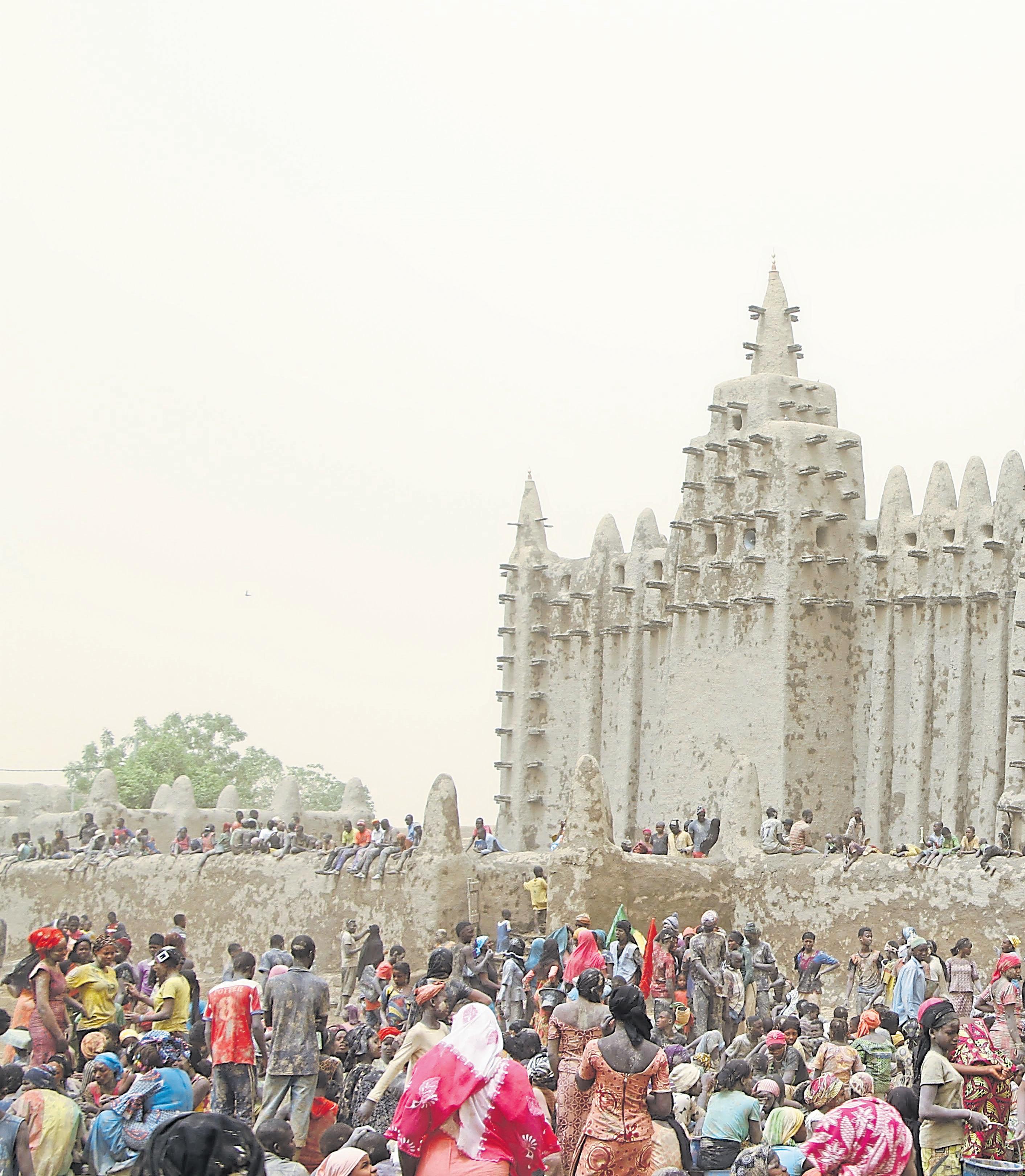
Some 40,000 pages are available online to digitally flip through or view up close. Covered in beautifully scripted, medieval
Arabic, the pages cover a range of topics: philosophy, economics, medicine, agriculture, astronomy, mathematics and religion as well as everyday life.
The Google Arts portal also offers a street view tour of Malian heritage sites, such as the Great Mosque of Djenné, a UNESCO World Heritage site as well as
accompanying videos, illustration and music about contemporary Mali visual artists and musicians.
VENTURE INTO THE “STARRY NIGHT”
With the platform’s Art Zoom video series, well-known musicians, such as Grimes and FKA
34 ARTSY BAY AREA NEWS GROUP
Right: A glimpse of a plastering project at the Great Mosque of Djenne in Timbuktu, Mali.
COURTESY OF GOOGLE ARTS AND CULTURE
Twigs, take viewers on a tour of artworks that speak to them. In one particularly moving video, singer-songwriter Maggie Rogers contemplates the “romance of the tortured artist” and what Vincent van Gogh may have been thinking, feeling or seeing when he painted his gorgeously vivid 1889 work, “The Starry Night.”
As Rogers explains, the painting depicts the artist’s view from the window in his asylum at Saint-Rémy-de-Provence. “The window of his mind,” Rogers calls it. The Dutch master had cut off his ear six months earlier; one year later, he would be dead
As Rogers narrates, the camera moves around the canvas and
zooms in on details of Van Gogh’s “almost apocalyptic” vision: “the psychedelic, almost ominous spiral” in the middle of the sky, the “exploding fireballs, nebulas, all with their own reddish core,” and the spots in the canvas that he left empty.
“This starry night is not like any starry night I’ve ever seen,” she adds. “Surely, his nights were more beautiful than our days.”
WATCH PUERTO RICO SAVE ITS CULTURAL HERITAGE
The devastation wrought by Hurricane Maria in 2017 highlighted the challenges of keeping Puerto Rico’s cultural treasures safe in an unpredictable tropical climate. It became clear to residents as well as to others of Puerto Rican heritage, including Broadway star Lin-Manuel Miranda, that works representing the island’s vibrant and diverse culture had become inaccessible to the public because there was no physical space to display them.
In 2019, Miranda and others partnered with Google Arts and Culture to digitize works in four Puerto Rico museums, whose collections encompass more than 500 years of the island’s history, multiculturalism and global cultural influence. One of those featured works on Google Arts is painter and muralist Augusto Marin’s “El “Grito de Lares,” a dramatic and violent depiction of the first major revolt against Spanish rule.
LOOK UP TO THE WORLD’S MOST AMAZING CEILINGS
Some of the most beautiful paintings and mosaics in buildings around the world are hard to see in any detail, because they grace soaring ceilings. It can be a literal pain in the neck to gaze
upward for too long. But Google technology zooms in on those works to let people see the fine details and embellishments, Check out Marc Chagall’s lyrical, vibrantly hued ceiling for the Opéra national de Paris. Or float around in Street View to see the stunning mosaics created for the ceilings of the Quire in London’s St. Paul’s Cathedral, the work of Arts and Crafts painter, sculptor and designer William Blake Richmond, done at the behest of Queen Victoria.
The Wazir Khan Mosque in Lahore, Pakistan, built during the 17th Mughal dynasty, offers a different kind of imperial grandeur, with its ceilings decorated with frescoes and intricate glazed ceramic tile work known as kashi-kari.
FIND ALL YOUR FAVORITE VERMEERS IN ONE PLACE
If you’re a fan of “Girl with a Pearl Earring,” Johannes Vermeer’s mesmerizing portrait of a young woman in a turban and the titular earring, you might long for the chance to see all the Dutch master’s 36 surviving works in one place.
It’s never going to happen, because the nearly 400-year-old paintings are too delicate to travel. But working with curators at the Mauritshuis museum in The Hague, where “Girl” is housed, Google Arts has used what’s known as augmented reality to create a virtual exhibition of all of Vermeer’s works. In this gallery, you can see his remarkably light and pure depictions of daily life up close, including his famed cityscape of Delft, “The Milkmaid,” “The Woman Reading a Letter” and “The Painter in His Studio.”
Explore more and indulge your curiosity at https:// artsandculture.google.com.

35 BAY AREA NEWS GROUP ARTSY
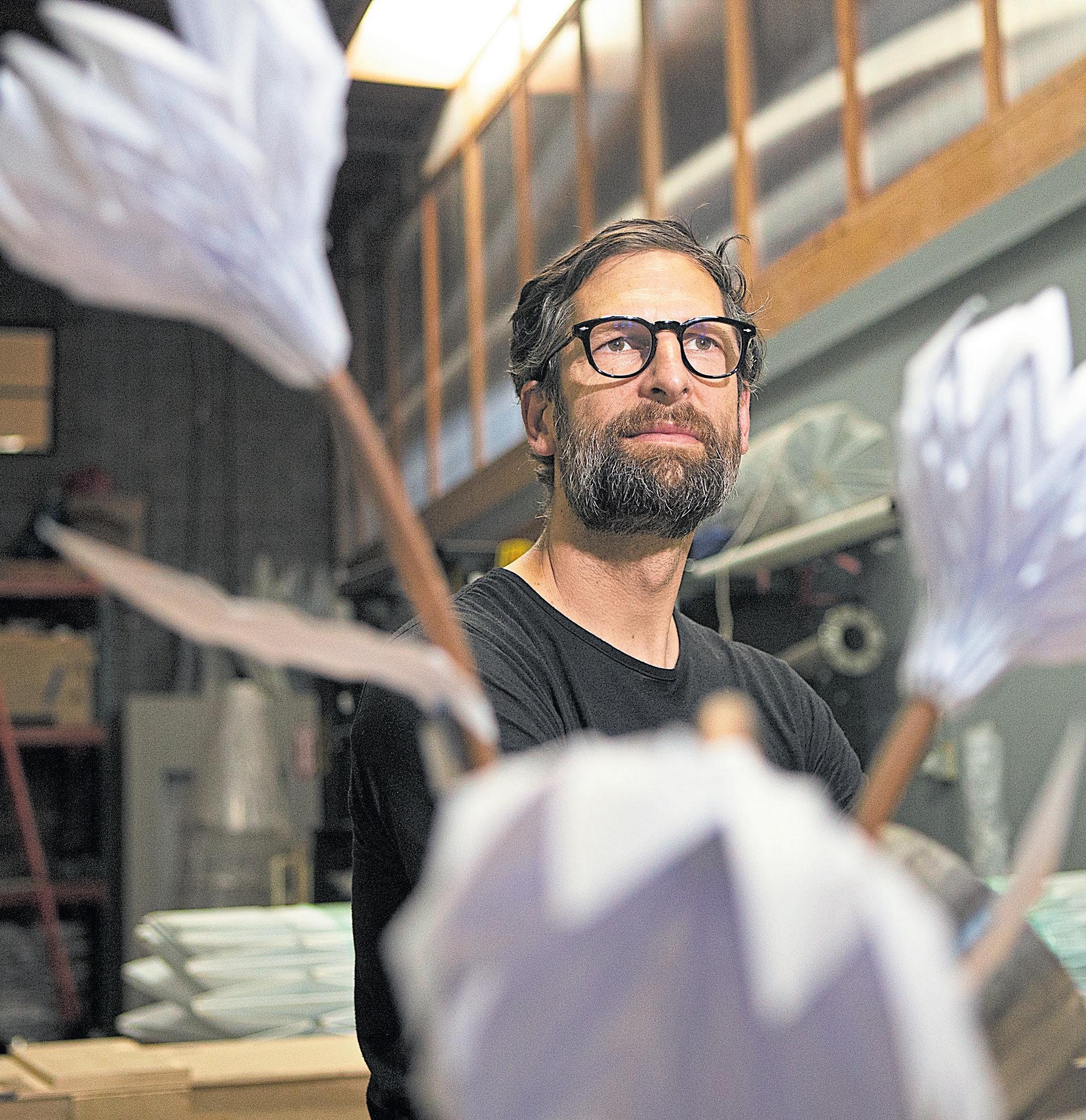
‘Just make things!’ fuels the creativity at FoldHaus art collective
BY BRITTANY DELAY
FoldHaus is a San Franciscobased art collective that builds large-scale, interactive sculptures at the intersection of art, engineering and technology and uses the distinctive folding patterns of origami for their pieces.
They’re all volunteers, including co-founders Joerg Student and Jesse Silver — by day, Silver is chief product officer at Headspace. And many of them used to work at the design firm IDEO, where they were all fascinated by the unique, large-scale installations at Burning Man. Soon, IDEO’s creative engineers were brainstorming ideas of their own.
Since then, FoldHaus’ transformative sculptures, which include blossoming Blumen Lumen, mushroomlike Shrumen Lumen and a five-story Radiolumia sphere, have all graced the Burning Man Playa.
QCan you tell us about your first Burning Man experience?
Silver: My first Burning Man experience happened years and years before we started making art for it – 2006 or 2007. I had friends that went, and what they told me didn’t really sound that appealing. I don’t love crowds. I don’t really go to festivals. I’m not a big partier. But then I got there, and I realized I could make it all about seeing these crazy things that people make.
My mind really was blown by it. Just the fact that it’s a blank canvas — it’s just an endless desert. There’s no stands set up by some cell phone company, no vendors of any kind. I think it is
Top right: Metal parts for a new “Blumen Lumen” await attention at the FoldHaus Art Collective studio,
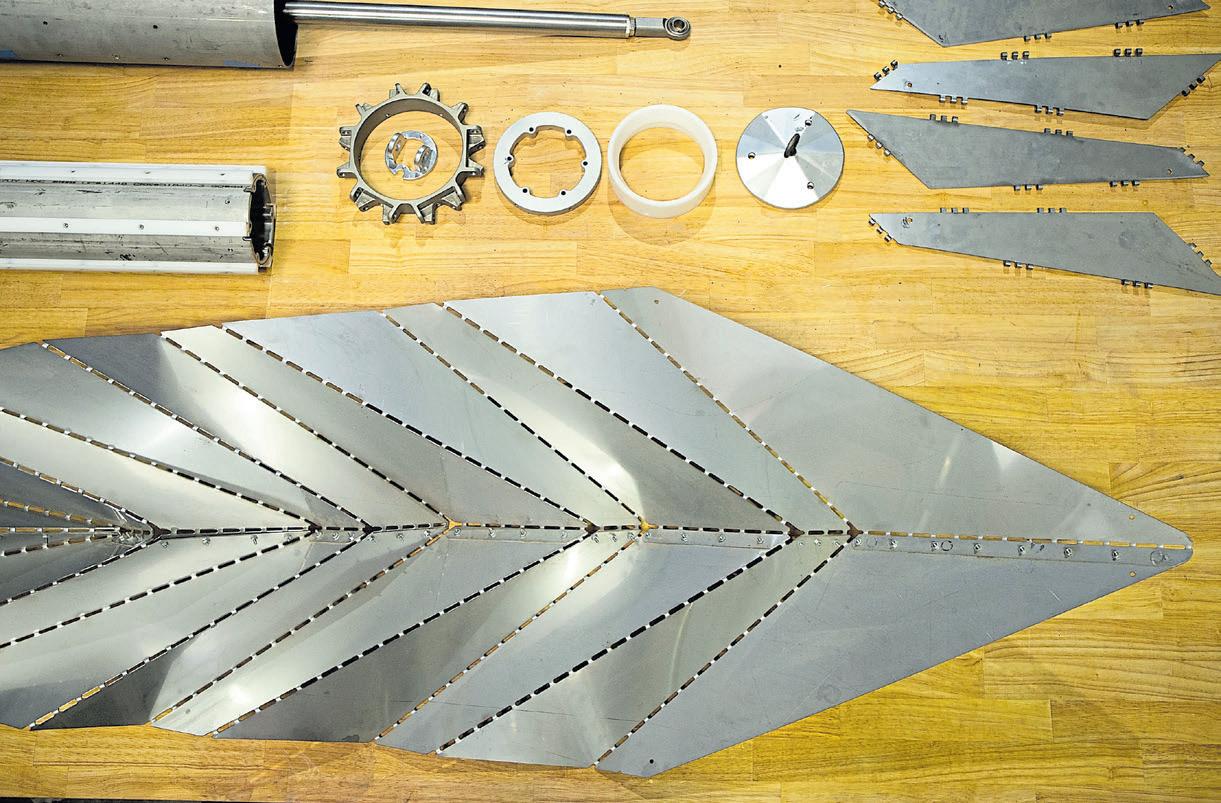
that blank-canvas aspect that gets people to make these crazy, weird things.
QWhy origami?
Silver: A lot of credit goes to Joerg. He had done some work in grad school on pop-up emergency shelters. (They) could essentially drop from the back of a truck or helicopter — folded and compressed into a really flat thing.
WANGYUXUAN
Student: (It was) my final thesis project at the Royal College of Art in London — a concept for a collapsible shelter that could be rapidly deployed in disaster situations. When sharing the work with some colleagues at IDEO, they told me I should bring it to Burning Man. Shade is the most important feature on a shelter there, (so) I redesigned it a few years later when I went to my first Burn: open on the sides and covered above. The shelter became our camp centerpiece for the years that followed. People who saw it in our camp suggested bringing it or something similar to the open Playa for everyone to see.
QYour art pieces are largely interactive…
Student: All the designs start with paper, and one thing that we realized when playing with the paper model was that motion would be the coolest feature to have with large-scale origami. So Jesse and I and a few other friends from IDEO decided to design and engineer the giant interactive flowers called Blumen Lumen.
Silver: People like to be a part of the art, have a new environment created for them. Instead of our pieces operating on a timer, we’ve played with things that are human or environment interactive. The mushroom pieces have these footpads in the ground you can step on. We stayed there for days watching people figure out how to interact with them. We want to reward the people who slow down and take a moment and explore. You could see people who did that and would be like, “Oh my god, it’s moving!”
QYou and Joerg have day jobs, yes?
Silver: There’s a core group of four or five of us who initiate the work at FoldHaus and usually come up with designs, (but) each thing we do takes between 10 and 50 volunteers to get done. It’s just like weekend after weekend after weekend. We’re all volunteers, and all of us have things we do as our main job.
(FoldHaus is) like a hobby that takes a lot of time and doesn’t pay anything. On the other hand, we get to draw something like this five-story, spiky ball with a moving outer skin and we’re like — yeah, let’s just make that. If we’re lucky, we show it enough times or sell it, and it kind of pays for itself. All the money from showings goes into a bank account, and we pull the money right back out and make something else.
QWhat’s your advice for aspiring artists?
Silver: Believe in your point of view and make stuff that you legitimately think should exist in the world. I would ignore as much as possible the commercial part and the “but who is this for?”
This isn’t my favorite question because that’s the most entitled answer — I know well and good, you cannot do this stuff without paying for it. On the other hand, we wouldn’t have made any of this stuff if at the beginning, we were like, do people really want an origami flower or an origami mushroom that’s 12 feet tall? No, nobody does! We just wanted to make something. We’re always a little surprised when anybody calls us artists, because we’re like, we just make things!
FAVORITE BURNING MAN ARTISTS
HYBYCOZO: https://www. hybycozo.com/
Peter Hudson: https:// www.facebook.com/ PeterHudsonOfficialArtistPage
Christopher Schardt: http:// schardt.org/
Aaron Taylor Kuffner: https:// gamelatron.com/
37 BAY AREA NEWS GROUP ARTSY
Q&A
Left: Joerg Student, Chief Creative Smurf of FoldHaus, displays the prototype of the art collective’s first origami installation, “Blumen Lumen,” in their San Francisco studio.
where artists and makers specialize in large-scale interactive origami installations.
XU/ STAFF
 The Mira Tower, a 40-story residential high-rise designed by Chicago-based architect Jeanne Gang, lends a “twist” to the skyline in downtown San Francisco.
KARL MONDON/STAFF
The Mira Tower, a 40-story residential high-rise designed by Chicago-based architect Jeanne Gang, lends a “twist” to the skyline in downtown San Francisco.
KARL MONDON/STAFF
ICONIC EYECATCHERS

CENTURY FOR THE 21ST
39 BAY AREA NEWS GROUP ARTSY
New Bay Area buildings amaze even the architects
BY MARTHA ROSS
The “Star Trek” universe of movies and TV shows set its 23rd century Starfleet Academy in San Francisco, letting fans feast on images of a futuristic skyline that still included such 20th century icons as the Transamerica Pyramid, Coit Tower and the Golden Gate Bridge. It turns out that this sci-fi vision of Bay Area design has already arrived. In the past 20 years, more than 15 skyscrapers, including Salesforce’s 61-story tower, have reshaped the city’s once picturesquely low-slung skyline. In Silicon Valley, Apple opened a new $5 billion headquarters that locals promptly dubbed the “spaceship,” and sleek, ultramodern and environmentally sustainable designs have become de rigueur for any new government, corporate or cultural building that aspires to worldclass status.
While the Bay Area is home to many famous examples of 19th and 20th century architecture, here’s a list of future design icons, all built since the start of the 21st century. This list was compiled with recommendations from the San Francisco, East Bay and Silicon Valley chapters of the American Institute of Architects.
APPLE PARK, CUPERTINO
One of Steve Jobs’ last major projects before his 2011 death was to win permission to build what he called “the best office building in the world.” The centerpiece of his corporate headquarters, designed by architect Norman Foster and opened in 2017, became
Top: San Francisco’s downtown skyline, capped by the 61-story Salesforce Tower, catches the final warm rays of a winter sunset in January.
a 2.8 million-square-foot ring of glass-encased office space in the middle of 175 acres of parkland. No expense was spared to meet Jobs’ exacting standards. The building was equipped with the world’s largest curved-glass panes and largest rooftop solar farm and surrounded by 9,000 drought-resistant trees.
Bottom: Apple’s corporate headquarters in Cupertino, a 2.8 millionsquare-foot ring of glass-encased office space in the middle of 175 acres of parkland, was designed by architect Norman Foster and opened in 2017.

But in a turn of global events that even Jobs couldn’t predict, the building has been mostly vacant in recent years, due to the pandemic. Apple and other Bay Area companies are still navigating their way through the debate over whether workers need to be in an office to do their jobs.
SALESFORCE TOWER, SAN FRANCISCO
When it opened in 2018, this 1,070-foot tall colossus replaced the Transamerica Pyramid as the Bay Area’s tallest building. Like the pyramid, the 61-story Salesforce Tower also became a lightning rod for criticism, mostly from people who decried the Manhattanization of San Francisco’s skyline. It remains to be seen whether the tower follows the pyramid in becoming a visual symbol of the city. (At one point, the pyramid even became a sight gag atop one of the showstopper hats of “Beach Blanket Babylon.”) Some might say the Salesforce Tower already is an icon, if only because its size makes it hard to miss.
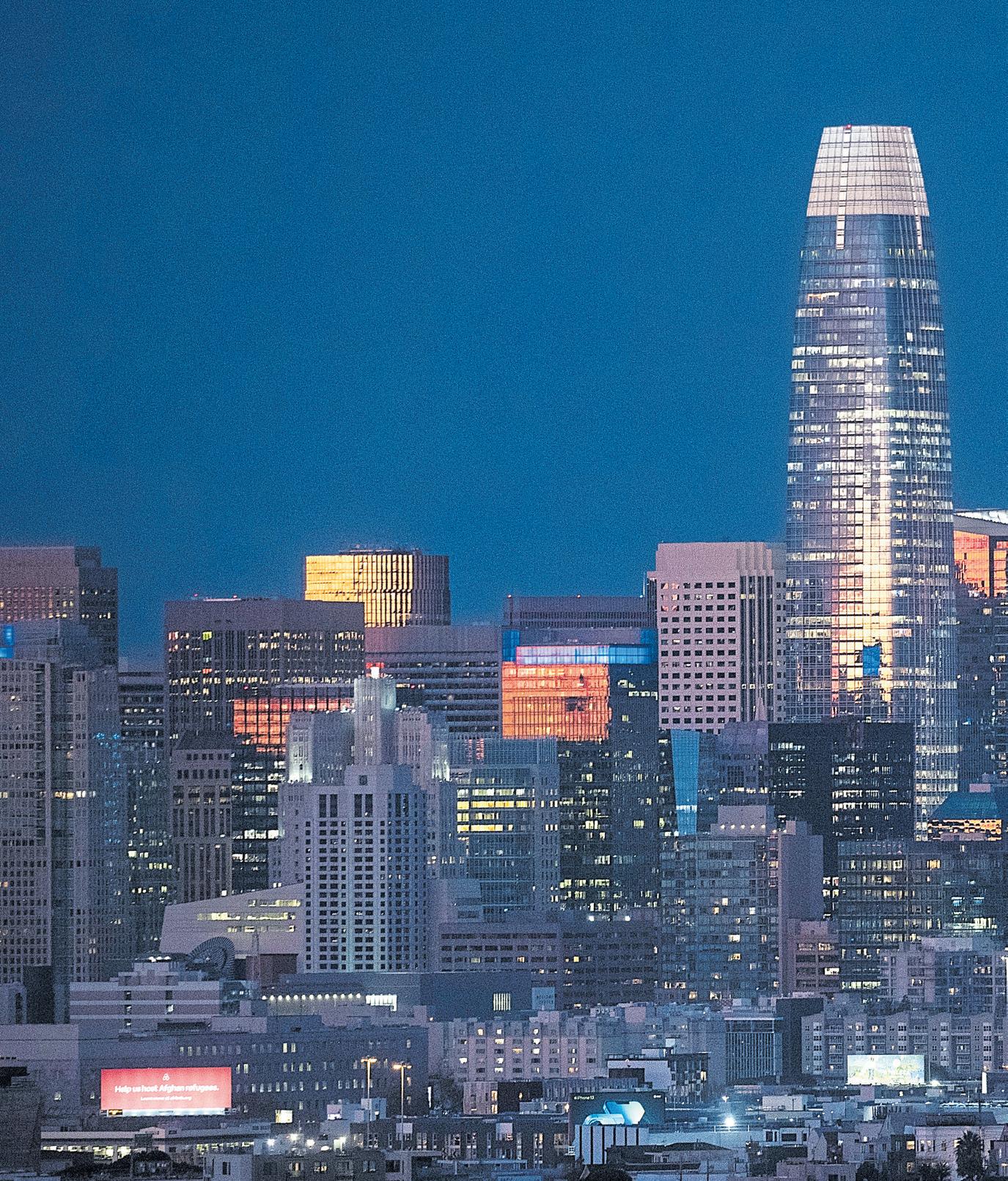
MUSEUM MAKEOVERS
Starting in the early 2000s, four of the Bay Area’s leading cultural institutions got major makeovers. When the new M.H. de Young Museum opened in 2005 in Golden Gate Park, replacing an
40 ARTSY BAY AREA NEWS GROUP
KARL MONDON/STAFF
LIPO CHING/ STAFF ARCHIVES
1890s building badly damaged in the 1989 Loma Prieta earthquake, critics griped that the copper-covered structure looked too much like a rusty aircraft carrier. But as the architectural firm Herzog and de Meuron foresaw, the natural elements of wind and fog would soon darken the copper to a sheen that blends in with the landscape. Meanwhile, the museum has become one of the top 10 visited art museums in the United States, known for hosting wildly popular touring exhibitions as well as for its vast collection of artworks from the 17th to 21st centuries.
Across the park’s music concourse, the California Academy of Sciences reopened in 2008 with a

glass-walled, steel-framed building by architect Renzo Piano that houses a planetarium, aquarium and rainforest, alive with plant and animal species. The museum’s commitment to showcasing the interdependence of biological and Earth systems may be best demonstrated by its 2.5-acre green roof, featuring an undulating expanse of native grasses and wildflowers.
With a game-changing expansion that opened with much fanfare in 2016, the San Francisco Museum of Modern Art tripled the amount of exhibition space in its existing Mario Botta-designed building. In a statement from Snøhetta, the firm behind the ex-
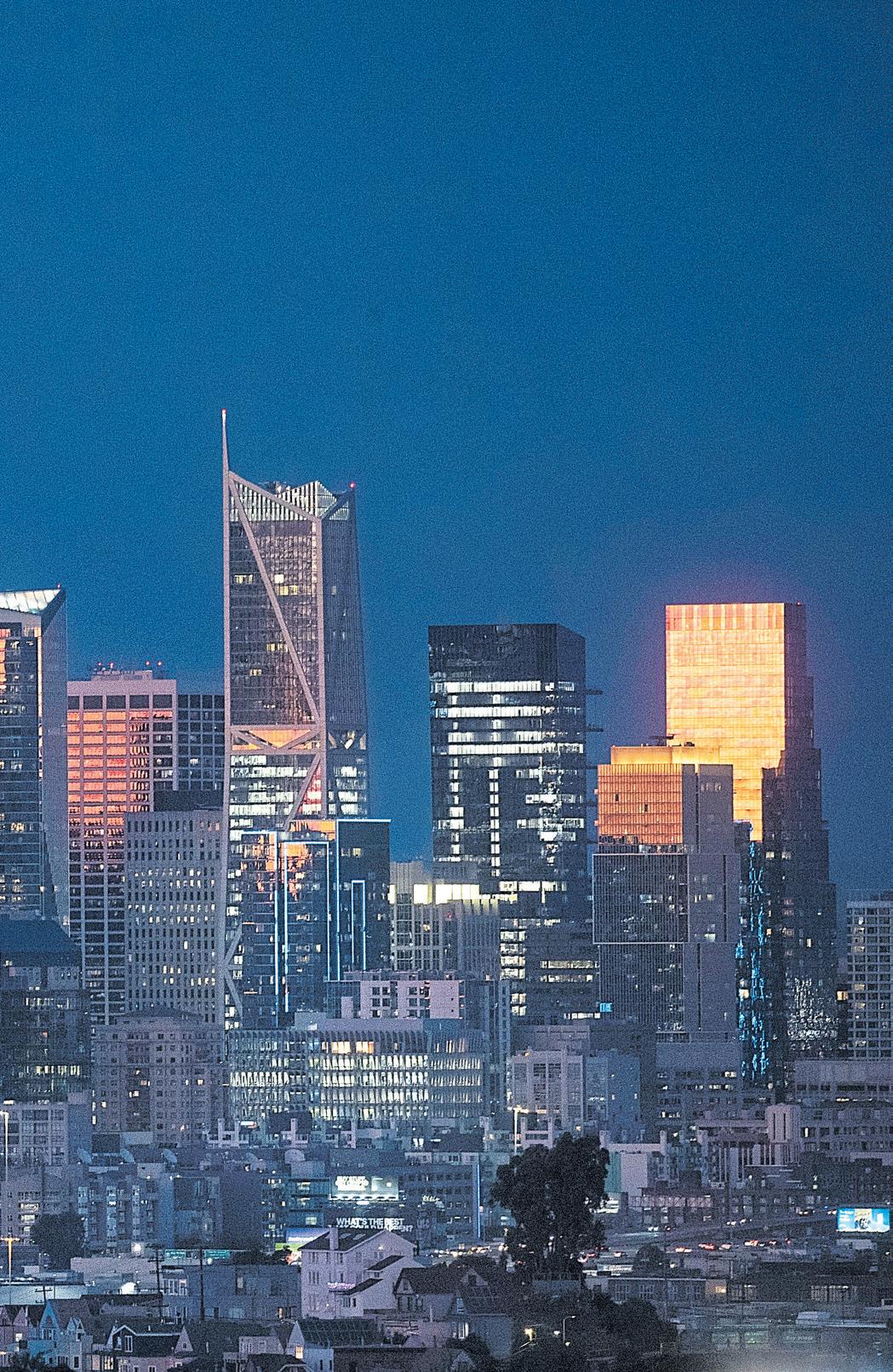
pansion, the museum also became more accessible than ever to the public, “enlivening the surrounding cityscape” by opening up ways that people can circulate into the museum and throughout the South of Market neighborhood.
When seismic safety issues forced the Berkeley Art Museum and Pacific Film Archive to abandon its longtime Brutalist home designed by Mario Ciampi, the museum settled on another plot of UC Berkeley-owned land. With its new downtown Berkeley location, BAMPFA wanted its new home to thematically unite the old and new. The firm Diller Scofidio + Renfro achieved that by constructing some 35,000 square

41 BAY AREA NEWS GROUP ARTSY
Visitors arrive at the de Young Museum in San Francisco. Designed by Herzog & de Meuron, the 2005 building replaced a structure built in 1894. KARL MONDON/STAFF
feet of new space around the Art Deco-style core of the university’s former printing plant. The new space comes in a striking curvilinear form, covered in stainless steel, that drapes over the entrance and houses the film theater and other new spaces.
MIRA TOWER, SAN FRANCISCO
The unusual design of this 40-story residential high-rise near the Embarcadero is credited with adding an actual visual “twist” to San Francisco’s newly futuristic skyline. Chicago-based architect Jeanne Gang, a MacArthur “genius grant” recipient, reinterpreted the idea of the classic bay window by stacking one floor atop another at gradual angles. The strategy was to open up each residence to city or bay views, while creating the image of windows swirling up in a 400-foot-tall corkscrew. In addition to its design, the building also has won praise for reserving up to 40 percent of its luxury units for buyers qualifying for affordable housing.
SAN JOSE CITY HALL
When building a new government center, San Jose turned to Pritzker Prize-winning Richard Meier, one of the world’s foremost architects, creator of civic spaces from the Getty Center in Los Angeles to Barcelona’s Museum of Contemporary Art. In an otherwise postmodern building, with a gleaming 18-story office tower, San Jose’s City Hall pays tribute to the classical design of other seats of government power. Its centerpiece is a $30 million rotunda covered by a dome that is slightly bigger than the U.S. Capitol’s and made up of 1,032 glass panes.
TRANSBAY TRANSIT CENTER, SAN FRANCISCO


If all the years of planning finally come together some time in the next decade, this center won’t just be a “bus terminal,” in the words of Fred Clarke of Pelli Clarke Pelli Architects. With its distinctive, undulating walls, stretching about five city blocks, the complex, which opened in 2018 and which will one day link
bus and train systems throughout the city, region and state, should also become the heart of a bustling new multi-use urban neighborhood. Street-level shops and cafes should draw people in, but the real reason for lingering is the 5.4-acre rooftop park, featuring green lawns, a wetlands marsh, a cluster of oak trees and places for children to play high above the bustling streetscape.
SAMSUNG AMERICA HEADQUARTERS, SAN JOSE
From its exterior, this building presents three stacked slabs covered in glass and metal panels that make it look a bit like a giant microchip. That’s probably appropriate, given that it houses the U.S. semiconductor division for the South Korean electronics and mobile-phone giant. But past the entrance, the 1 million-squarefoot building north of downtown quickly opens up to a campus
42 ARTSY BAY AREA NEWS GROUP
San Jose’s postmodern City Hall includes a dome that pays tribute to the classical design of the U.S. Capitol.
LIPO CHING/STAFF ARCHIVES
Above: A bird’s eye view of the Transbay Transit Center downtown shows off its popular rooftop park. JANE TYSKA/STAFF ARCHIVES
that was designed by architects at Seattle-based NBBJ to feel light, airy and in tune with how people actually move through space, according to the Atlantic magazine. Parklike surroundings, terraces and a doughnut-shaped central courtyard with floor-to-ceiling windows enhance an environment that NBBJ intended to be welcoming to the sorts of spontaneous collaboration and innovation for which Silicon Valley is known.
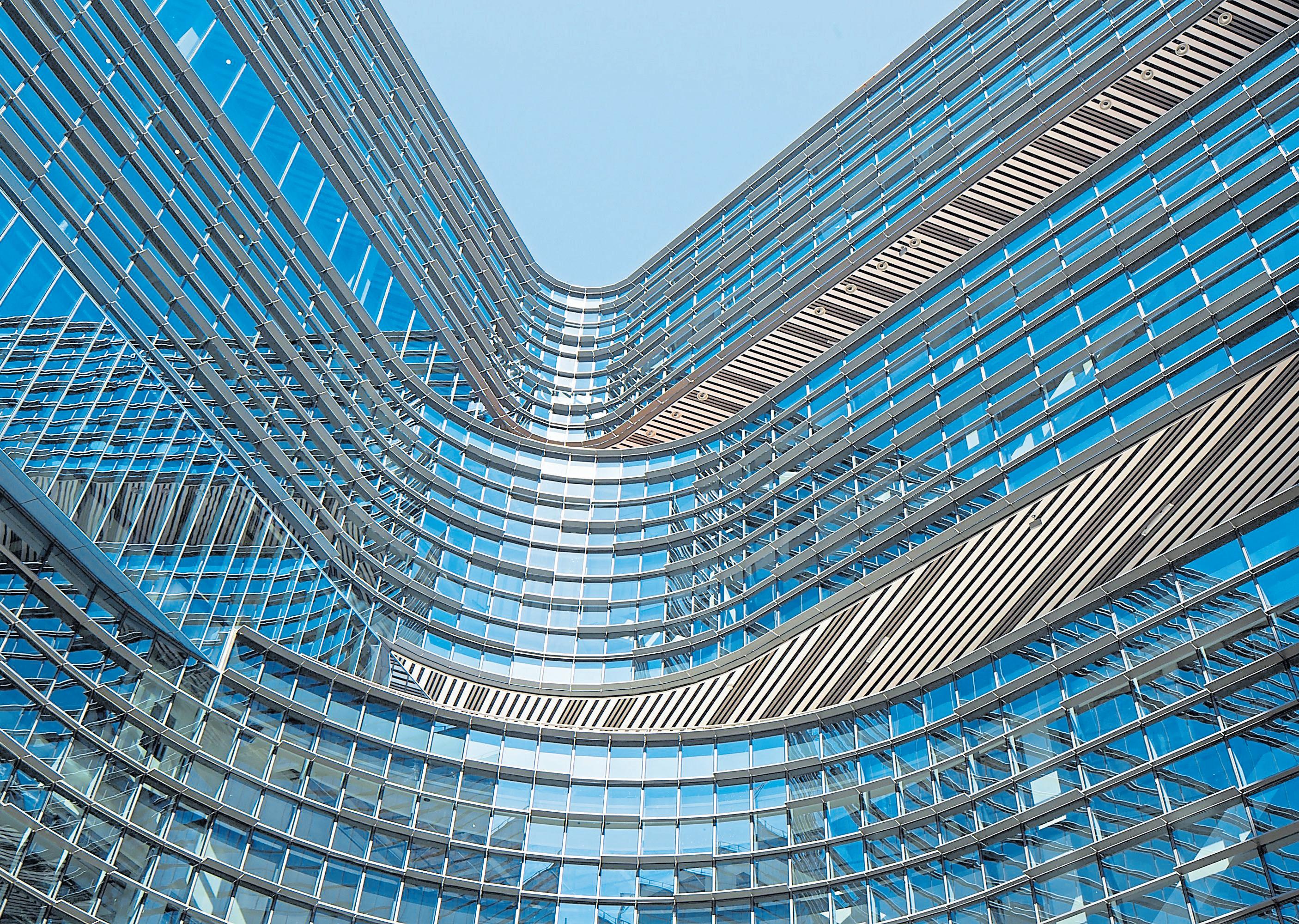
C.V. STARR EAST ASIAN LIBRARY, UC BERKELEY
The exterior of the library, designed by husband-and-wife architects Tod Williams and Billie Tsien, may not seem particularly special. The south wall of the rectangular building facing Memorial Glade is clad with granite slabs and a monumental bronze screen that allow it to blend in with other buildings in the heart of the campus. But upon entering, visitors encounter something beyond the university’s vast collection of rare and priceless East Asian books and artifacts: a space that feels open and bathed in filtered natural light. It’s no wonder that the university reports that since its 2008 opening, the library has become a favorite spot for students to study, regardless of their major.


43 BAY AREA NEWS GROUP ARTSY
With its cutting-edge design, the Samsung America headquarters in San Jose is light, airy and bright, with parklike surroundings, terraces and a doughnutshaped central courtyard with floor-to-ceiling windows. SAMSUNG ELECTRONICS
The C.V. Starr East Asian Library on the UC Berkeley campus has become especially popular with students.
WANGYUXUAN XU/STAFF
The curvilinear architecture of the Berkeley Art Museum & Pacific Film Archive building, which opened downtown in 2016, is sheathed in stainless steel.
RAY CHAVEZ/STAFF ARCHIVES
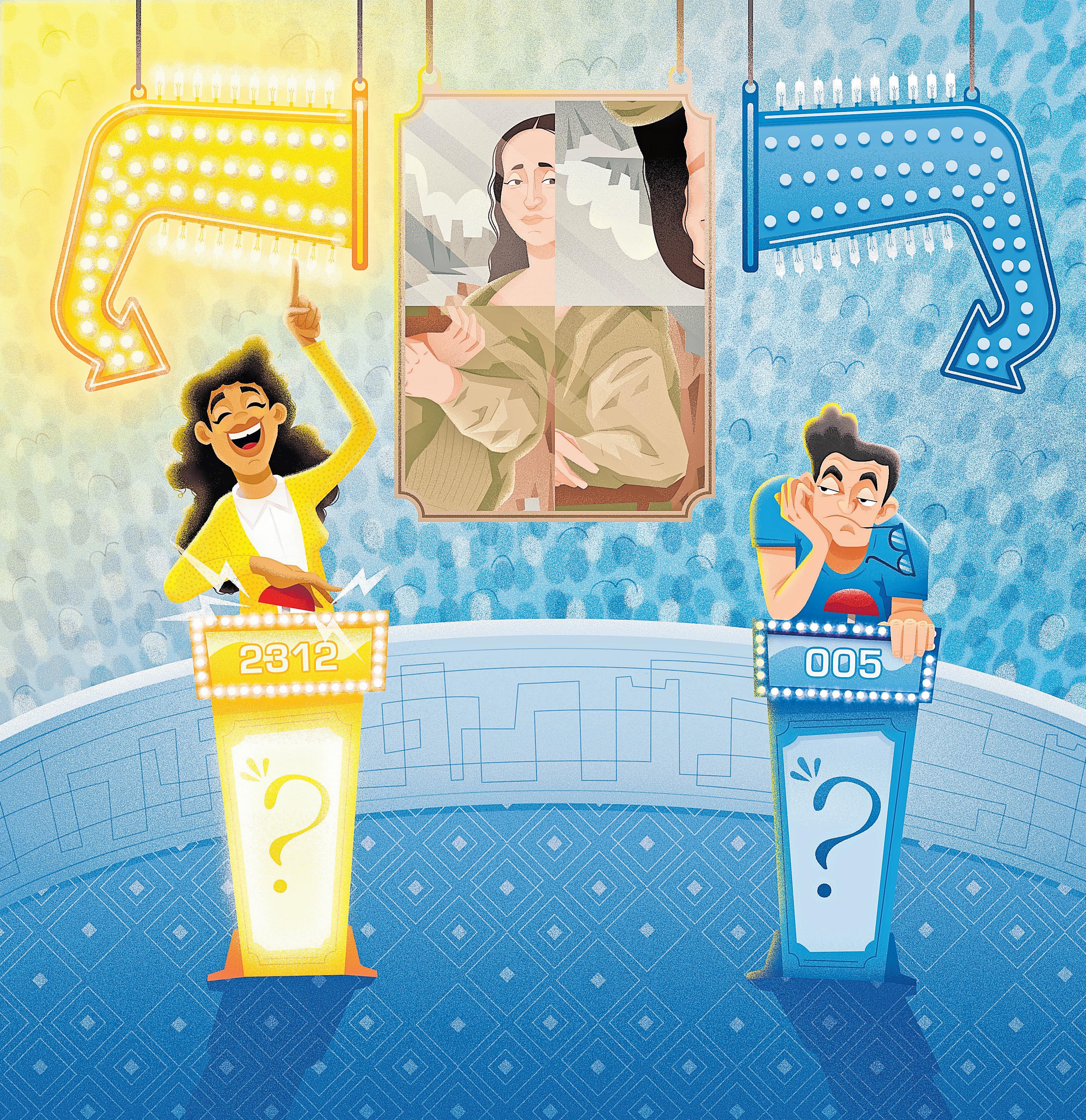
Test what you know about the Bay Area scene
ART SMARTS
STORY BY JOAN MORRIS
ILLUSTRATION BY DAVIDE BARCO
Living in the Bay Area comes with a lot of certainties. There will be fog. There will be too much traffic. There will, from time to time, be earthquakes we’d rather not feel. And there will be galleries, museums, murals, sculptures and architectural gems practically everywhere we turn.
Art might be in the eye of the beholder, but how much do you see? What do you know about the hidden meanings, histories and secrets about the Bay Area’s art scene? Here’s a quiz to test your knowledge. Will you be an art expert or an artful dodger?
1. Coit Tower stands above San Francisco like a sentinel, stretching 210 feet above Telegraph Hill and providing panoramic views of the city and bay below. The tower — part of Lillie Hitchcock Coit’s bequest for the beautification of the city — was built in 1932-33. The interior became the canvas for artists to create frescoes depicting Bay Area life. In all, 26 murals were created, but before the tower opened to the public, one of the works was deemed unacceptable and was chiseled away and replaced. What did some people find so offensive?

A) It depicted Lillie Hitchcock Coit in flagrante on a bed of California poppies.
B) It contained an ad for Lucky Strike cigarettes in what historians agree was the first “product placement” advertising ever recorded.
C) Many of the works depicted socialist themes, but in San Francisco’s politically charged atmosphere of union unrest and strikes, the mural was deemed to have too many overt symbols of Communism.
D) The mayor just didn’t care for it.
2. UC Berkeley’s Stern Hall was built in 1932 as an all-female residence hall for 90 undergraduate women. It also houses a mural by a famous artist. A posthumous gift from Rosalie Stern
after her death in 1956, “Still Life and Blossoming Almond Trees” originally was installed in Stern’s Atherton home in 1931. Who was the noted muralist?
A) Maxfield Parrish
B) Frida Kahlo
C) Rosalie Stern
D) Diego Rivera
3. If you’ve ever entered San Francisco’s Chinatown through the “Dragon Gate” portal, you might have noticed the two foo dog or lion dog statues on either side. The Chinese guardian lions were placed there in 1952. How did they get there?
A) They were installed as protection against harmful spirits or beings.
B) A wealthy San Francisco shipping magnate bought them for his wife, who didn’t like them and had her servants sneak them out of the house at night. The chambermaid thought they’d look at home in Chinatown.
C) No one really knows. They just appeared there one day in 1952.
D) There were mistakenly installed at the gate when the delivery driver got lost on San Francisco’s hilly streets and mistook the Dragon Gate for the entrance to the Chinese ambassador’s residence.
45 BAY AREA NEWS GROUP ARTSY
The interior of San Francisco’s Coit Tower is lined with murals painted during the Great Depression.
JUSTIN SULLIVAN/ GETTY IMAGES
Do the lights atop the Adobe World Headquarters building in San Jose mean something?
Why are the figures on the Palace of Fine Arts colonnade hiding their faces?
 ARIC CRABB/ STAFF ARCHIVES
ARIC CRABB/ STAFF ARCHIVES
4. Adobe’s corporate headquarters in downtown San Jose features four large, orange LED lights that resemble flat head screws atop the Almaden Tower. The lights change positions every 7.2 seconds. What’s the meaning behind the lights?
A) They’re semaphores, spelling out a secret message.
B) They’re just flashing lights. Not everything has to have a meaning, you know.
C) They flash the day, time and temperature.
D) They record sales of Adobe products.

5. Frank Lloyd Wright’s brilliance and influence makes any building or home he designed an automatic classic. San Francisco holds a part of that legacy in a single building by the famed architect — his only work in the city. A noted Wright scholar says while the exterior is striking, it is the interior spiral ramp that is most significant, as it might have served as a trial run for two of Wright’s better known buildings, the Guggenheim in New York City and the David Wright house in Phoenix. Who was the San Francisco building originally designed for?
A) It was supposed to be a home-awayfrom-Hollywood home for Clark Gable and Carole Lombard, but Lombard died before construction was completed. Gable held onto the home for many years, but could never bring himself to live there.
B) It was designed and built for the V. C. Morris Gift Shop.
C) It was the first California Nordstrom store.
D) It was a Northern California offshoot of the famed L.A. eatery, the Brown Derby.
6. In the late 1980s, the City of Concord joined the parade of cities commissioning public art for the enjoyment and enrichment of their
ANDA CHU/ STAFF ARCHIVES
residents. Unfortunately, the East Bay city’s foray into the trend was not well accepted by the citizenry, who found the work less than uplifting. Concord’s “Spirit Poles” stood along a stretch of medians in the city’s downtown area and consisted of 91 aluminum poles jutting out at angles. They were meant to symbolize the city’s beginnings, growth and unity, but to many, they resembled giant knitting needles. In 1999, an agreement was reached with the artist, and the installation was removed. What prompted the city to act?
A) “Plop” artists kept impaling papier mache objects on the poles, and they became a public nuisance.
B) The installation was voted the ugliest public art installation in the world, and

The foo dogs — or lion dogs — guard Chinatown’s Dragon Gate southern entrance to Chinatown in San Francisco.
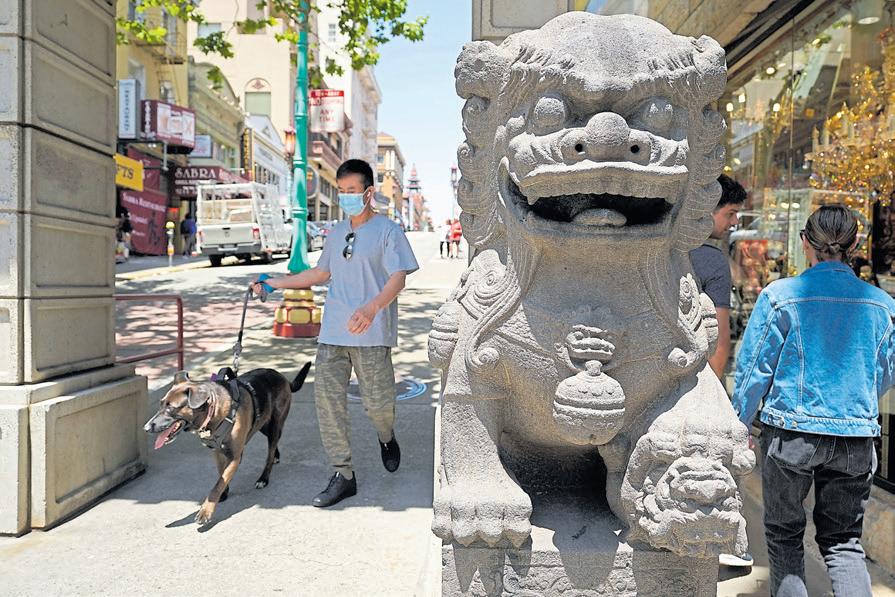 ERIC RISBERG/ ASSOCIATED PRESS
ERIC RISBERG/ ASSOCIATED PRESS
Concord’s leaders had had enough of the mocking.
C) The constant vibrations caused by wind and traffic eventually weakened and cracked the poles, which then were deemed a threat to public safety.
D) Birds kept flying into the poles and injuring themselves, prompting a suit by People for the Ethical Treatment of Animals.
7. One of the hallmarks of the iconic Palace of Fine Arts, designed by Bernard Maybeck, is the colonnades with sculptures of apparently weeping women, their backs turned and their heads resting on the top of the structures. Why do we not see their faces?
A) They add to the mystery and evoke a sense of mourning.
B) The faces were modeled after famous women, including the wife of thenPresident Woodrow Wilson, Edith Bolling Galt Wilson. Wilson wasn’t pleased with the likeness of his wife and asked that, to spare his wife ridicule, all the faces on the figures be turned away. Maybeck, figuring no one would recognize Mrs. Wilson anyway, complied.
C) To save money on a project that was already running over budget, the figures don’t actually have faces.
D) The figures all pay homage to one woman, the mistress of a high-ranking
city official; their faces are concealed to keep the relationship hidden.
8. Sculptor Steve Penetti took just over a week to create an 8-foot door on a San Francisco building that has delighted fans of the Harry Potter universe. What exactly did he make?
A) The entrance to the Chamber of Secrets
B) The door to Hagrid’s hut
C) The door to 12 Grimmauld Place
D) The door to the Lestrange vault at Gringotts
9. Sunset magazine has called Stockton’s Haggin Museum one of the “undersung gems of California.” The art and history museum has a number of impressive works by noted 19th-century painters, including Albert Bierstadt, Rosa Bonheur, WilliamAdolphe Bouguereau, J.C. Leyendecker and other American and European artists. It also has a historical oddity, a steamer trunk, left sitting on a railway station platform, that contained a singular item of interest. The trunk belonged to Emma LeDoux, who has the dubious distinction of being the first woman in California sentenced to death. What was inside the trunk?
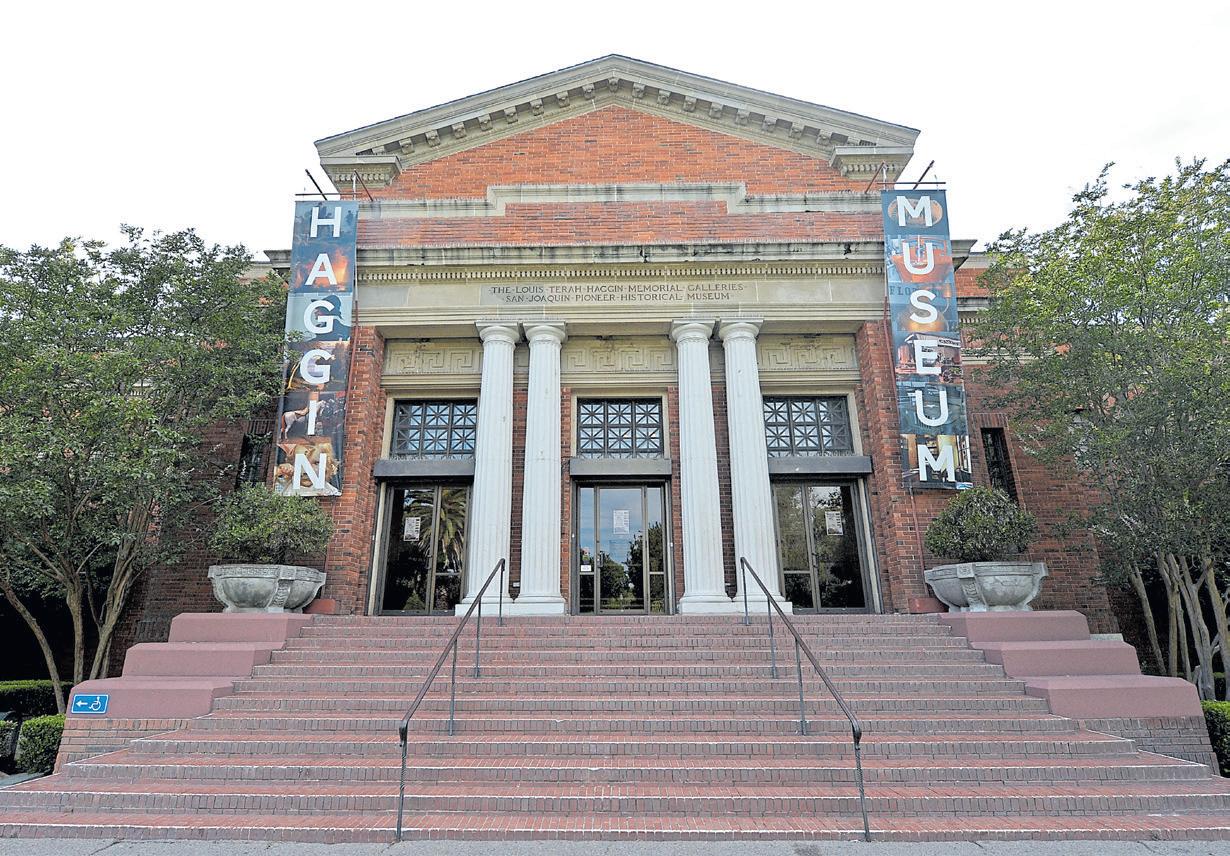
A) Gold and jewels taken during an infamous Tiffany heist
B) LeDoux herself, trying to escape the long arm of the law
C) The lost arc of the covenant
D) The body of LeDoux’s third husband, whom she poisoned, stuffed in the trunk and directed it be shipped to San Francisco, while she was busy with her fourth husband
10. China has the Great Wall, England has Stonehenge and the Bay Area has a combination of the two — a series of mysterious rock walls scattered here and there from just north of San Jose through the Berkeley hills. Some were built in straight lines, some had curves, and some included round or square structures. They’re estimated to be 100 to 200 years old, but could be older. Who built them?
A) Ancient artists who used the stones to create a variety of images depicting birds, horses and humans that could only be discerned from a great height.
B) Farmers and ranchers, who used what they had at hand to construct walls to hold in their cattle and sheep
C) Alien visitors who marked out landings for a future invasion
D) Lemurians from the lost continent of Mu — when the continent sank, the remaining survivors found their way to the Pacific Coast and started a new settlement, which also failed
E) Your guess is as good as ours
47 BAY AREA NEWS GROUP ARTSY
One of the treasures inside Stockton’s Haggin Museum is a notorious steamer trunk. DOUG DURAN/STAFF ARCHIVES
Sculptor Steve Penetti created an 8-foot door on a San Francisco building that has delighted fans of the Harry Potter universe. KARL MONDON/STAFF
didyou do?
the answers on page 70.
How
Find

Why murals matter

Public paintings on Bay Area walls provide inspiration, affirmation, comfort — and joy
BY JOHN METCALFE
In the wake of the destructive 2011 Japanese tsunami, Marina Perez-Wong was painting a mural in San Francisco of koi swimming in turbulent waters. As she was packing up for the day, she noticed a woman kneeling in front of the art.
“I thought she was graffitiing on my wall, and I was really upset, because it was supposed to be a healing mural,” she recalls. “Then I looked at her face and realized she was crying. She left something in front of it — she was Japanese, and I could tell it resonated with her on a different vibrancy than other people. That’s something that will always affect me.”
Such is the power of good mural art. And the Bay Area has tons, thanks to a thriving and barrier-crushing muralist community that encompasses generations. On any given day, rest assured brushes and spray cans are being swept over walls — in San
ARIC CRABB/STAFF
49 BAY AREA NEWS GROUP ARTSY
Rachel Wolfe-Goldsmith stands in front of a mural she created along Telegraph Avenue in Oakland.

Francisco, Oakland, San Jose and far beyond.
How does one get sucked into this field? For Perez-Wong, who along with partner Elaine Chu runs the Twin Walls Mural Company, it traces to a daunting childhood.
“I had a rare cancer as a kid and spent the first five years of my life mostly in the hospital,” where the walls were sterile white or gray, she says. “But then I would come home to the Mission, and there was all this color and vibrancy. The murals that resonated most for me were the ones told by women, especially Chicana women or stories from people from Latin America.”
The Mission, it turns out, played a pivotal role in the development of modern murals. New Deal-era murals once tended to dominate in the city; they were often located inside buildings and depicted historical scenes that ignored society’s complexities. (One in Coit Tower celebrated that thing California is most famous for, an all-white agricultural workforce.)
“People could see them while waiting in line to pay a traffic ticket or get a sentence or whatever,” says Tim Drescher, a mural historian in Berkeley. “The difference happened with the late ’60s. It
was a product of the politicization of our lives. And people suddenly realized they could be painting outside, so they started painting outside.”
Artists in the Mission — many of them Latinos continuing traditions they’d seen in their homelands — led the charge with “community murals” that grappled with politics and identity. One influential group in the 1970s was Las Mujeres Muralistas, composed of local women fed up with sexism in the mural community.


“At that time, it wasn’t something women did — they didn’t go outdoors and paint murals,” says Drescher. “It was forbidden on all kinds of levels, not the least of which was the families. These women were very gutsy to go out and paint in spite of what their parents were telling them not to do.”
Perez-Wong and Chu were mentored by an artist who collaborated with Las Mujeres Muralistas — Susan Cervantes of San Francisco’s Precita Eyes organization — and credit their motivation to her and other women in their lives.
“In a lot of our murals, we have this theme of bad-ass women and nonbinary people,” says Perez-Wong. “We can’t help it, because we’ve got to give voices to those who came before us and
51 BAY AREA NEWS GROUP ARTSY
These murals on 18th Street near Valencia Street in San Francisco were painted by muralists Elaine Chu and Marina Perez-Wong of Oakland-based Twin Walls Mural Company. RAY CHAVEZ/STAFF
paved the way but also to the future generation.”
In San Jose, you’ll find a large mural celebrating another powerful woman, the late Supreme Court Justice Ruth Bader Ginsburg, located on the side of a high-rise by artist and Stanford biomedical engineer Chuba Oyolu.
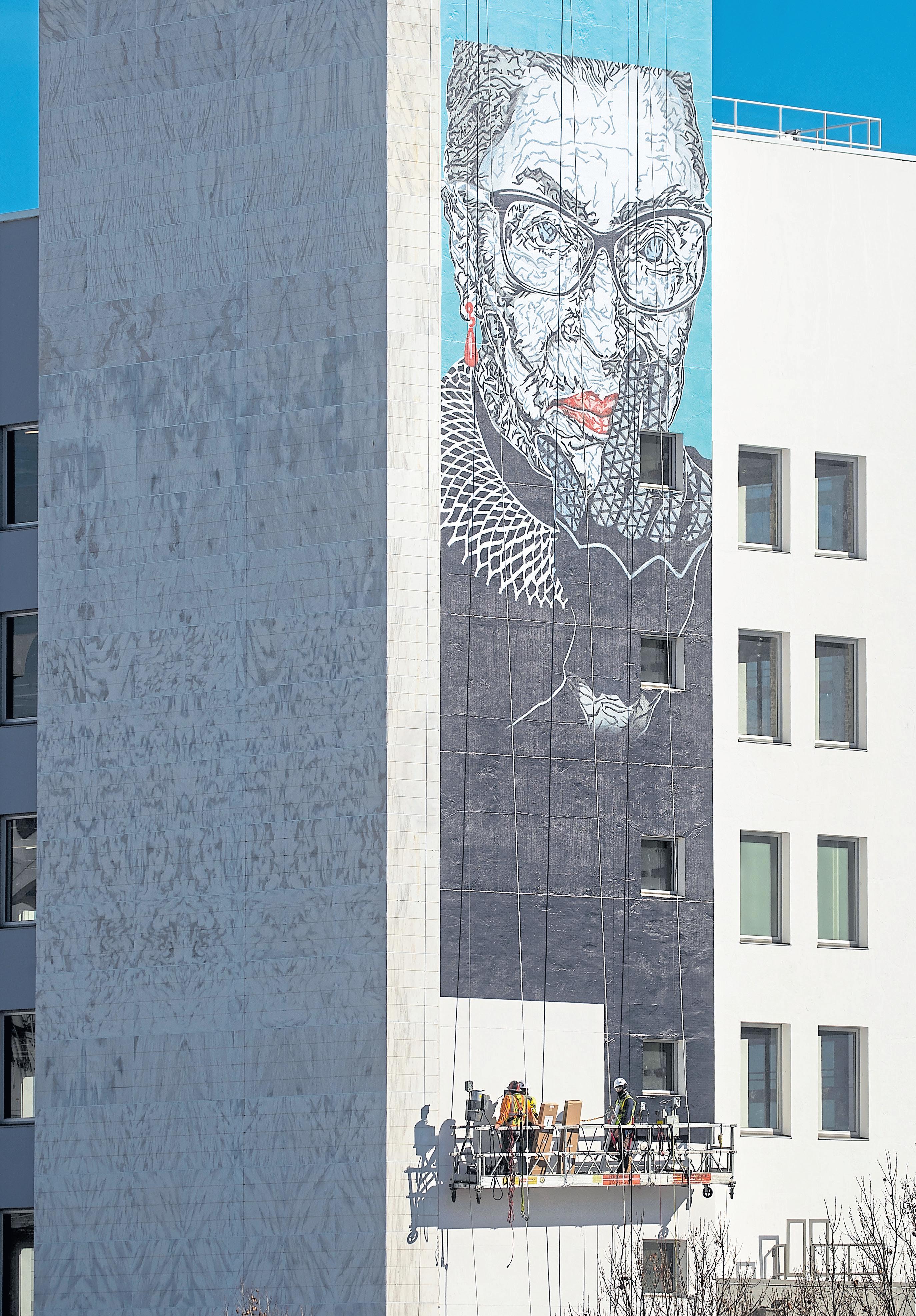
“We wanted something that everyone could look up to in San Jose as a beacon of hope,” he says. “We started kicking around figures like Einstein and the Bay Area’s own Steve Jobs. But RGB did so much and is really an inspirational figure, and I don’t think there are many murals of inspirational female figures around the world, so I wanted to give her a big shout-out.”
Oyolu took a month using modern methods to apply the mural. But he was drawn to the craft by someone with no such wizardry: Michelangelo. “I’m just really struck by how he managed to do these spectacular works of art all those years ago, when there were no cranes, no electricity and none of the creature comforts we have today.”
One of the most significant moments for murals came as recently as 2020, after the police murder of George Floyd. Tens of thousands of murals were painted for Black Lives Matters throughout the world, with prominent ones appearing across Oakland. (You’ll find them featured in a new book from Nomadic Press, “Painting the Streets: Oakland Uprising in the
52 ARTSY BAY AREA NEWS GROUP
Bay Area artist Chuba Oyobu created a portrait of the late Supreme Court Justice Ruth Bader Ginsburg on a Santa Clara Street high-rise undergoing renovation in downtown San Jose.
KARL MONDON/STAFF ARCHIVES
Time of Rebellion.”)
“I remember being downtown the first night the riots started and then driving through the next day and seeing people starting to paint,” says Rachel Wolfe-Goldsmith, creative director at the Bay Area Mural Program. “I think we were just processing so much pain collectively that, as artists, that’s how we express ourselves and get our voice out there.”
Art literally popped up on the streets of downtown Oakland with an immense Black Lives Matter road painting on 15th Street. Despite being sanctioned, that one got attention from the authorities, Wolfe-Goldsmith says.
“Police came in an unmarked van and stole all of their paint and drove off with it toward the police station.” The mural’s organizers followed them to complain. “They brushed it off like they weren’t doing anything and gave the paint back.”
Oaklandbased Twin Walls Mural Company has created public artworks across the Bay Area. Last month, artists Elaine Chu, right, and Marina PerezWong, back, were working on a colorful mural on San Francisco’s Burnside Avenue.
 RAY CHAVEZ/STAFF
RAY CHAVEZ/STAFF
There was an explosion of fresh paintings on plywood that businesses had hastily erected over their windows and doors to thwart property damage. “The plywood was ugly, and paintings were better than that,” Wolfe-Goldsmith says. “So it seemed like a no-brainer.”
DeVante Brooks is a West Oakland artist who collaborates with AeroSoul, an international collective with ties to the Black Panther Party. During that contentious summer, he helped paint a mural at the Oakland Greyhound station with a quote from Huey P. Newton and Bobby Seale’s 10-point program: “We want an immediate end to police brutality and murder of Black people.”
“Around that time, it was a lot of personal growth for me to take this leap into being a full-time artist,” Brooks says. “The work speaks to bigger issues like homelessness and police brutality, but also spoke to
53 BAY AREA NEWS GROUP ARTSY

54 ARTSY BAY AREA NEWS GROUP
me on a personal level about potential and being able to produce with a message beyond something that’s just aesthetically pleasing.”
For her part, Wolfe-Goldsmith completed a mural on the side of Oakland’s Tribune Tower of a woman performing traditional African dance moves.
“For me, being of mixed-race and Black heritage, anybody during that time was going through so much s--- with the pandemic and then doubly with everything else, it was a space to declare joy and passion,” she says. “It became this energetic hub for people to stop by and take a break from all the madness that was going on.”
It’s the nature of the art that these murals will all eventually disappear — painted over, demolished, eaten away by the weather. Still with luck, they inspired people during their moment in the public eye.

“Sometimes it feels futile to be up on a ladder with your brush, thinking, Am I really doing anything?” says Wolfe-Goldsmith. “But you see people walk by and literally start screaming out of excitement and validation for seeing a story told or seeing their auntie or the history of the Black Panther Party. You realize it really does matter, and it really does affect the collective consciousness of our spaces.”
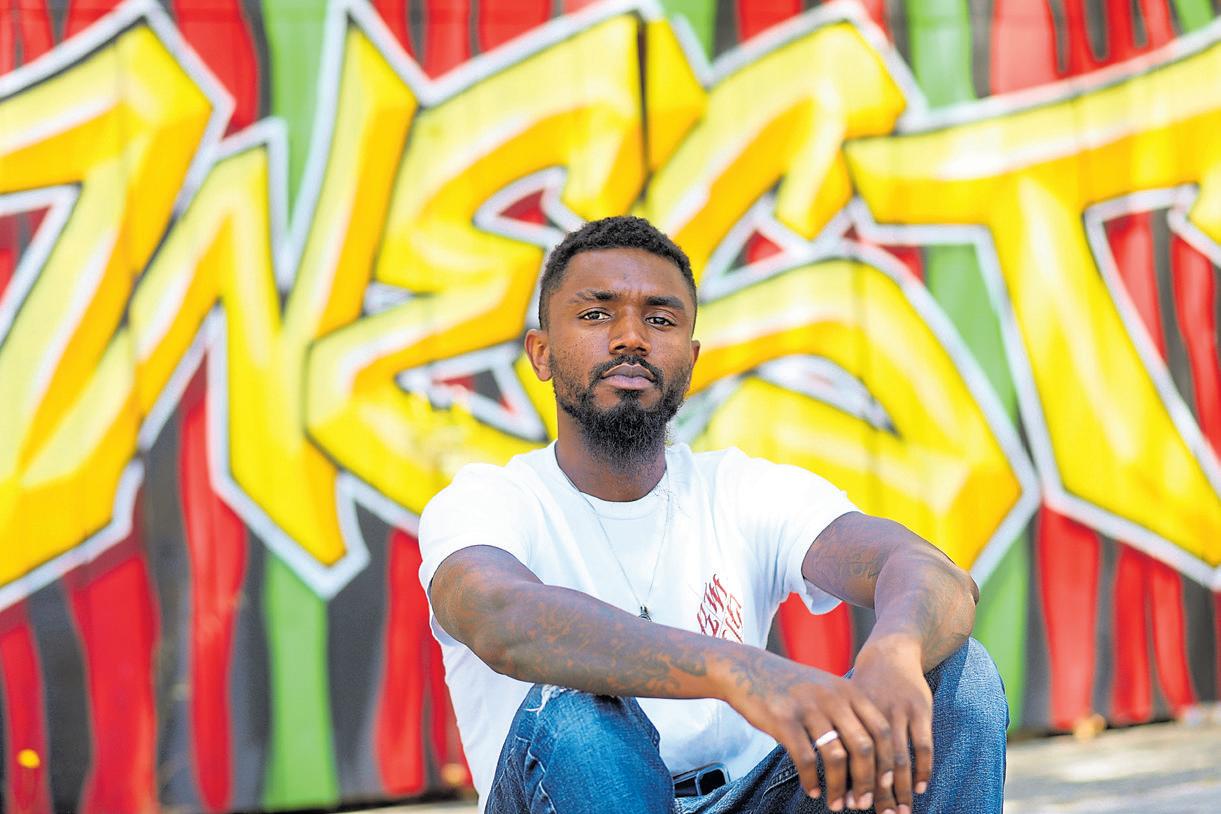
55 BAY AREA NEWS GROUP ARTSY
DeVante Brooks, above, painted this vibrant mural along 14th Street in Oakland, left.
ARIC CRABB/STAFF
“ The work speaks to bigger issues like homelessness and police brutality, but also spoke to me on a personal level about potential and being able to produce with a message beyond something that’s just aesthetically pleasing.”
—DeVante Brooks
The ground is his canvas: Sidewalk chalker’s art keeps him on his knees
BY LINDA ZAVORAL
Beauty can be fleeting. A sunset’s coral and azure streaks, overtaken by darkness. A vibrant red leaf, blown away by the autumn winds. And a colorful alfresco artwork that will soon fall victim to rain, sprinklers — or even just the feet of pedestrians.
Using chalk on pavement to create transient works of art is Clifton Gold’s side hustle. By day, the Milpitas-based artist works in printing production for San Jose State University. On weekends, he travels to sidewalk art festivals, from community-based Bay Area events to invitation-only festivals, including Santa Barbara’s prestigious I Madonnari Italian Street Painting Festival.
So we asked him for an insider’s view of the genre.
QWhat do you love about this medium?
AThe ephemeral nature.
Because the work is not permanent and the supplies are inexpensive, it allows you to experiment and try techniques and subjects you wouldn’t normally do on paper or canvas. It’s fun to get together with like-minded people, create colorful work for the audience and enjoy the sunshine and live music!
QYou’re a color-blind artist who has succeeded in a visual, vibrant field. Tell us about that.
AYes, I am color blind. Browns, reds and greens look the same, so do blues and purples and lime greens and yellows. Family
and friends help me label my chalk. Over time, I’ve also learned what colors are where in the various brands’ boxes, and I have an app on my phone that also helps detect colors.
That challenge has led me to create my own style and chalking techniques. My core art style is inspired by pen-and-ink drawings and doodle patterns, so I use a lot of black chalk in the base of my pieces, then I accent with colors and white highlights. It’s kind of like a giant coloring book. The audience sees the piece develop from black and white to glowing color throughout the event.
QWhich of your sidewalk creations stand out in your memory?
A“The Garden Keeper” that I did at the Chalk Festival in Venice, Florida, in 2019 was one of the most challenging but rewarding experiences. This was the largest and most detailed piece I’ve done (12 feet by 12 feet), and the first two days of the festival were riddled with rain and strong winds. But the piece came out better than I expected and was well-received. I also love doing the Chalk It Up festival in Sacramento with my nieces. We always create a piece based on their ideas, and
they help do all the coloring.
QWhat would you like people to understand about this genre?
AI don’t think people realize how physically challenging it is. Imagine doing planks and burpees all day long — that’s pretty much what it’s like to chalk a mural, crawling around on the ground all day. You are at the mercy of the weather. One day at the Italian Street Painting Marin event in San Rafael in 2018, the temperature got up to 100 degrees, and by noon, the asphalt itself was 130 degrees. You are also at the mercy of attendees who aren’t watching where they’re going, so sometimes they walk right across your mural, and you have to fix the footprints.
QHow does it feel to see your art vanish?
AWhen you first start doing it, it’s a little sad. But you get used to it. Some festivals leave the murals and the environment eventually wears them out over a couple weeks, so you get to see them age. Other event organizers have to wash the streets immediately afterward, so you see the piece disappear in five seconds!
GOLD’S 5 BEST TIPS FOR AMATEUR ARTISTS
Use a light touch with the chalk. Lay down a very thin layer, then blend it into the pavement with a scrap piece of carpet, craft foam or your finger to get a solid color and fill in the crevices.
It’s all about layers. Slowly build up the chalk, colors and highlights, applying the chalk lightly each time. This will keep the dust down, and you will use way less chalk.
Apply the darkest colors first, then layer the lighter colors on top. Why? Because dark chalk specks that get on top of light colors look like specks of dirt. However, specks of light color chalk on top of darker chalk look like sparkles, creating a glowing effect.
Work first on the focal point, on what you want the audience to see first. Usually, it’s the eyes. Then you can work out from there. That way, you’re not stepping over completed areas to get to other areas or painting yourself into a corner. And, if you run short on time, you can work looser in the outer areas.
Use knee pads, wear a hat, apply sunscreen, drink lots of water. And take plenty of stretch breaks!
56 ARTSY BAY AREA NEWS GROUP
Q&A
Clifton Gold created a chalk artwork titled “Starry Night Astronaut” at a pre-pandemic Italian Street Painting festival in San Rafael.
PHOTO COURTESY OF JIM GOLD
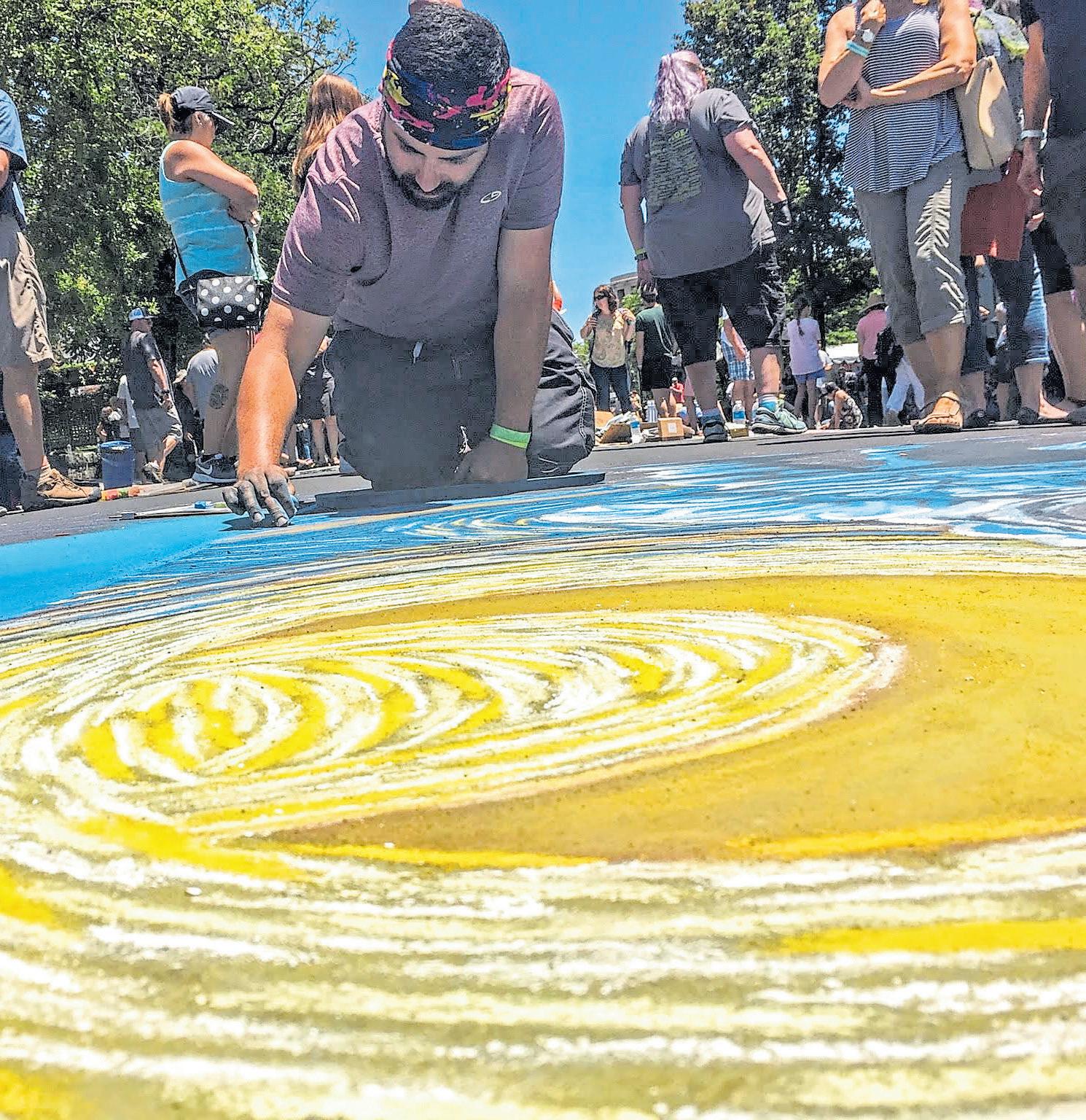
Uncommon archives

Museums with unique missions mount exhibits around the Bay
BY JOHN METCALFE AND LINDA ZAVORAL
The Bay Area is home to all the expected museums, their galleries brimming with art of every variety, be it modern, ancient or somewhere in between. But in a galaxy far, far away — that would be Petaluma — rests Darth Vader’s codpiece, along with half a million other treasures in the largest “Star Wars” collectibles museum in the universe. In a Berkeley archive of “curious scents,” there’s extremely expensive animal poop used in highend perfumes, while the Beethoven Center in San Jose boasts a lock of the composer’s hair.
If you’re seeking an unusual learning experience, there are tons of opportunities in the Bay Area, thanks to our wealth of eccentric and obscure museums. Here are nine of the best.

59 BAY AREA NEWS GROUP ARTSY
ILLUSTRATION BY GETTY IMAGES AND STAFF PHOTOS
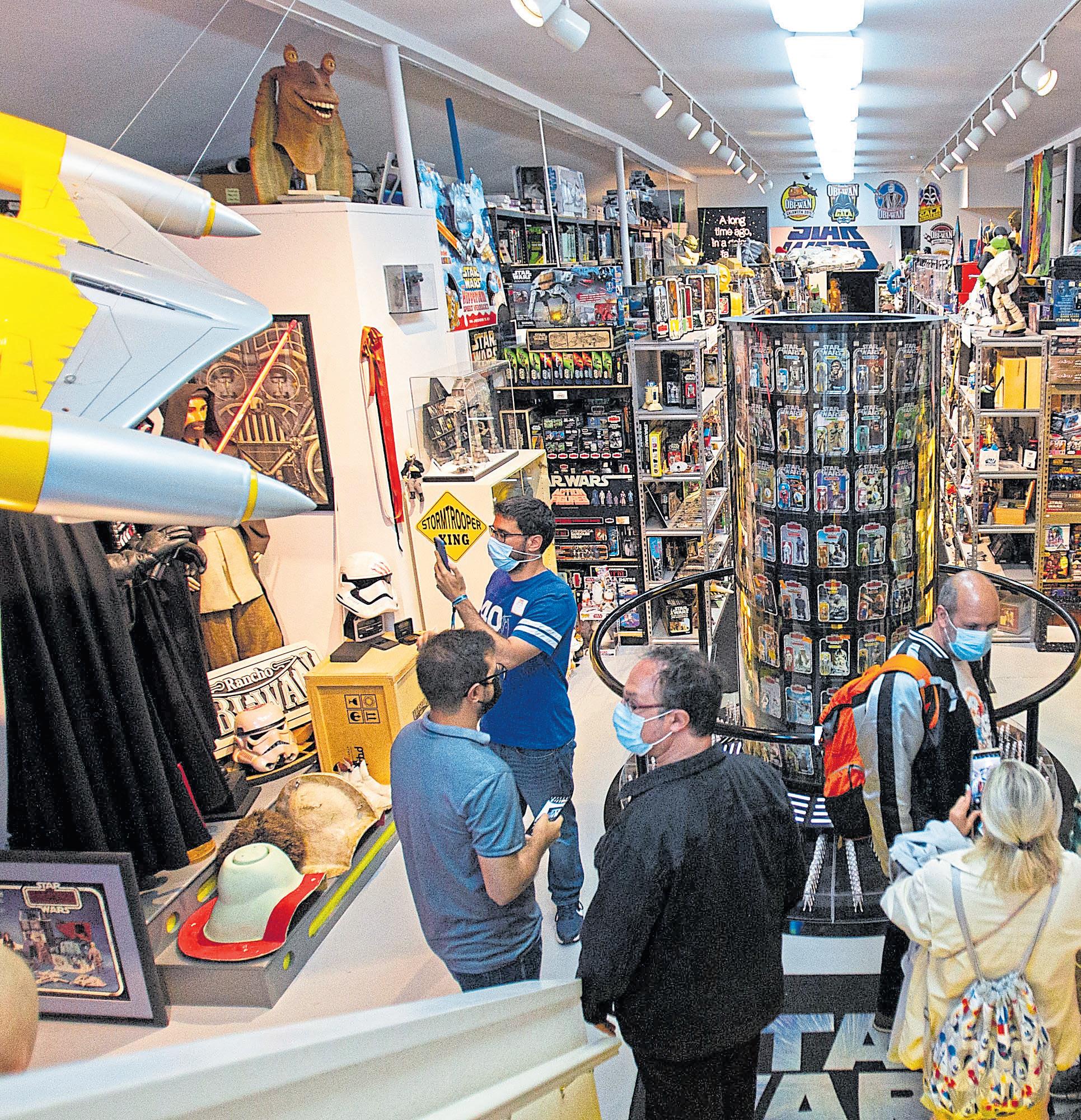
IRA F. BRILLIANT CENTER FOR BEETHOVEN STUDIES, SAN JOSE
The most hands-on Beethoven museum in the world isn’t the one in Bonn, the great German composer’s birthplace, or in Vienna, where he wrote many of his celebrated works.
No, it’s located in San Jose, on the (da-da-da-dum) Fifth Floor of the Dr. Martin Luther King Junior Library, jointly operated by San Jose State University and the city. Here, the museum showcases the extensive Ludwig van Beethoven collection amassed by the late Arizona developer Ira F. Brilliant, who was determined that his precious first editions and memorabilia the largest such grouping outside Europe — be available for music students and Beethoven fans to study.

What sets this one apart from other scholar-centric museums is the accessibility of this collection of scores, letters, concert posters, portraits, recordings, engravings, medallions and even a bronze replica of his life mask. “In addition to our regular exhibits, we usually have a Beethoven manuscript or some other rare item on display,” curator Patricia Stroh says. “Right now, we are featuring a letter written to his publisher Steiner in 1822.”
The keyboard instruments are a big draw, Stroh says. Anyone — even youngsters — can walk in and take their turn at a modern-day harpsichord or clavichord. And if you’d like to hear the real deal, stop by for a front-row seat on the days when Richard Sogg, a

61 BAY AREA NEWS GROUP ARTSY
Above: Anne Neumann, president of Rancho Obi-Wan, shows visitors a Star Wars book during a tour in Petaluma. Left: Rancho Obi-Wan in Petaluma holds the largest collection of Star Wars memorabilia in the world.
WANGYUXUAN XU/STAFF
volunteer docent, plays the historic instruments, including an 1825 Jakesch fortepiano.
Don’t miss: A prized lock of Beethoven’s hair. The strands, from 1827, are protected in their original frame under convex glass.
Details: Admission is free. Open from 11 a.m. to 6 p.m. Wednesday, Thursday and Friday and by appointment on other days (closed weeks of July 18, Aug. 8 and holiday weeks). Groups of up to 20 welcome; make reservations by emailing beethovencenter@ sjsu.edu. For Sogg recital dates, check the website, www.sjsu.edu/ beethoven/index.php. Dr. Martin Luther King Junior Library, Fifth Floor, 150 E. San Fernando St., San Jose.
RANCHO OBI-WAN
The world’s largest collection of “Star Wars” memorabilia is down a country road in Petaluma in what used to be chicken barns. Think of the most esoteric figure from the franchise — say, the

wise Plo Koon from planet Dorin, known for protecting clones — and it will be represented here.
“I do have the Jedi Master Plo Koon mask made by a fan in Ireland and gifted to me,” says Steve Sansweet, founder of Rancho ObiWan, a collection of 300,000 to half a million “Star Wars” artifacts (after a few hundred thousand, perhaps you stop counting).
Sansweet, the erstwhile head of fan relations for Lucasfilm, has always had the collector’s gene.
“There were baseball cards and comics as a kid, and Japanese rockets and robots and space toys,” he says. “Then ‘Star Wars’ came out and completely hooked me.”
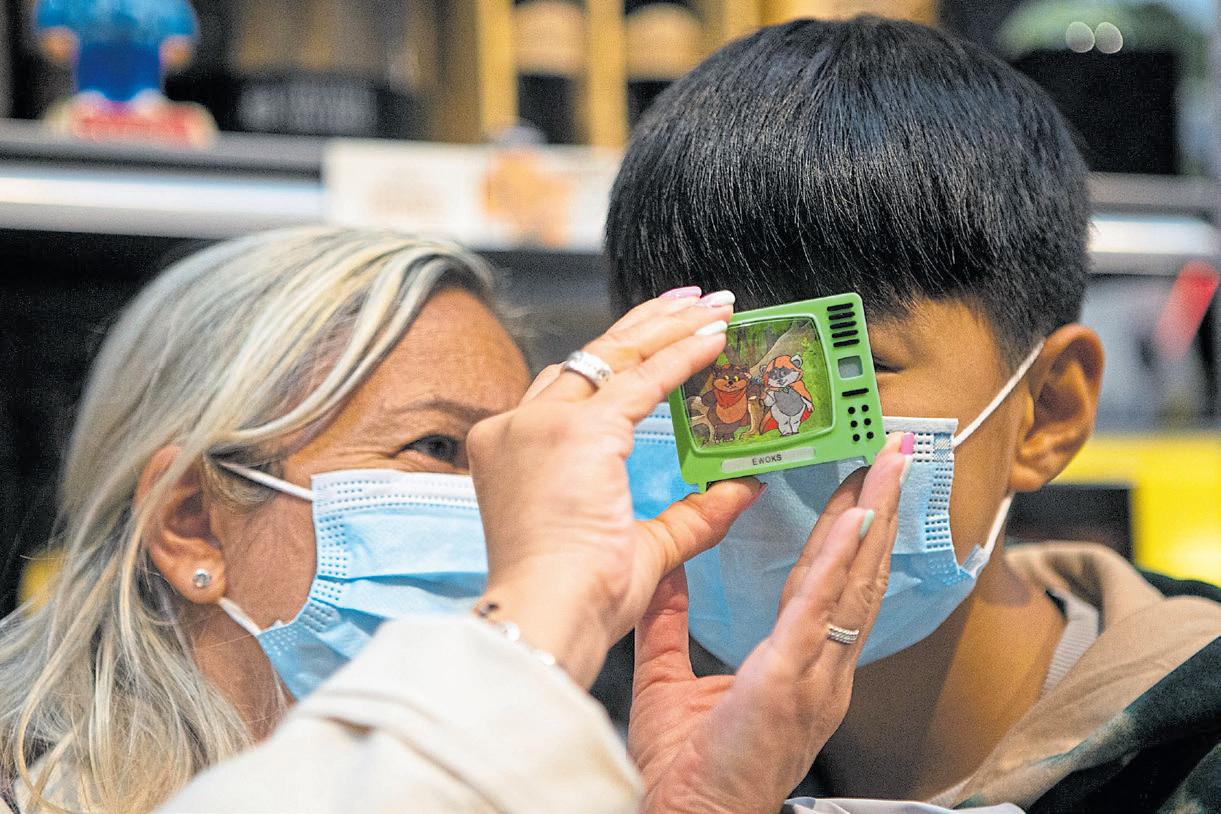
Today, people from Japan and Dubai flock to Sonoma to share in his passion. There’s a Darth Vader helmet likely used in “The Empire Strikes Back,” an animatronic Cantina Band that plays music and dances, and vintage action figures people point to and exclaim, “I had that as a kid!” At the conclusion of the tour, there are arcade and pinball games set on free play.
The exhibits aren’t arranged in chronological or movie order but
62 ARTSY BAY AREA NEWS GROUP
Above: Esther Jerez, shows her son, Vicente Estrelles, 11, the Ewok slide viewers during a Rancho Obi-Wan tour in Petaluma.
Right: The Marin Museum of Bicycling in Fairfax draws fans from all over the world. WANGYUXUAN XU/STAFF
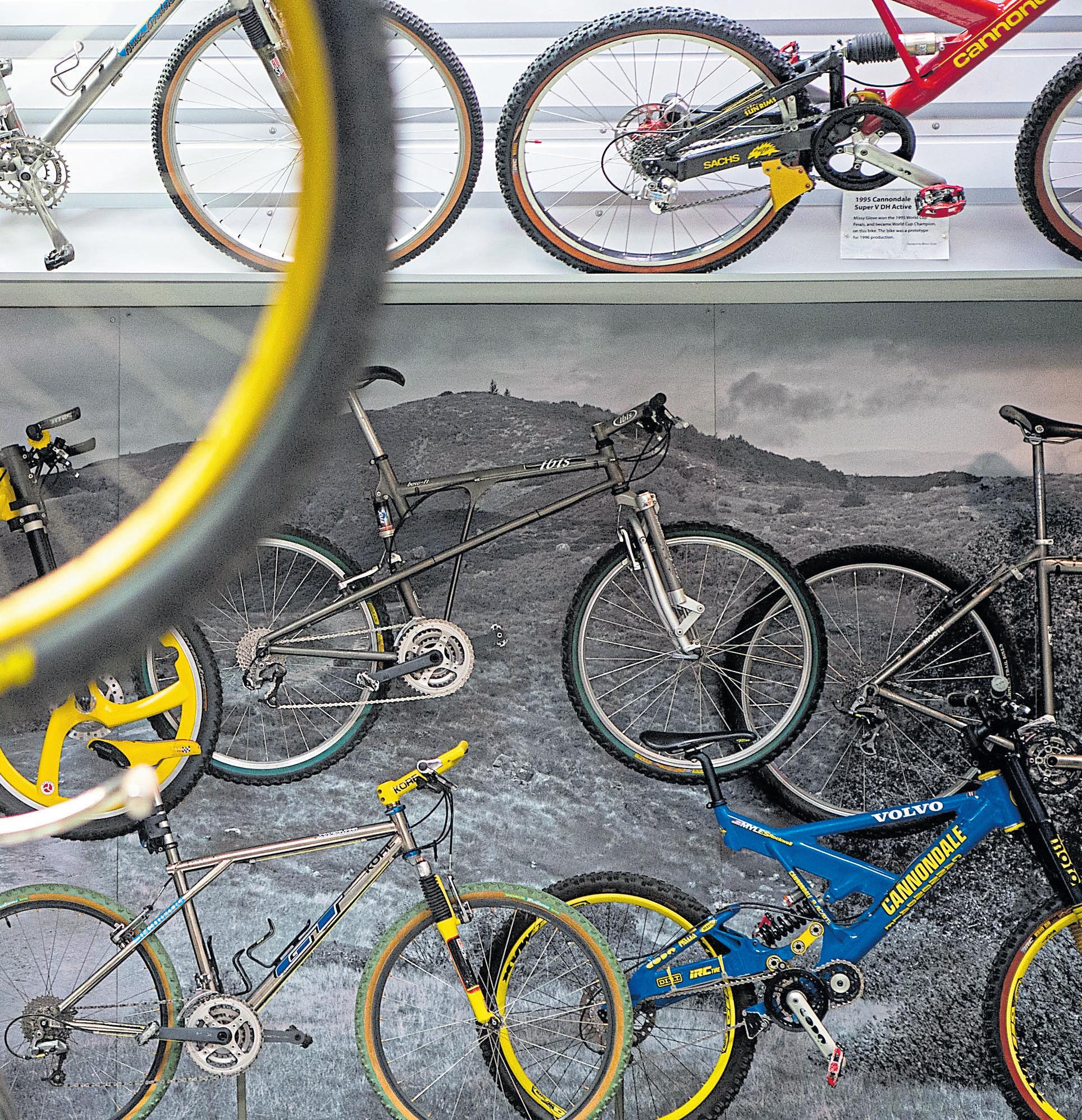
in a way that provides narrative enjoyment. “The fun in doing the tour is, it’s two to three hours led by a docent, and it tells the story of the collectibles — how they came to be and how they came to be in my possession sometimes, such as movie props and art and prototypes,” says Sansweet.
“We frequently get spouses who accompany a ‘Star Wars’ collector and at the end of the tour, they say, ‘I had no idea it’d be this much fun!’ And that does my heart good.”
Don’t miss: An original screen-tested Darth Vader codpiece. Enough said.
Details: 659 Chapman Lane, Petaluma; tours ($75) are offered at 10 a.m. on Saturdays and should be booked at ranchoobiwan.org
NILES ESSANAY SILENT FILM MUSEUM, FREMONT
You may not know the name of the trailblazing silent-film studio Essanay, but you surely are familiar with its top box-office draw.
Charlie Chaplin signed with the Chicago-based studio at the age of 25, then traded the Midwestern weather for the Mediterranean climate and rolling hills of Niles, Essanay’s western outpost. He made several “two-reelers,” including “The Tramp,” in 1915 in Fremont before heading to Hollywood for bigger bucks.
But Fremont has never forgotten the charming vagabond, nor Essanay co-owner G.M. “Broncho Billy” Anderson, who was the first cowboy film star.
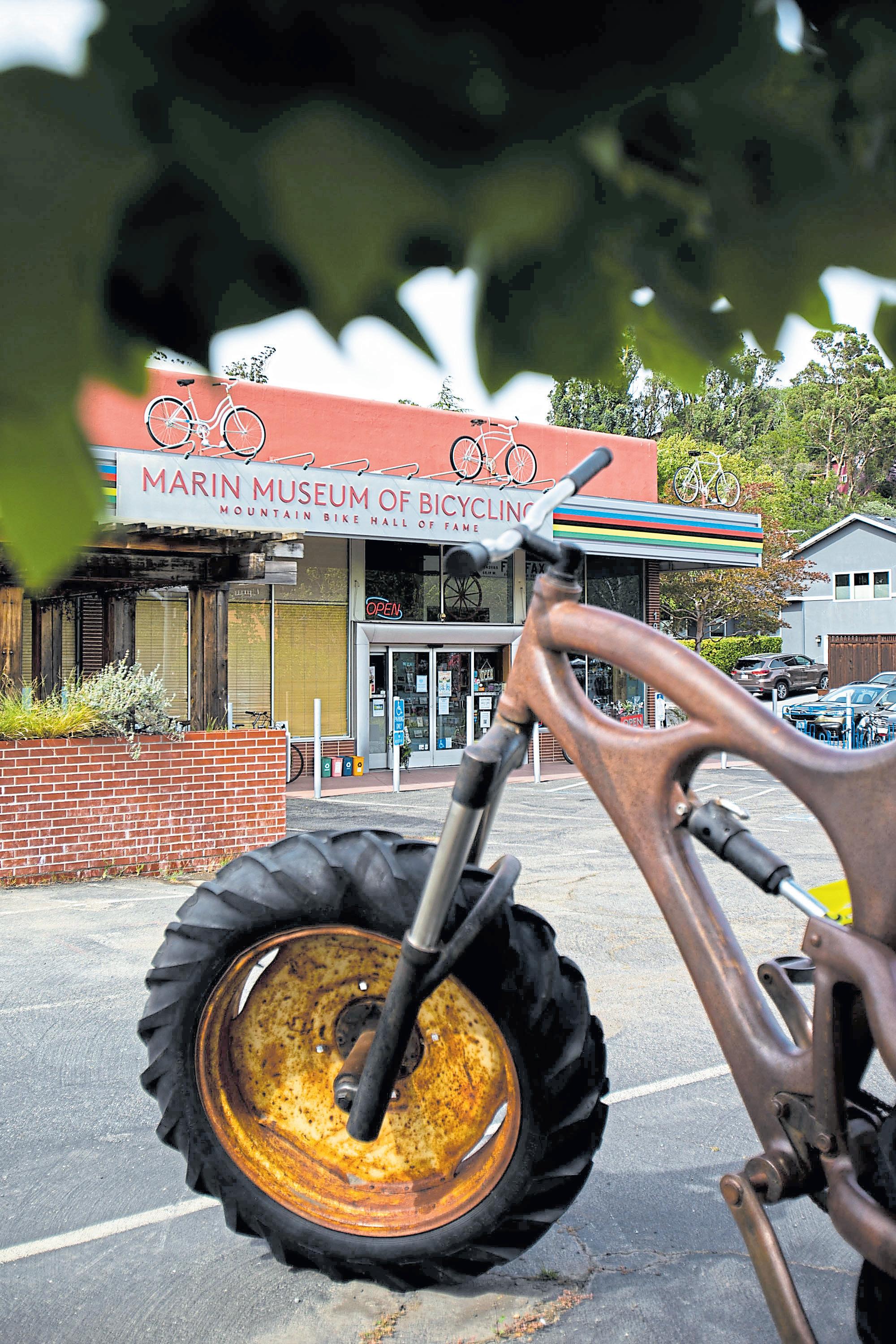
The city’s Niles Essanay Museum, which is tucked inside a circa 1913 nickelodeon, the
and evolution of the bike.
64 ARTSY BAY AREA NEWS GROUP
The Marin Museum of Bicycling in Fairfax is a bicycle history museum and cultural center that showcases the birth
WANGYUXUAN XU/STAFF
Edison Theater, pays tribute to both actors and the silent-film era with its collection of vintage movie cameras, projectors, posters and memorabilia. Historian and co-founder David Kiehn has amassed a collection of roughly 5,000 films. An expansion in 2017 added 1,500 square feet of space, with enough room for additional permanent exhibits.
Charlie Chaplin Days made a reappearance in June, and the museum will host the Broncho Billy & Friends Silent Film Festival on July 30-31. “If things are looking good COVID-wise,” program director Rena Azevedo Kiehn said, “we hope to start our regular Saturday night silent films the weekend after Labor Day. We also hope to have our Second Sunday Laurel & Hardy and Little Rascals talkie afternoon shows starting in September as well.”
Don’t miss: The honorary Oscar
bestowed on Broncho Billy for being a “motion picture pioneer.”
Details: Museum and store hours are noon to 4 p.m. weekends at 37417 Niles Blvd., Fremont. https://nilesfilmmuseum.org/
THE MUSEUM OF INTERNATIONAL PROPAGANDA
Having grown up in the Czechoslovak Socialist Republic, Tom Areton is acquainted with repressive regimes. “There was only one political party — the Communist party — and when we had elections, there was only one candidate,” he recalls. “We joked the only ‘election’ you had is you could vote on Friday or Saturday.”
It’s fitting, then, that Tom and Lilka Areton now curate an intriguing collection of historical posters and anti-Semitic German tabloids and propaganda films
Instructor Kim Davis, center, watches over students Rebecca Grekin, left, and Hanna Lachnitt, right, during a class at the Lace Museum in Sunnyvale. The 12-Hour Introduction to Bobbin Lace workshop was the first inperson class at the museum in nearly two years.
 ARIC CRABB/STAFF
ARIC CRABB/STAFF
(many of them comedies, for some strange reason).
The museum is divided into chapters, including “Leader Idolization.” “You will see pictures of Stalin holding a little child, or Che Guevara looking otherworldly like a rainbow, or Hitler with children bringing him violets,” Areton says.
There’s content from North Korea, as it’s one of the 80-plus countries where the Aretons have traveled to collect museum material. Minders were with them at all times, and to get in, they had to bow and place flowers at the feet of a 60-foot-tall statue of Kim Il-sung.
The museum covers American politics, but as a rule, all the exhibits focus on the 1900 to 2000 span, avoiding the world’s contentious modern era. “We didn’t want it to become a political battleground and have people heave bricks through our front window and things of that sort,” he says.
That’s OK, because propaganda is timeless. “The purpose of this museum is not to turn you into a socialist or capitalist or Democrat or Republican,” Areton says. “The purpose is to teach you that propaganda is all around you and how to become sensitive to it.”
Don’t miss: In the 1950s, Eastern Europe’s crops were attacked by an insect called the Colorado potato beetle. Propagandists noticed the bug had stripes on its back like the American flag and spun the invasion into a narrative of imperialists air-dropping pests to strangle the young Socialist economy. Areton had to go out into potato fields as a school kid to collect these bugs by hand. “It was all a lie, by the way.”
Details: Open from 3:30 to 6:30 p.m. Thursday-Friday and noon to 5 p.m. Saturday at 1000 Fifth Ave. in San Rafael. Free admission; museumofpropaganda.org
THE LACE MUSEUM, SUNNYVALE
Thousands of the Bay Area’s most beautiful, most intricate, most fragile treasures can be found in a most unexpected spot — behind the doors of a small, nondescript storefront.
The Lace Museum, in a Sunnyvale strip mall, is the only museum in the Western United States devoted to the preservation of lace and the art of lace-making. It was co-founded in 1981 by local artisans Cherie Helm and Gracie Larsen.
The nonprofit center has in its care more than 10,000 pieces, some dating back to the 1600s, from handkerchiefs and gloves to table runners and bread-basket liners to wedding gowns and sculptures. “If you can imagine it with lace, we probably have one,” managing director Kim Davis says with a laugh.
In the pre-pandemic days, museum staffers would pull from the vast collection and curate a few exhibitions a year. One, with the charming title of “Frills, Frippery and Finery,” featured lace collars, fans and other accessories. Another was “Up to Your Neck in Lace: Collars, Jabots and More,” with
65 BAY AREA NEWS GROUP ARTSY
examples worn by both men and women. “Night and Day” showcased 90 years of lacy sleepwear and lingerie, with examples from 1860 to 1950.
The shift in 2020 to online activities has been popular, so the museum is continuing to host virtual workshops, informational Museum Mondays on Facebook, a virtual store and Etsy sales.
But in-person options are ramping back up. Lace-making classes for various skill levels resumed in June, and a current display depicts examples of the ancient lace technique known as sprang.
Don’t miss: Belgian war lace from World War I, known as “subversive lace” because symbols from Allied countries were woven into the designs. “It’s extraordinary,” Davis says.
Details: Admission is free, but donations are always welcome. Open from noon to 2 p.m. Wednesday and noon to 3 p.m. weekends at 552 S. Murphy Ave., Sunnyvale. https:// thelacemuseum.org/
TRUHLSEN-MARMOR MUSEUM OF THE EYE
One of the few surgeries documented in ancient civilizations was for cataracts. It was called “couching” — somebody would thrust a needle or thorn into your eye to displace the clouded lens. “They did it without anesthesia or antibiotics — they were just going for it,” says Jenny Benjamin, director at the Truhlsen-Marmor Museum of the Eye.
Benjamin, who used to work at an ears-nose-and-throat academy (she jokes she’s working her way up the body), is responsible for curating 38,000 artifacts at the Bay Area’s only medical museum, which indeed has a display of couching needles. The museum presents the history of eyes and ophthalmology ranging from an ancient Egyptian amulet depicting the god Horus — who had his eyeball clawed out (you should’ve seen the other guy, he lost a testicle) — to 3D footage of retinal microsurgery.
“You can see how a surgeon sees a field of surgery — it’s super fun,” she says.
Historical exhibits cover cupping and bloodletting, once believed to benefit vision, and woodcuttings of weird full-face masks that supposedly corrected strabismus (misalignment of the eyes). There are displays about modern retinal implants and gene therapy, plus information about why people don’t need to worry
about their eyeballs popping out of their head like they do in the movies.
“We have a display on ocular plastic surgery with a beautiful video that shows the bone structure of the eye as it rotates in the skull,” she says. “That’s what we use to show people why you can’t pop your eye out.”
Don’t miss: The museum doesn’t have any “wet specimens” like cor-
Bobbins of thread are turned into a lace pattern during a class at the Lace Museum in Sunnyvale.

neas in jars but does have a giant artwork of prosthetic eyes. “We call it our ‘selfie wall’ — some people just walk in to take a photo of it,” says Benjamin.
Details: Open from 11 a.m. to 4:30 p.m. Thursday-Sunday at the American Academy of Ophthalmology, 645 Beach St., San Francisco. Free admission; aao.org/museum-of-the-eye
66 ARTSY BAY AREA NEWS GROUP
ARIC CRABB/STAFF
PACIFIC PINBALL MUSEUM
It’s pinball paradise, and you don’t need a pocket full of quarters like you did when you were a kid.

This Alameda museum showcases a rotating, chronological collection of 100 colorful, clanging pinball machines — all of them playable. You pay one admission price, and then you’re good to go. (But pace yourself. Fans on Yelp have reported very sore wrist ten-
dons after a long day here.)
Nostalgia abounds, from 1946’s “Humpty Dumpty” for the real old-timers, to the 1992 Bally “Addams Family” machine, which the museum operators say was the highest-selling “flipper” pinball game of all time, to 2016’s “The Hobbit.” Sports and action standouts from the 1970s include “Evel Knievel” from 1977 and “Harlem Globetrotters” from 1979.
“With so many games on display, we regularly have people run across a game they haven’t thought about in years and are instantly transported back in time,” program manager Chris Rummell says.
Pinball’s earliest days are represented in the roped-off “display only” area, where you’ll find a 1931 “Whiffle Board,” the first commercial coin-operated pinball machine, and a 1936 “Bally Bumper” that had been confiscated by Oakland police. The oldest dates from 1898, and it’s a game with a regal name, the “Montague Redgrave Bagatelle,” a precursor to pachinko and pinball.
Rummell says the museum is always evolving. “We recently installed a new exhibit, Oddball, that showcases experiments in pinball design and games with unusual features.”
Don’t miss: The “Freedom” clear pin, one of only five in existence, was custom-built by the museum. Housed in clear acrylic, the inner workings are visible as visitors play the game.
Details: Open from 11 a.m. to 9 p.m. Tuesday-Thursday and Sunday, 11 a.m. to 10 p.m. Friday-Saturday at 1510 Webster St., Alameda. All-day unlimited play runs $12 for kids ages 5-12; $15 for students, seniors, military, teachers and first responders; $22 for adults; and $55 for a family pass. On Tuesdays there’s a two for $22 special. www.pacificpinball.org
MARIN MUSEUM OF BICYCLING
That crucible of calf-punishing cycling, Marin County, is also home to one of the best museums devoted to bikes.
“My friends and I had this desire to share the wonderful lost history of 19th-century bicycles and the contributions they gave to the world, with things like the ball bearing and the bush-roller chain and the differential,” says museum curator Joe Breeze. “So many things were invented for the bicycle, because it was the original freedom machine.”
A collection from the late Palo Alto NASA engineer Ralph Igler shows the evolution of the bicycle, from “boneshakers” that transferred energy from the road right into your crotch to “high wheels,” tricycles and the safety bike, an ancestor of the two-wheeled contraption we’re accustomed to today.
“It’s called a safety bike because the ones that preceded it were anything but safe. I think that’s where the term ‘header’ comes from — you’re perched way up there high above the fulcrum point of the machine,” says Breeze. There are famous bikes that crossed championship finish lines, historical rainbow jerseys and reportedly the world’s first aluminum bike made here in Fairfax in the 1970s. Needless to say, the museum has plentiful bike racks and offers free locks, too.
Don’t miss: The Mountain Bike Hall of Fame draws visitors from all over the world. It’s more than 100 linear feet of bike paraphernalia chronicling the birth of mountain biking in Marin County up to the modern age.
Details: Open from 11 a.m. to 5 p.m. Thursday-Sunday at 1966 Sir Francis Drake Blvd. in Fairfax. Admission is $10; mmbhof.org.
AFTEL ARCHIVE OF CURIOUS SCENTS
In one corner of this charmingly offbeat Berkeley museum crouches a replica of a beaver. Why is it there? “Beaver balls,” explains proprietor Mandy Aftel. “For the leather smell.”
Technically, a beaver’s value to perfumers comes from its “castor sacs” — a pair are preserved here, as well as animals whose fluids and excretions are used in scents:
a civet, a musk deer, a sperm whale whose diet of indigestible squid beaks causes it to disgorge precious ambergris. There’s even the petrified poop and urine of a hyrax, a furry creature that looks like a marmot, used to give a “dirty” tang to perfumes.
Aftel is a longtime book collector who channeled her love of history and natural perfumes into a compact but fascinating collection. Visitors are given a cloth glove to turn the pages of ancient tomes about perfumery and an “aroma cone” that goes over the nose to hoover up scents. Don’t worry: The smelling takes place in the fresh air outdoors, where you can compare synthetic versus natural materials and waft in molecules of 100-year-old essences.
“People are just happy when they’re here and are able to smell things,” Aftel says. “It lifts their spirits during Covid.”
Don’t miss: The experience is surprisingly visual. There’s an impressive “perfume organ” arranged into the “notes” of a fragrance — top, middle and bass. A case of curiosities holds a circa-1790 pomander, a metal ball stuffed with perfume-soaked cloth that French nobles would hold up to their noses when walking in public. Another exhibit presents a chunk of resinous agarwood, a pricey ingredient that owes its scent to a fungal infection, and antique bottles of essential oils like bergamot and “skunk oil” (don’t crack the seal on that one, please).
Details: Open from 10 a.m. to 6 p.m. Saturdays at 1518½ Walnut St. in Berkeley. Admission is $25. Proof of vaccination required as well as masks indoors. aftelier.com
67 BAY AREA NEWS GROUP ARTSY
“So many things were invented for the bicycle, because it was the original freedom machine.”
— Marin Museum of Bicycling curator Joe Breeze
Harness your hidden creativity at amazing art classes for adults
68 ARTSY BAY AREA NEWS GROUP
BY BRITTANY DELAY
It’seasy
enough to find art classes for kids around the Bay Area, but we adults want to get artsy, too. So here’s a sampling of art studios offering unexpectedly amazing classes and workshops for grown-ups in everything from printmaking and ceramics to mosaics, blacksmithing and latte art.
Arts Benicia
For decades, this nonprofit arts center has provided space for artists to work and exhibit at Benicia’s historic Arsenal. Now headquartered in the Commanding Officer’s Quarters, the center offers online and in-person exhibits and workshops for all ages, in everything from drawing and painting to ceramics, jewelry making and paper marbling.
Try a class: Intrigued by East Asian art and one of the oldest forms of printmaking? Try an introductory printmaking course (July 24, $165 for the course, plus $20 materials), where you’ll learn to prepare and carve a woodblock and make your own black and white or color prints.
Details: Arts Benicia Annex, 991 Tyler St., #116 in Benicia; artsbenicia.org
School of Visual Philosophy
This family-owned art studio, creative community and artist incubator in the heart of Silicon Valley is dedicated to helping people get creative. The 13,000-square-foot studio has tools and equipment for everything from watercolor to screen printing, ceramics and welding.
Try a class: Curious about life in medieval times? This blacksmithing basics workshop (July 31, $150) will teach you everything you want to know about hand forging and steel work, so you can step back into history ... and turn a stick of metal into a horseshoe. Or a bottle opener.
Details: 1065 The Alameda in San Jose; visualphilosophystudio.com
Studio 9 Mosaics
The nine mosaic artists who share this Oakland studio offer classes, workshops and studio time to members of the public, too. The classes center around glasswork, but incorporate other art forms to create mixed-media projects such as stepping stones and mandalas.
Try a class: Take a weekend-long introductory glass mosaic workshop (July 23-24, $200) and create a colorful, 8-inch square glass and tile mosaic. The
course covers everything from substrate preparation to design, tools and grout.
Details: 2020 Dennison St., Suite 9, in Oakland; studio9mosaics.com
Santa Cruz Mountains Art Center
This volunteer-run organization offers hands-on workshops, special exhibits and cultural events for all ages. The center’s art classes let adults get messy and creative in the ceramics studio overlooking the San Lorenzo River.
Try a class: Get your hands dirty with a Marvels of Mud workshop in six sessions this August ($150 plus $20 materials), where beginner and intermediate clay enthusiasts can create sculptures, planters and spirit animal totems.
Details: 9341 Mill St. in Ben Lomond; mountainartcenter.org
The Crucible
The largest nonprofit industrial arts education facility in the U.S. hosts classes in 19 different art specialties, from leather working to wood turning, welding, glass and fire arts.
Try a class: Everyone has a random shot glass stashed in the back of the cupboard. But not many can say they made their own. Take the Crucible’s twoday shot glass class (Aug. 18 and 15 or Sept. 11 and 18, $380), and you’ll learn to gather, color and shape hot glass — and then use it for a spirits tasting.
Details: 1260 Seventh St. in Oakland; thecrucible.org
Higher Fire Clayspace & Gallery
This community-based pottery studio in the heart of San Jose’s SoFA district offers weekly clay classes and visiting artist workshops as well as a gallery of handmade pottery and sculpture.
Try a class: A “Take a Spin” workshop teaches beginners to work with clay on a mini pottery wheel. You’ll make two pieces during the two-hour class (July 31, $99), which includes your choice of 15 glaze colors
and firing for your pieces.
Details: 499 S. Market St. in San Jose; higherfirestudios.com
Kala Art Institute, Berkeley
Founded in 1974, this art-making hub offers online and in-person classes on printmaking, digital media, photography and book arts as part of its mission to support artists and sustain their creative work.
Try a class: Looking to learn something different, something mysterious? This book making workshop (July 30, $125 plus $15 materials) will teach you how to make a piano-hinge book with an unexpected secret compartment. What’s hidden inside? It could be the answer to a riddle or the alternative ending to your book — you decide.
The details: 2990 San Pablo Ave. in Berkeley; kala.org
Jiaren Cafe, Santa Clara
This isn’t so much an art studio as it is a womanowned, nonprofit cafe that specializes in espresso and matcha drinks — and hosts art and yoga classes to build community, have fun and learn something new and delicious.
Try a class: We’ve all seen those extremely Instagrammable cups of coffee with cute heart and flower designs in the foam. It’s an impressive barista talent — and it can be your talent, too. The cafe offers latte art classes ($70) several times per week.
Details: 1171 Homestead Road #140B in Santa Clara; jiarencafe.com/latteartclass
Richmond Art Center
This art center has been teaching and nurturing community creativity since 1936. Their programs include on-site classes, exhibitions and events, as well as free art making experiences at West Contra Costa schools and community centers.
Try a class: When people say the human body is a work of art, they don’t usually mean it this literally. Check out this two-day, small-scale biomorphic sculpture workshop (July 30 and Aug. 6, $140) that uses coiling, pinching and small slab construction to create small abstract ceramic sculptures inspired by the human body.
Details: 2540 Barrett Ave. in Richmond; richmondartcenter.org
69 BAY AREA NEWS GROUP ARTSY
GETTY IMAGES
BY JOAN MORRIS
How’d you do on the Bay Area art scene quiz? Here are the answers:
1. Why was a 26th mural inside Coit Tower removed before the tower opened to the public?

C: While many of the works depicted socialist themes, one was suspected of overtly pushing Communism. With nerves on edge over a recent waterfront strike, officials thought a line needed to be drawn — and out came the chisels.
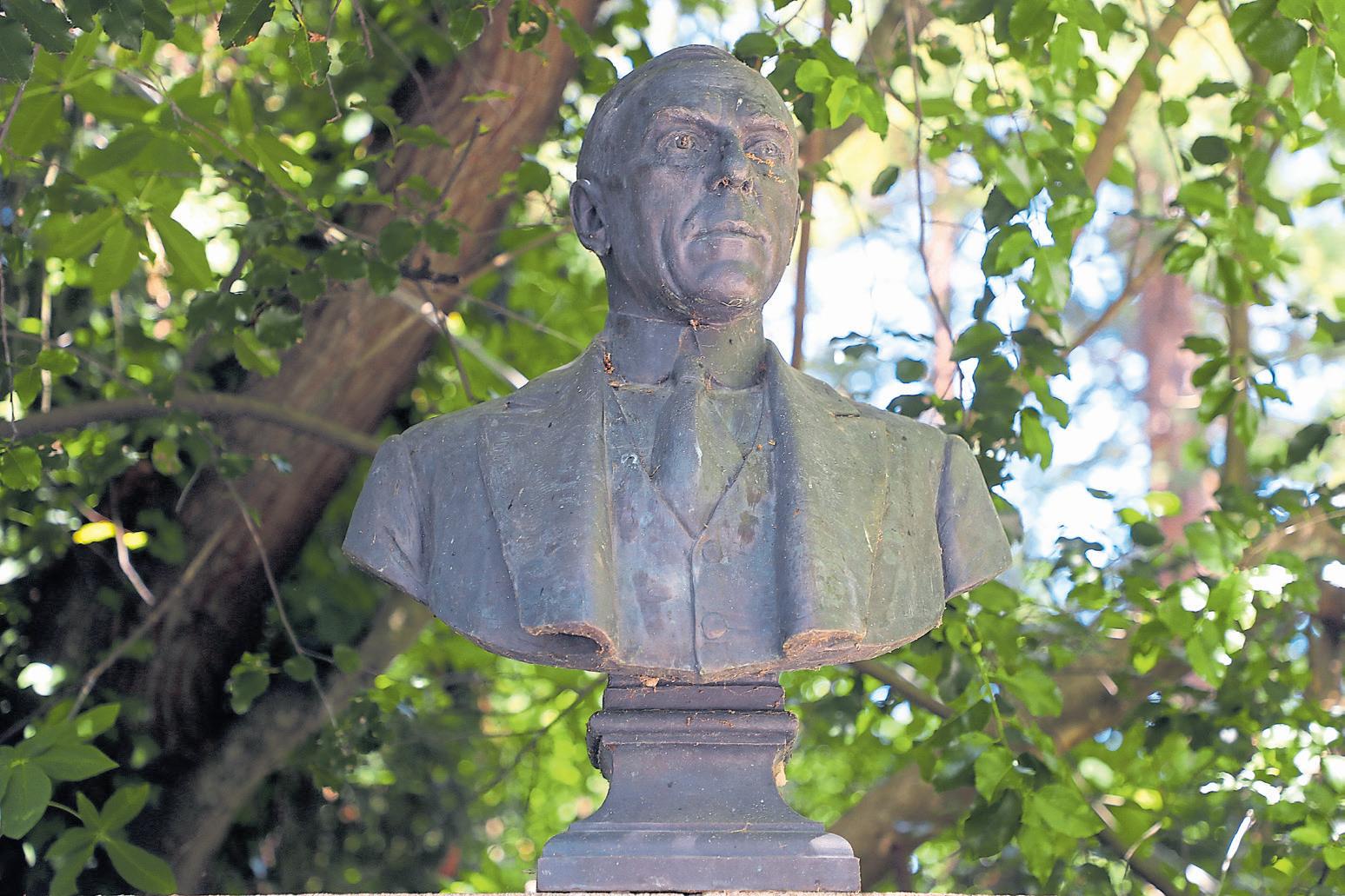
2. Who painted the mural at UC Berkeley’s Stern Hall?
D: Rosalie Stern’s friend Diego Rivera painted it, and the children are Stern’s grandchildren, Rhoda, Peter and Walter Haas. Rivera and his wife, Frida Kahlo, stayed with Stern while Rivera was working on “Allegory of California” at the Pacific Stock Exchange Building in San Francisco.
3. How did the foo dogs at Chinatown’s Dragon Gate get there?
A: The two foo dogs were placed there as protection against harmful spirits about 20 years before the dragon arch was built. Look for them next to San Francisco’s Dragon Gate at Bush Street and Grant Avenue.
4. What’s the meaning of the shape shifting images atop Adobe’s San Jose headquarters at 151 S. Almaden Blvd.?
A: They’re semaphores spelling out a secret message. The first decoded message, which took three months to transmit, was the entire text of Thomas Pynchon’s “The Crying of Lot 49.” Learn more at www.sanjosesemaphore.org.
5. Who did Frank Lloyd Wright design his only San Francisco building for?
B: The Morris family, whose V. C. Morris Gift Shop occupied Wright’s 140 Maiden Lane building for decades. Since then, the property has housed the Xanadu Gallery, Gwyneth Paltrow’s Goop MRKT pop-up and, since 2017, the Italian
men’s fashion store, ISAIA Napoli. At times, the store has more Wright fans visiting than shoppers, but store employees embrace the legacy.
6. Why were the infamous Spirit Poles removed?
C: Although widespread derision and plop artists’ impromptu installations were certainly factors, it was safety concerns over the cracked, weakened poles on Concord Avenue that put the last nail in the coffin.
7. Why do we never see the faces of the weeping female figures that adorn the Palace of Fine Arts colonnade?
A: The Palace of Fine Arts was built for the 1915 Panama-Pacific International Exposition and celebrated, in part, San Francisco’s rise from the ashes of the 1906 earthquake and fire. Designer Bernard Maybeck and sculptor Ulric Ellerhusen wanted the weeping figures to add mystery and evoke a sense of mourning. Their faces have only been seen during the 1915 installation and again during a more recent, massive repair project.
8. What does sculptor Steve Penetti’s Harry Potter-inspired door depict?
A: Penetti used pipes to create seven silver serpents and replicate the entrance to the Chamber of Secrets. The door doesn’t actually open — although you might try speaking Parseltongue to it. You’ll find the door and other examples of Penetti’s work at 2645 Leavenworth St. in San Francisco.
9. What was inside Emma LeDoux’s steamer trunk, now enshrined in Stockton’s Haggin Museum at 1201 N. Pershing Ave.?
D: The body of her third husband. LeDoux, who poisoned him before marrying hubby No. 4, intended to ship the trunk to San Francisco. Instead, it ended up
abandoned on a Stockton train platform. LeDoux, whose second husband also died under mysterious circumstances, was tried for murder and sentenced to death. Her sentence was later commuted to life in prison.
10. Who built the ancient rock walls found from San Jose to Berkeley?
E: No one has yet figured that out. Farmers and ranchers seem the most likely to have constructed them, but you never want to count the Lemurians out.
Opposite: Cadence Desmond, 10, of Concord, participated in a Valentine’s Day 2022 public art project titled “What’s the Power of Love?” at Oakland’s Jack London Square, led by artist Richard Art Felix of Everybody Can Paint.
RAY CHAVEZ/STAFF
70 ARTSY BAY AREA NEWS GROUP
Frank Lloyd Wright’s designs grace several Bay Area buildings, including one in San Francisco and the Maynard Buehler house in Orinda, where this bust of the architect stands. ARIC CRABB/STAFF ARCHIVES
Visitors to Coit Tower take in the Great Depression-era murals, entitled “Aspects of California Life, 1934,” in San Francisco.
D. ROSS CAMERON/STAFF ARCHIVES

Looking for more fun things to do this weekend?
Delivered straight to your inbox every Thursday morning, the free Weekender newsletter offers up seven suggestions for awesome things to do around the Bay Area and at home, from streaming movies and virtual wine tastings to hot new shows, outdoor adventures and road trip inspiration.

72
AREA
ARTSY BAY
NEWS GROUP
Subscribe at https://bayareane.ws/Weekender













 BY JOHN METCALFE
BY JOHN METCALFE







 DAI SUGANO/STAFF
DAI SUGANO/STAFF


 FRANCIS BAKER
FRANCIS BAKER









 STORY BY MARTHA ROSS
PHOTOS BY RAY CHAVEZ
STORY BY MARTHA ROSS
PHOTOS BY RAY CHAVEZ





















 The Mira Tower, a 40-story residential high-rise designed by Chicago-based architect Jeanne Gang, lends a “twist” to the skyline in downtown San Francisco.
KARL MONDON/STAFF
The Mira Tower, a 40-story residential high-rise designed by Chicago-based architect Jeanne Gang, lends a “twist” to the skyline in downtown San Francisco.
KARL MONDON/STAFF













 ARIC CRABB/ STAFF ARCHIVES
ARIC CRABB/ STAFF ARCHIVES


 ERIC RISBERG/ ASSOCIATED PRESS
ERIC RISBERG/ ASSOCIATED PRESS







 RAY CHAVEZ/STAFF
RAY CHAVEZ/STAFF













 ARIC CRABB/STAFF
ARIC CRABB/STAFF





